Humanitas
UNIVERSITY OF CALIFORNIA, IRVINE
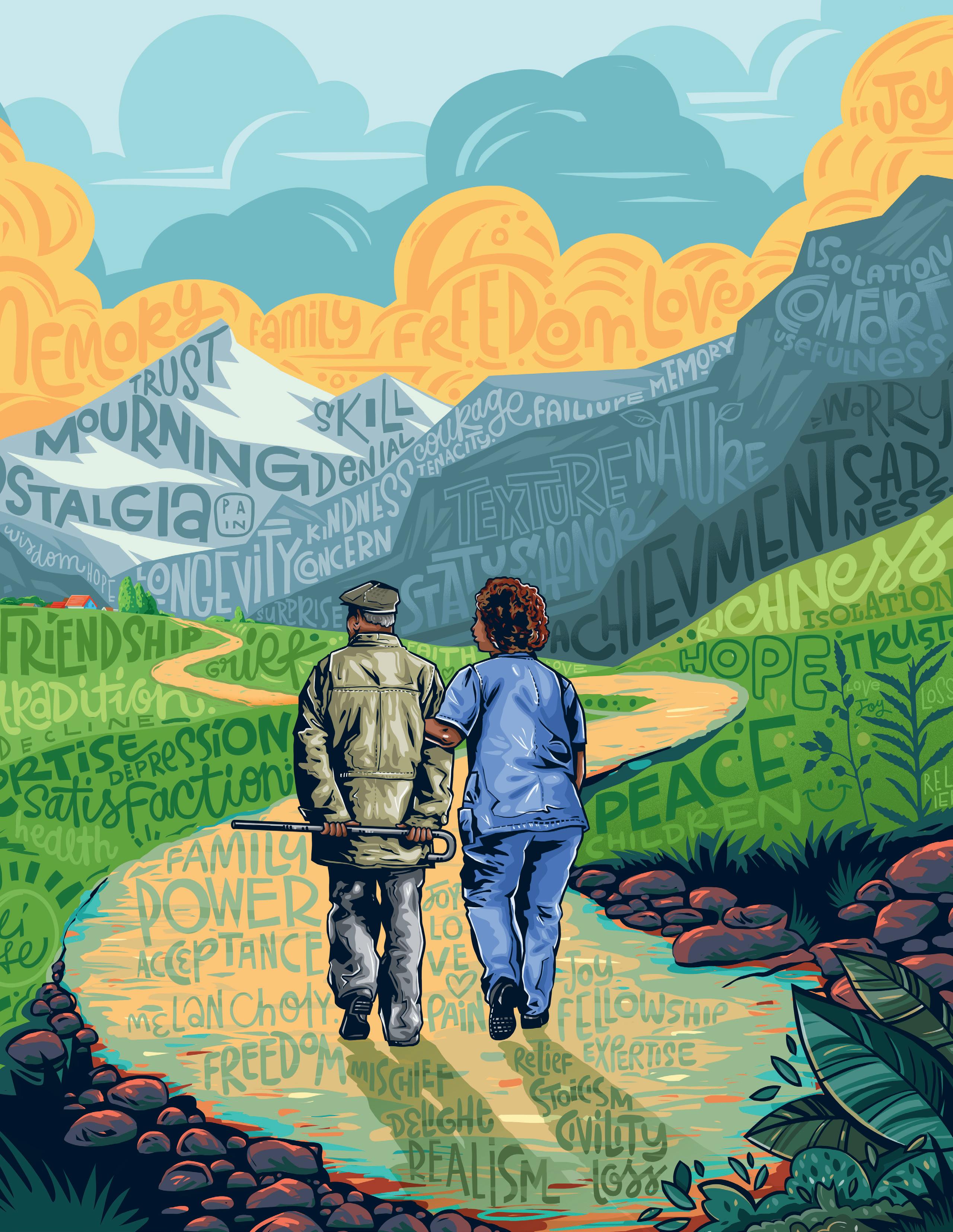
Living it
It’s not age – it’s life
Pages 10-17
Reversing ageism
Nursing’s efforts to tackle an ism that affects us all Pages 18-22
See them, save them
Caring for older people in emergencies Pages 23-27
Spring / Summer 2024
THE SUE & BILL GROSS SCHOOL OF NURSING MAGAZINE

“I will go with thee, and be thy guide, In thy most need to go by thy side.”
from Everyman c. 1530
Humanitas Sue & Bill Gross School of Nursing
Editor Leonie Gombrich
Writers
Dhanika Pineda
Liz Seegert
Nicholas Schou
Leonie Gombrich
Art Director
Pete Friedrich
Illustrators
Dave Homer
Jonathan Rice
Photographers
Carlos Puma
Debra Curran
Fernanado Salazar
Elin Slavick
Steve Zylius
Printing Lithographix
Dean Mark Lazenby
Assistant Dean for Finance & Administration Chuck Villanueva
Director of Communications & Marketing
Debra Curran
Senior
Organizational
Analyst
Kathryn Hoffman
Executive Assistant Dejay Paquillo
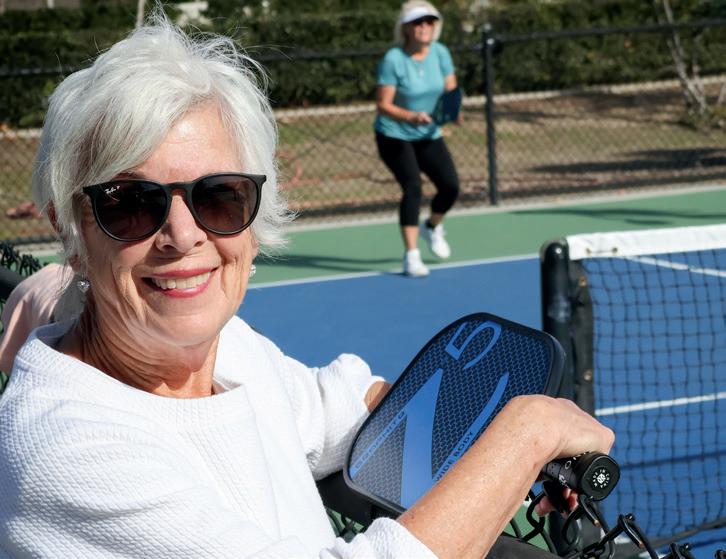
Living it: photostory
What’s in a Day?
Attorney and former nurse
Jennifer R. Johnson makes time to meet us
University of California, Irvine
Sue & Bill Gross Nursing and Health Sciences Hall 854 Health Sciences Road Irvine, CA 92697-3959 nursing.uci.edu
Three friends of nursing give us a view into their continuing lives of service

Reversing ageism
Nursing has a primary role to play in tackling older patients’ most insidious challenge: ageism in healthcare
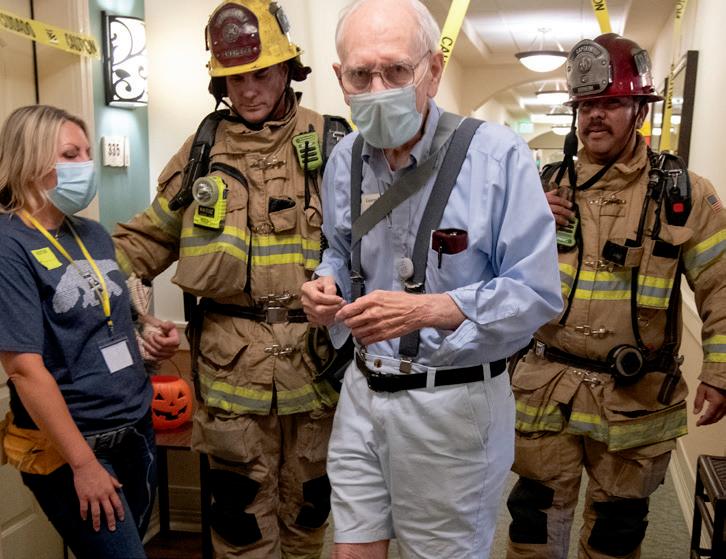
Visible in an emergency
As climate-related incidents increase in rate and severity, the nursing profession insists we prepare to care better for older adults in emergencies 10
Focus on Faculty
The use of wellness techniques and the care of older adults are a potent combination in the work of Assistant Professor Sarah Campbell
In the Community
Professor Jung-Ah Lee’s intervention shines a light into the lives of family caregivers of diverse people with dementia
Happenings
Notable achievements of our faculty, students, and alumni, plus the purpose-built premises of the Sue & Bill Gross School of Nursing are officially opened
Alumni Impact
Two UC Irvine nursing graduates who work with older patients describe their fulfilling careers
18
Magazine
Humanitas
Issue no.
Spring/Summer 2024
3,
23 Features On the cover: Dave Homer’s Everynurse is at an older patient’s side, as together they journey into a landscape of hopes, fears and possibilities.
DEPARTMENTS
1
28 34 43 4 6
NNursing’s promise is to care for people as they would care for themselves, if they were able to do so.
To fulfill this promise, nurses must be alert to each patient’s unique story. They must put aside assumptions and stereotypes, and see beyond vulnerabilities. They must see, in the person they care for, an individual with their own experiences, priorities, attitudes and values, and they must treat them accordingly.
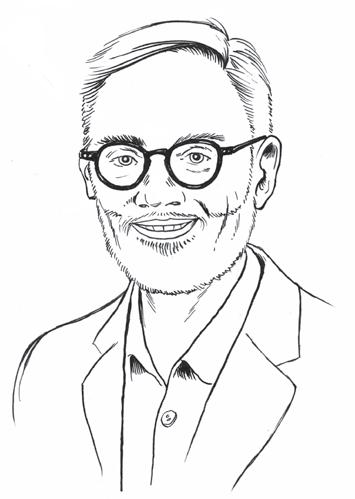 Lazenby, PhD, RN, FAAN Dean and Professor
Lazenby, PhD, RN, FAAN Dean and Professor
This is part of our commitment at the Sue & Bill Gross School of Nursing: our strategic priority to make the invisible, visible.
There are many people for whom the experience of being rendered invisible is all too familiar. People of color know what it is to be at risk of prejudicial assumptions every day. So do people who have suffered pejorative attitudes toward their gender, sexuality, disability or other protected characteristic. And so do we all, as we begin to age.
America is prejudiced against aging. This, despite the fact that our longevity is a triumph of human achievement, and that being older is an entirely natural phase of life.
Our greatest fears associated with age are ill health, loss of loved ones, loss of independence, mental degeneration, and death—but the list goes on. These misfortunes can happen at any age, although they of course become more likely as the years pile up behind us. As we grow older, therefore, our fears are compounded by the fear of becoming identified with such misfortunes, as we were not when we were young. We fear being ignored and unrecognized within an older body, while to ourselves, we remain the people we always were. We fear the invisibility of age.
But we are visible to nurses.
This issue of Humanitas looks at nursing’s role in the positive experience of living long. Our feature article (page 18) confronts ageism, examining how the profession must act against pejorative assumptions and assert the unique humanity of the older patient, for the good of us all.
This strong theme is carried through the work of our clinical faculty (page 6) and the programs of research being driven by both faculty and associates (pages 23 and 28). Our main photo story (page 10) invites you to celebrate, via the activities of three life-long friends of nursing, the enormous value of later life, for the individual and for the world.
Welcome
2 : Humanitas
Mark
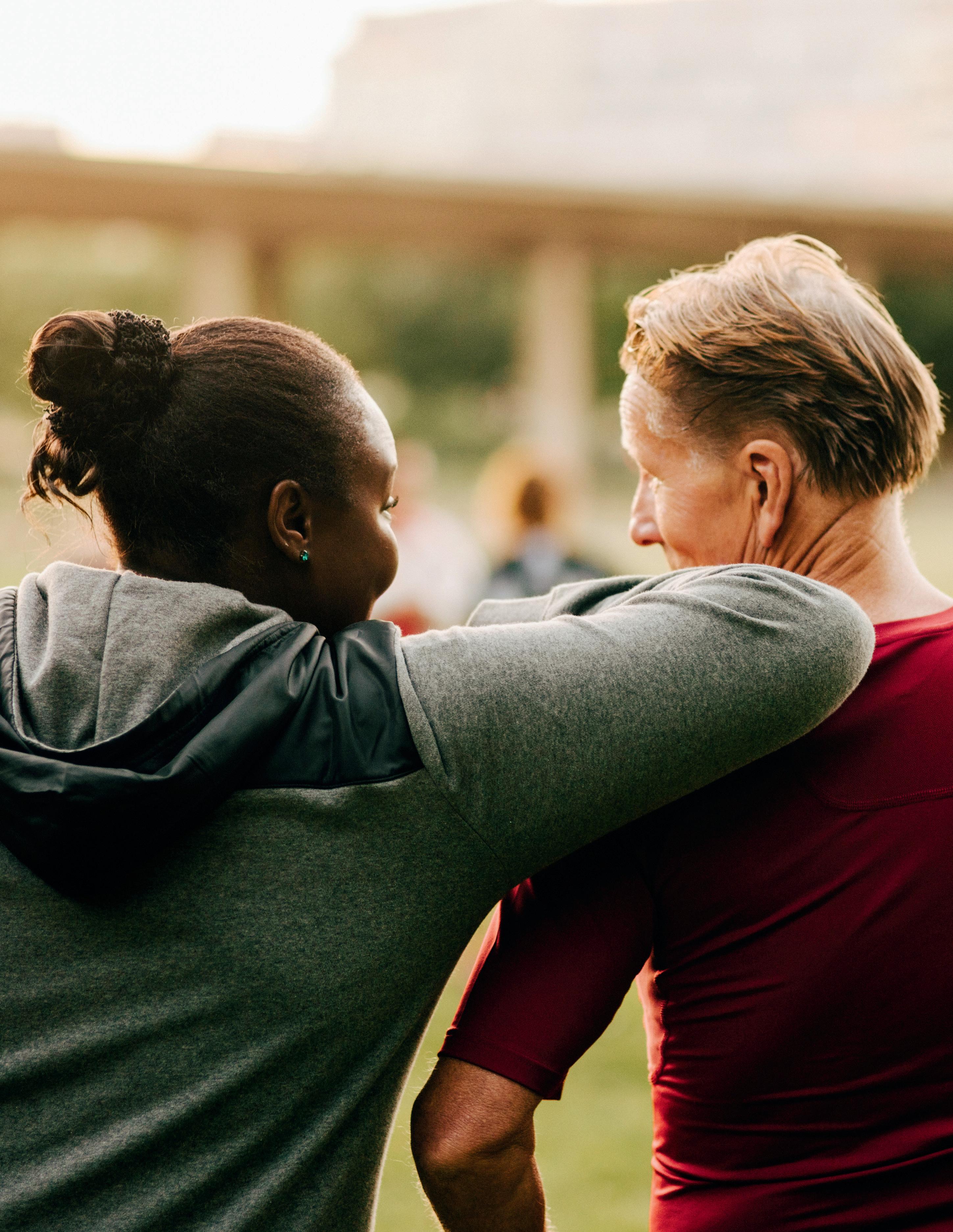
Photo by Maskot / Getty Images Spring/Summer 2024 : 3
What’s in a Day?… Jennifer R. Johnson
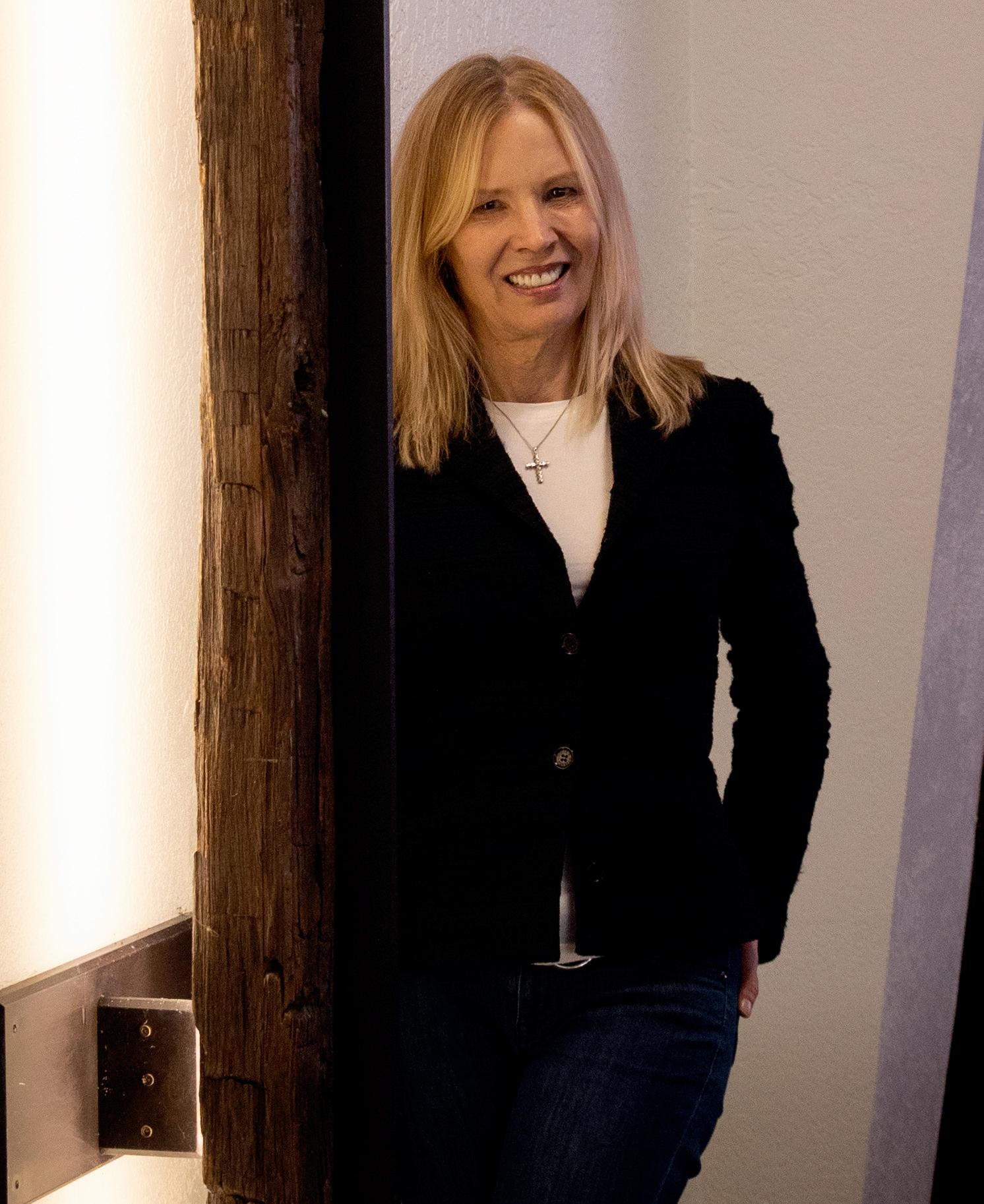
Photo by Carlos Puma
4 : Humanitas
Jennifer R. Johnson is Chair of the Dean’s Advisory Council at the Sue & Bill Gross School of Nursing. A former ICU nurse, Johnson is an attorney specializing in catastrophic personal injury, wrongful death and medical malpractice. She worked for 17 years at two different law firms, first representing medical practitioners and then advocating for patients, before founding her own legal practice, Jennifer Johnson Law, in 2012.
The reason I get out of bed is to have coffee —of course. But the first thing I do, as I swing my legs over the side of the bed, is to say, “God, if I do nothing else today, help me to know and love you better.”
The work I do is heavy, and I need to get my head right and my heart right to do it. I have a morning routine to ground me. I am of the Christian faith, I study the Bible. Each morning I spend time in meditation, prayer or journaling, sometimes combined with a walk. That’s me. It’s not negotiable. If I feel like I’m too busy or I’m overwhelmed, I need to do it more, not less.
Work is literally a two-minute drive. I should walk, but I often need to go on somewhere.
The first thing I do at work is connect with my team. My paralegals will already be at it. I make sure that we’re all good, that everybody’s on the same page and we know what we need to accomplish that day. From there, it’s just a matter of, what are the priorities for the day? Do I have a court appearance? Do I have a deposition for that day? Do I have a discovery?
Selecting the right people to represent is so key. I probably take on one in every 150 cases I look at. I try to keep a steady pace. We’re driven by deadlines, by statutes of limitations, but people also need to be heard. I feel the weight of working with people who’ve lost loved ones or who are injured.
I love to meet people in their own home, especially if they’re elderly or immobile. I could insist they come into my very sterile, beautiful conference room, and sit them down and talk to them about their case. But imagine, if I get into my car and drive to their home, see the pictures on their walls… I’m happy to be there, and I’m welcomed. I haven’t
elevated myself, I’ve come to them, and we have a very different conversation.
I’ll eat at my desk unless I have a lunch meeting or I’m taking the interns out or something. What’s super fun for me as well as meeting clients is meeting the experts—whether it’s placental pathologists or cardiothoracic surgeons. It’s fascinating that I get to interface with these people. I deal with a lot of elderly people in my work with ophthalmology cases: cataracts, retinal surgeons.
As an ICU nurse, I would work with people as they were straddling life and death. What a privilege it is to walk with people during that important piece of life, oftentimes ending in death. It’s not unlike what I get to do as a lawyer. I’m with people who are going through the absolute worst thing they have ever been through. If I can do something good and bring some purpose to their pain…. People can endure a lot if there is a purpose.
Both of my parents invested their lives to serve other people. My father was a minister, very much a country preacher. My mother is a nurse. Together they raised six kids and my father served in two wars. When I got the idea to become an attorney, I really thought: I wonder what skills I learned as a minister’s kid that I can transfer to the practice of law.
I’ve bottled the compassion that I learned as a nurse and brought it into the practice of law, where it’s a little bit of a novel concept. Compassion is a core value, the driving force of my personal and professional life. And it sells. I have to make money so that I can keep my doors open.
The very first case I took, when I started my firm with zero cases, was for a woman in her late seventies. I felt that somebody should do something
about what happened to her so it didn’t happen to someone else. In straight medical malpractice, often people aren’t that interested in representing the elderly because their age means they’re considered of limited economic value. If there’s a case that cries out for justice for an elderly person, I really say to myself, somebody needs to do something about what happened here.
I used to work to exhaustion and that’s how I knew my day was done. That’s not sustainable—I learned. Now my day ends at 6:30 or 7:00p.m. It’s a head and heart thing. I think I’ve managed to create a practice where I’m following my heart and my passion.
If I have had any inherent talent, it’s in music. Piano is my instrument. I always have a piano and I recently started playing the keyboards at my church a couple of times a month, which is completely fun and good for my soul.
I am often in tears over what a client has gone through. The first time I cried at a deposition was because I felt so deeply about my client, a young woman who has passed as a result of cancer. I was so embarrassed. But I have become very comfortable with tears. The day I cannot shed a tear with the people I represent is the day I need to go and work creating widgets or tilling soil.
Spring/Summer 2024 : 5
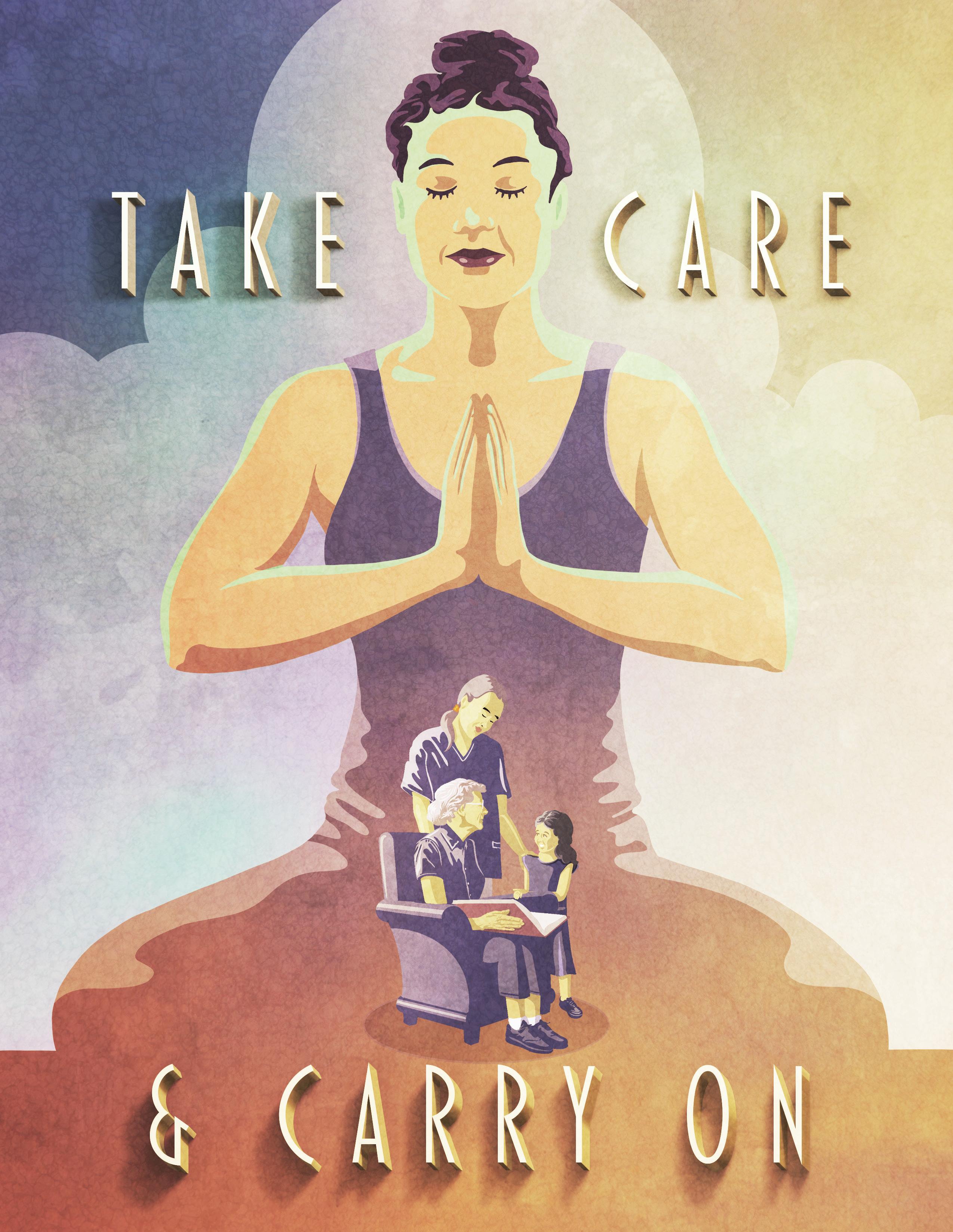 Illustration by Jonathan Rice
Illustration by Jonathan Rice
Focus on Faculty
Iwould love to see integrative and wellness initiatives in older adult care,” says Sarah Campbell, associate clinical professor at the Sue & Bill Gross School of Nursing and assistant director of DNP student wellness and experience for the school. Campbell achieved her Doctor of Nursing Practice from The Ohio State University at the height of the Covid pandemic. In 2020, she implemented a cognitive behavioral therapy program with prelicensure nursing students to see if it could reduce their stress, anxiety and depressive symptoms. At the same time, she recalls, “I was teaching advanced health and physical assessment virtually for the first time, both my parents had strokes seven weeks apart, then my whole family got Covid…I don’t know how I got through it.”
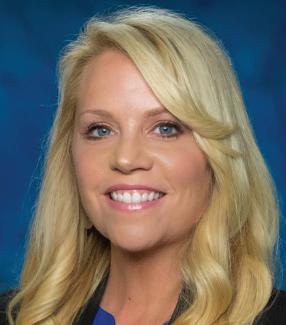
Her DNP study, chaired by her mentor at Ohio State, Dr. Bernadette Melnyk—the first chief wellness officer at any U.S. university —“got remarkable results. Despite the turmoil of the pandemic, participants reported significantly decreased stress and anxiety.”
Campbell “got through it” too. On reflection, she credits the strong support and encouragement of her mentors and colleagues at work, the tolerance of her family—“my husband and children were saints,” she says —and the importance of prioritizing practices such as daily prayer and meditation. “I take the principles I learned during that challenging time as lessons I try to pass on to our DNP students today,” she says.
Spring/Summer 2024 : 7
Associate Clinical Professor Sarah Campbell
Focus on Faculty
At the Student Health Center on the UC Irvine campus, where Campbell has her clinical practice, she is working to build on the success of her DNP study. She explains that the potential of DNP initiatives to have immediate impact continues to motivate her.
“DNPs are leaders at getting research into the field,” she says. “Research typically takes years to be put into practice. DNPs implement it much sooner, which is why we need more DNPs throughout healthcare. DNPs can
students’ perceptions of wellness, and would like eventually to make both physical and mental health programs accessible to students at other schools under the UC Irvine health sciences umbrella. These students are destined to become practitioners and, Campbell argues, will be better able to guide their patients if they understand both the health and the quality-of-life benefits of building resilience and feeling well.
“Provider wellness is key to provider success,” she explains. “Personal experience with wellness
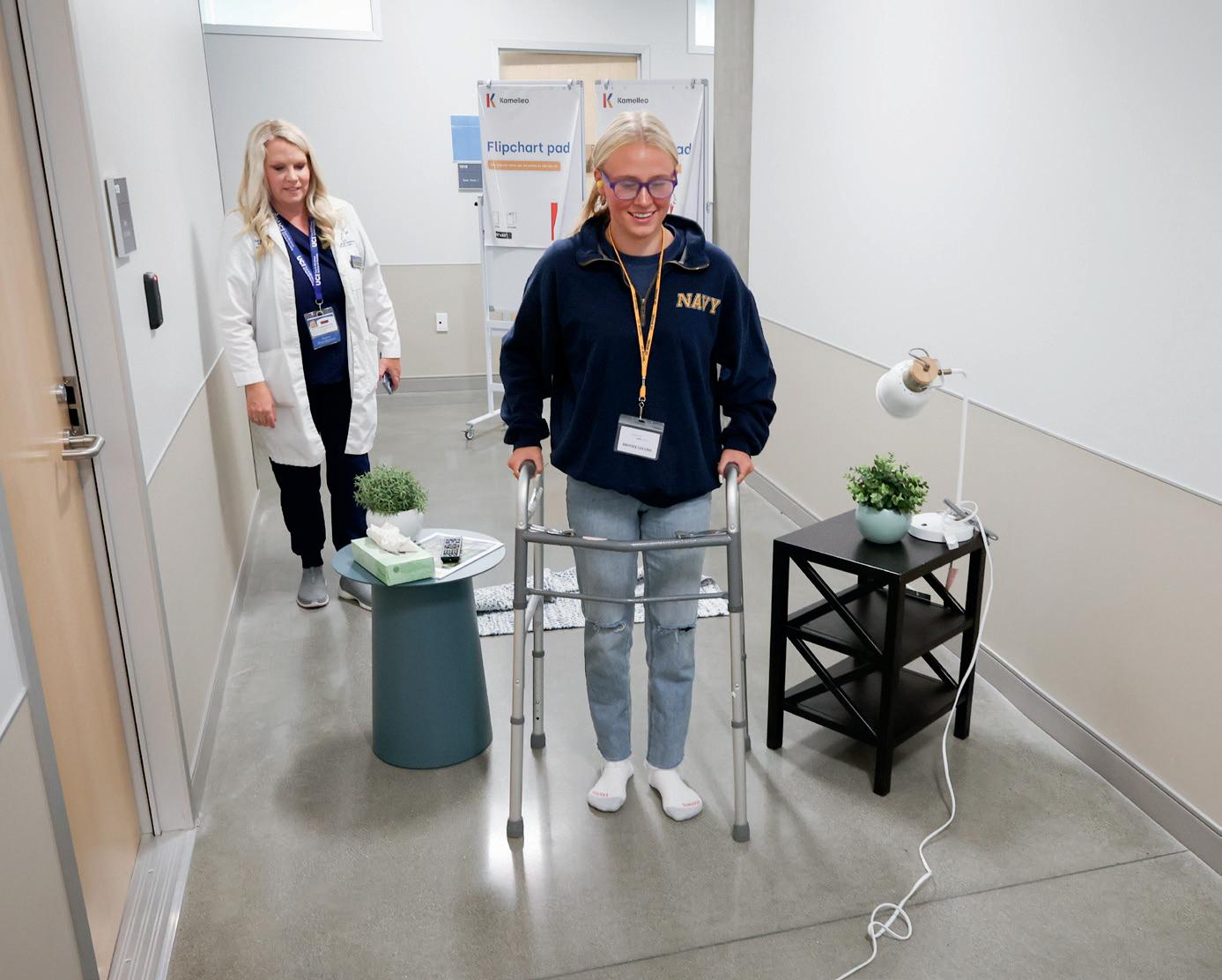
lead and shape policy by applying research findings and making informed, organization-specific recommendations based on appraisal and evidence.”
Changes that Campbell would like to effect include “really solid programs for student wellness in place for our school.” She is seeking to explore the impact of physical (exercise-based) interventions on
techniques gives providers the skills to be proactive in their approach to health.”
Campbell speaks from experience. Before returning to UC Irvine to teach and earn her DNP exam, she worked as a family nurse practitioner in private practice, with a special interest in geriatric health. The nursing of older patients, particularly in the family context,
demands a comprehensive, flexible approach that marries well with the
“Experience with wellness techniques gives providers the skills to be proactive.”
individualized concerns of wellness.
“The most important concept is shared decision making,” she says, describing her work with older patients. “We think we know best but maybe we have no idea what the patient’s values are. Blanket statements for everyone make no sense. Consider asking them, ‘What’s most important to you, day to day? Let’s discuss it—how do we get you there?’ As a provider, you’ve got to get creative sometimes. Don’t waste your breath preaching.”
For Campbell, geriatric care feels personal. “My parents took my grandma in when I was three or four years old,” she says. “She had COPD, and my brother and I were never sheltered from that. It didn’t feel scary, it felt normal. It was, ‘Hey, can you help us with grandma’s oxygen tank?’ And my great aunt had rheumatoid arthritis and diabetes, and was the sweetest, most caring person—despite all that, she used to care for us. I would see her in pain when she didn’t know I was looking. I grew compassionate. I appreciate that my parents did that.
“Older people deserve our very best attention,” she continues. “My question to them is, “How do you want to be the best version of you, and how can I help make that happen?”
Despite her obvious passion for her work, it was not immediately clear to Campbell that she should
Photo by Carlos Puma
8 : Humanitas
Sarah Campbell guides a participant at the Sue & Bill Gross School of Nursing 2023 Nursing Camp in Summer (NCIS) in the experience of negotiating common domestic hazards with a walker.
Photo by Carlos Puma
be a nurse. She began school as a performing arts major before eventually switching to nursing—
floor,” she says. An MS at UC Irvine followed. Her decision to progress to nurse practitioner was spurred
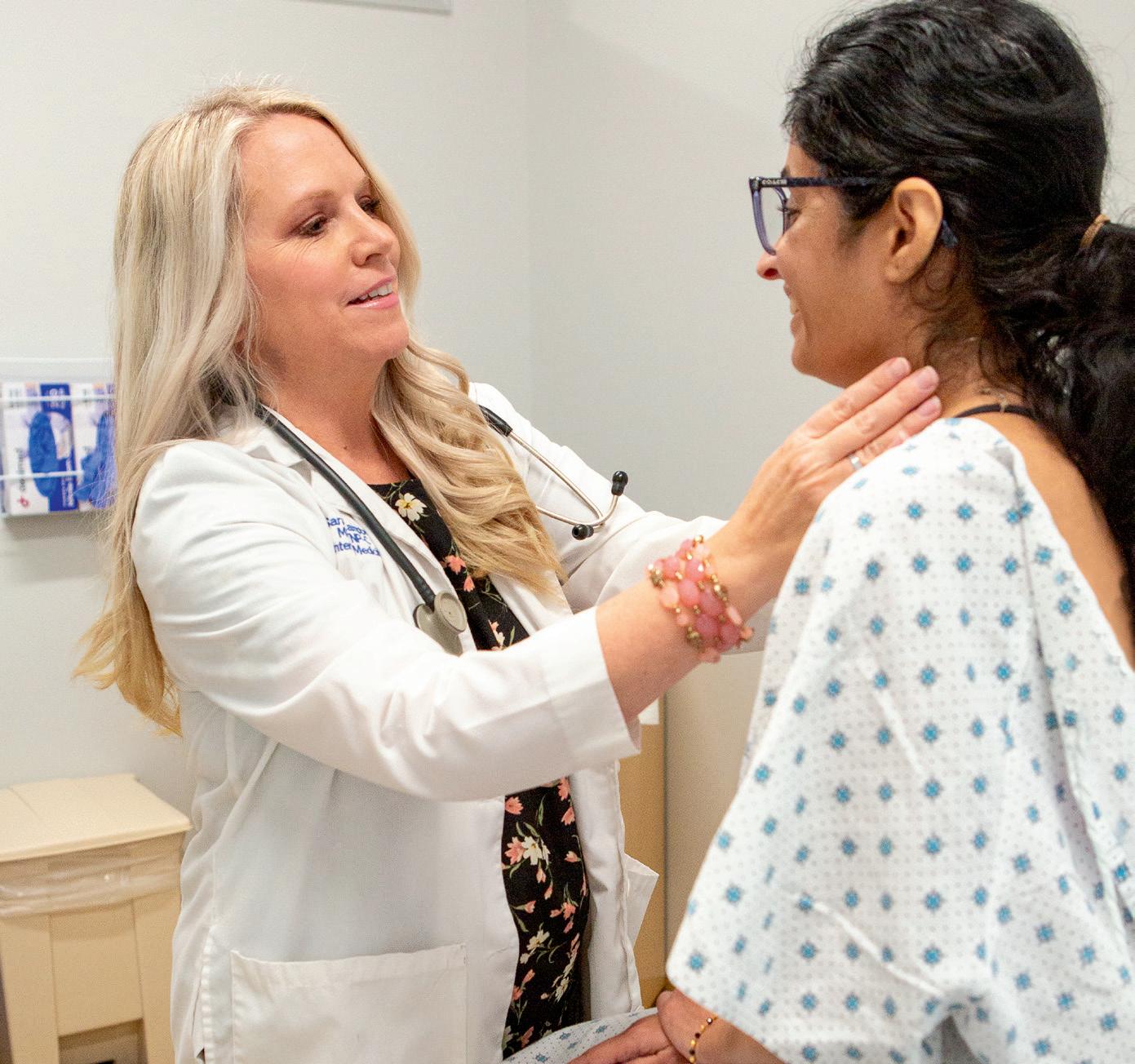
to no-one’s surprise but her own. “My parents said, ‘Thank God!’” she recounts, “because they always thought nursing was for me. But they wanted to let me fly.”
“I would love to see more use of non-pharmacological interventions to reduce geriatric depression and stress.”
After gaining her AS (Nursing) and while taking her BS, Campbell worked as a full-time hospital nurse “on a pretty intense cardiac and renal
by a cardiologist she was working with on a heart failure outpatient program, who pointed out that becoming an NP would allow her to practice independently in an outpatient setting. Returning to UC Irvine in the family nurse practitioner program, she specialized in internal medicine, which allowed her to “see patients aged 12 and up—a grandparent, a parent, a child…I could see familial patterns and I loved that.”
To complete the program she was placed with a “really tough” preceptor, a physician in internal medicine. That experience changed the course of her career.
“I saw how I could work with older adults in private practice,” she says. “I adore older patients. I love what they bring us, I love hearing their stories. Seeing the same patient over and over, developing a relationship with them. I thought, ‘This is it.’ I was done for.”
Campbell took a job at her preceptor’s practice immediately after she graduated. She stayed for six years before embarking on her DNP. Now, a new ambulatory care hospital is due to open at UC Irvine, and Campbell will transition back to care of older adults there. She plans to incorporate her DNP experience into her practice.
“Polypharmacy is a big problem in gerontology,” she points out. “I would love to see more use of non-pharmacological interventions to reduce geriatric depression and stress.”
Use of the term “wellness” has become common in the sale of goods and services that may be unproven and are sometimes expensive. In healthcare, the concept is substantial. It means adopting practices that help maintain a state of mental, spiritual and physical stability such that people enjoy being alive: not just surviving, but thriving. For older people, wellness can be the key difference between a life of fulfillment and one of fear.
“Geriatrics is a complex specialty,” says Campbell. “It takes time. You’ve got to support families making tough decisions; you’ve got to be flexible to what each individual needs. I try to help them be able to delight in their time together, to remind them that everyone deserves joy.”
Campbell teaching nursing students at the Sue & Bill Gross School of Nursing simulation center.
Spring/Summer 2024 : 9
Sarah Campbell spoke to Humanitas editor Leonie Gombrich.

Living It Living

10 : Humanitas

It Living It

Spring/Summer 2024 : 11
Living It
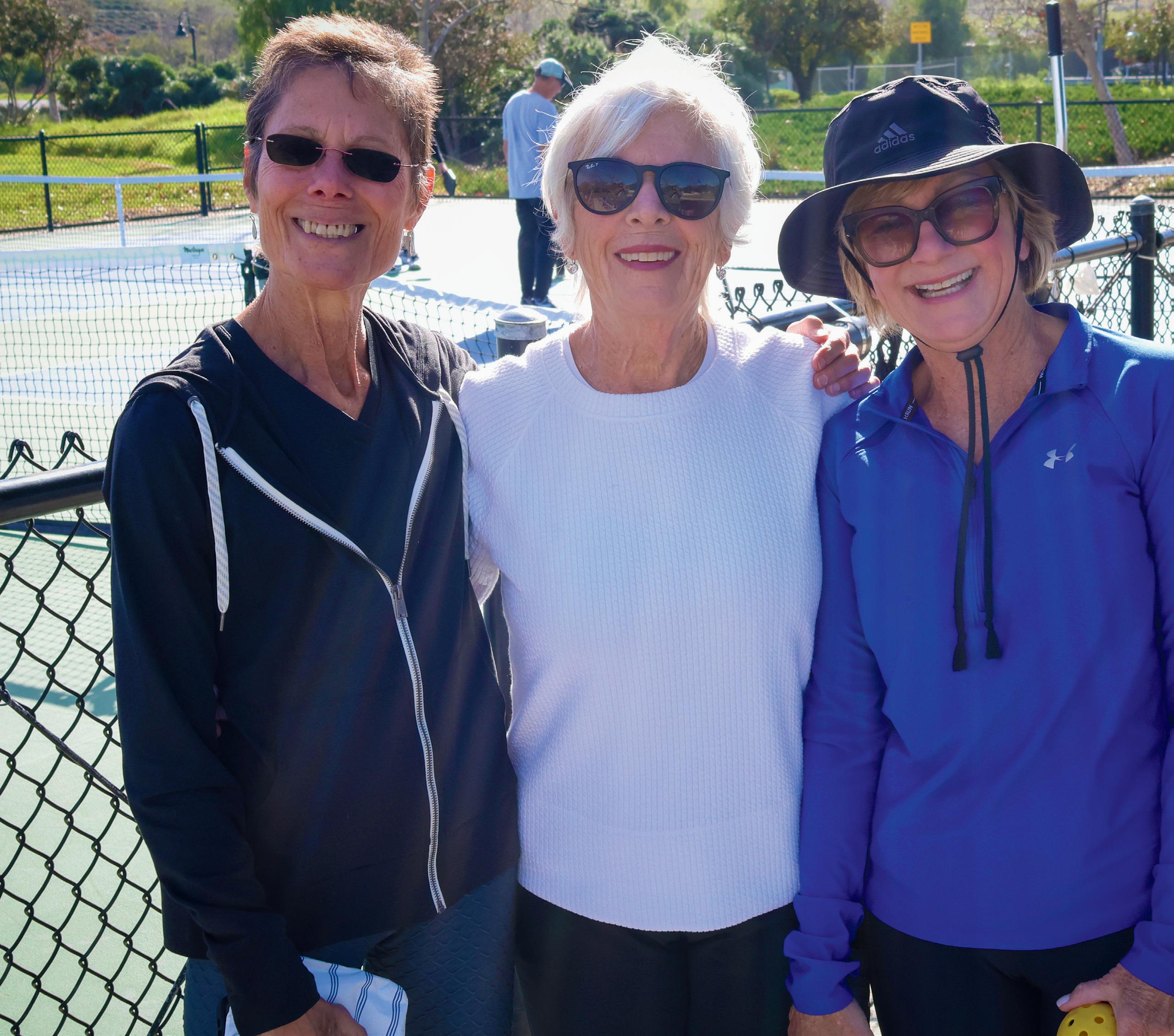
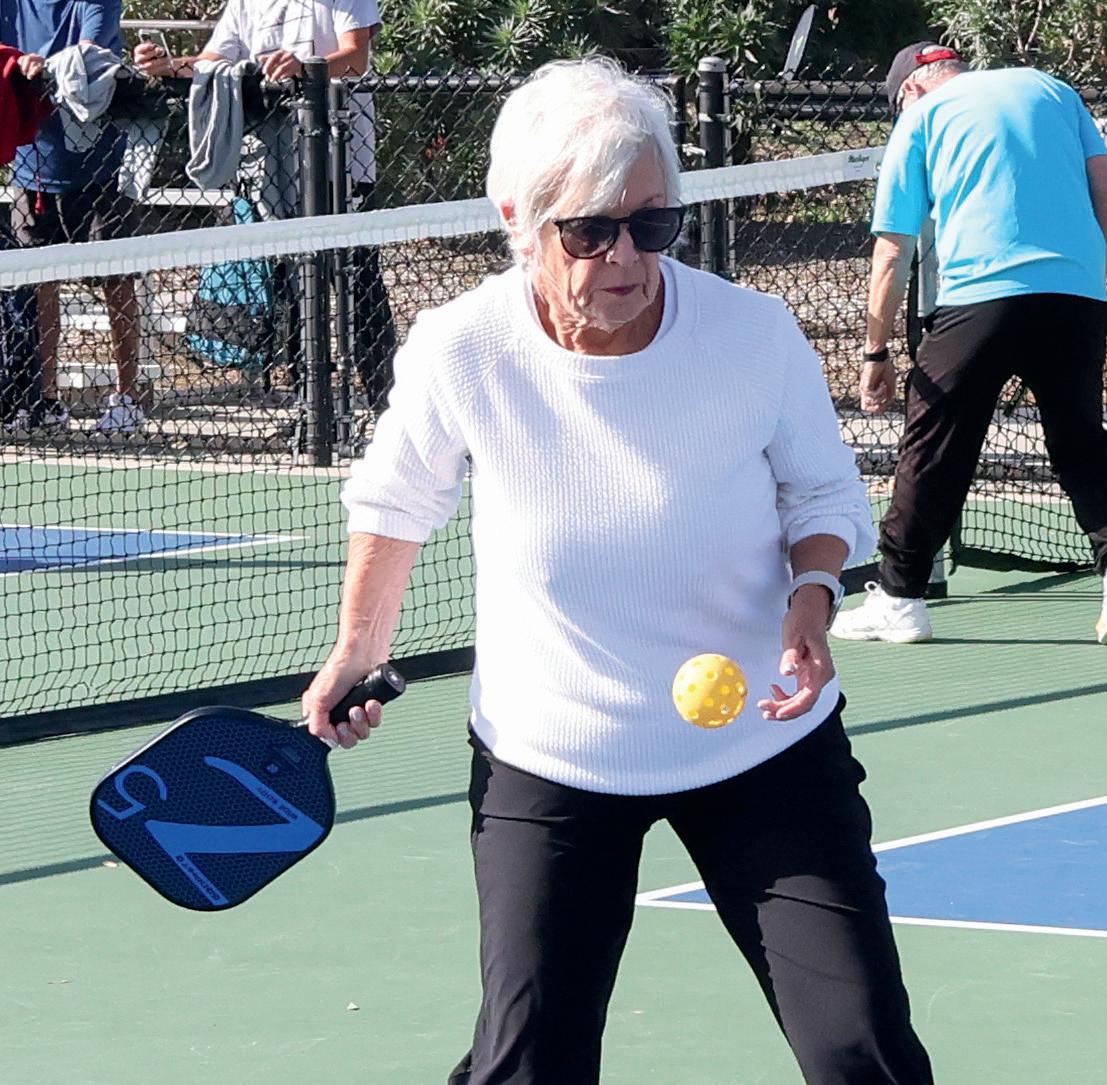
I“kept a napkin I saw at a friend’s house the other day. It says, ‘I thought growing old would take longer.’ That’s how I feel. We all had such frenetic lives. I was raising children, working two jobs, teaching, getting degrees, supporting my firefighter husband, and we had a very active social life. Time went by so fast. Now I have more time to do the things I want to do
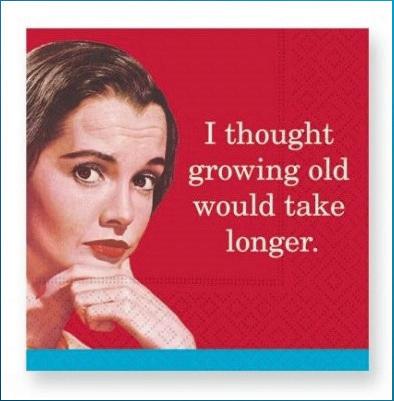
Carol Pierson manages patient care services for ALS United, Orange County chapter. She began her career in 1967 as a critical care nurse and later became a nurse-educator, first in emergency services and, from 1990, in hospitals. After her retirement in 2016, Pierson took up her current role full time, reducing to a three-day week in 2020. She continues to support nursing education by sponsoring student scholarships and equipment purchase at the Sue & Bill Gross School of Nursing, and has arranged a generous bequest in honor of her late mother, Carolene Emrich.
and get to know people in a way I didn’t have a chance to. I’m not bound by so many responsibilities. It’s nice not to worry about job advances. At work, I get a chance to really appreciate my patients more, I spend more time with them. It’s a good time.
When I went to nursing school in 1965, it was very traditional. We stayed in dorms and were not
allowed to be married.
I was a critical care nurse for the army in San Francisco during Vietnam. I earned my bachelor's and master's so I could teach, and moved to Southern California to work with firefighters and paramedics. I married one of my students! I was there the day my best friend was diagnosed with ALS (amyotrophic lateral sclerosis, or Lou Gehrig’s disease), and I was there when she decided not to live any more. I went through that
Photos by Carlos Puma
Pierson with local friends on the pickleball court; she usually plays at least once a week.
12 : Humanitas
Living It
journey with her. In her honor and memory, I joined the ALS Association OC Chapter Board and that is why I work for ALS United now.
For people with ALS, lifespan is two to five years from diagnosis. There’s no prevention and no cure. I work
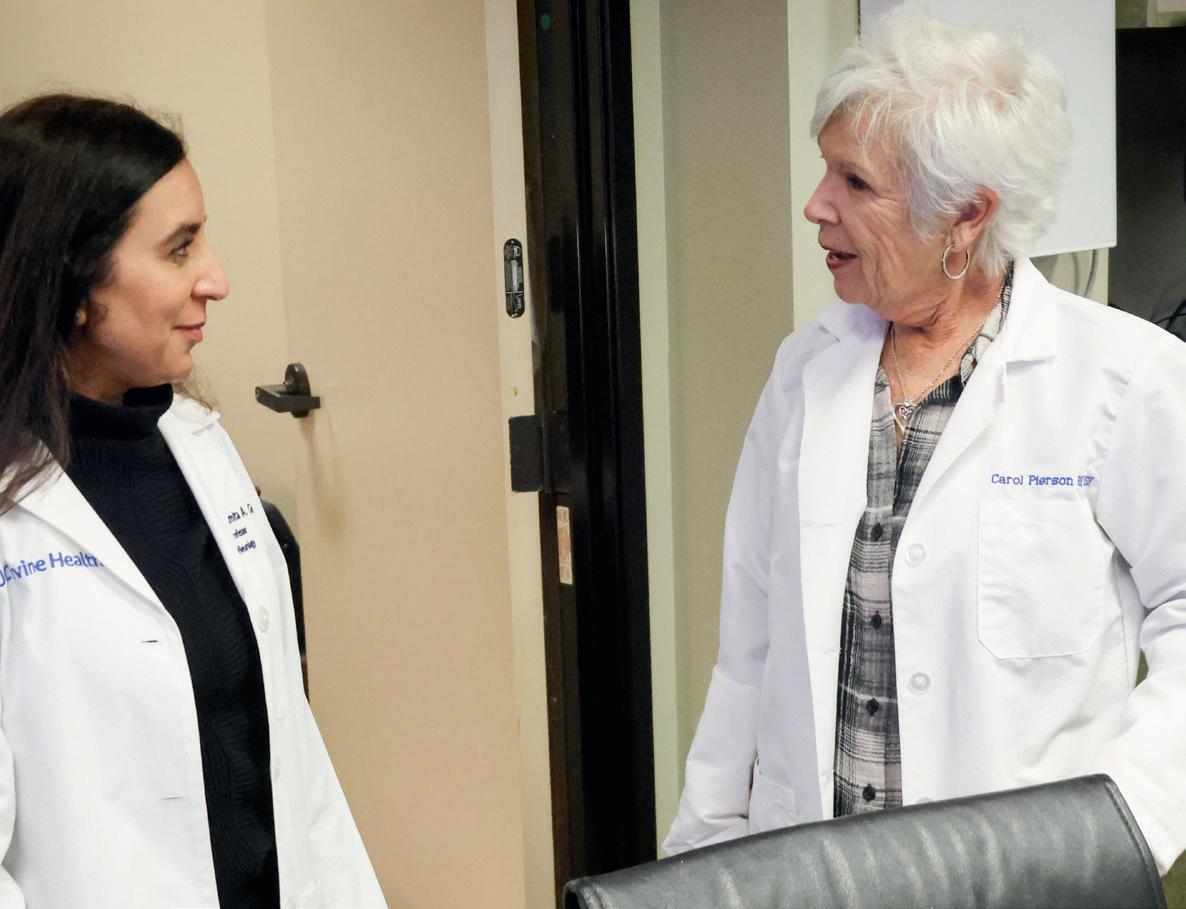
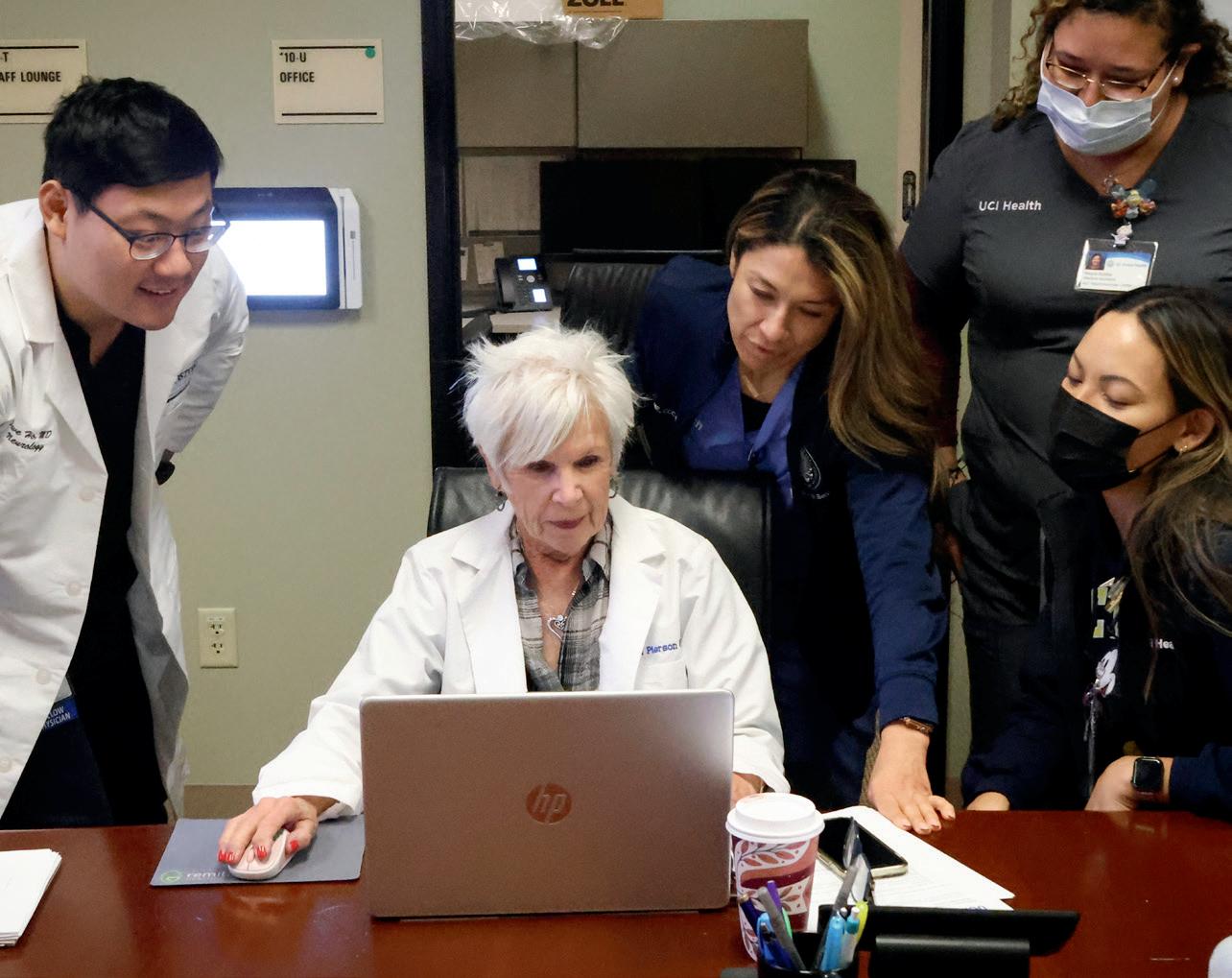
for ALS United for 20 hours a week, seeing patients in the clinic on one of those days. They’re looking for help, for answers—they’re looking for hope. All I can do is give them things that make their life more comfortable, counseling for families, help finding financial resources. In critical care, we’re used to fixing people and seeing them go home. It’s hard not to have that. My mother lived to be 100. I watched her become very lonely after my father died, so that’s frightening to me. I’ve realized with my patients how their faith has gotten them through, or their community.
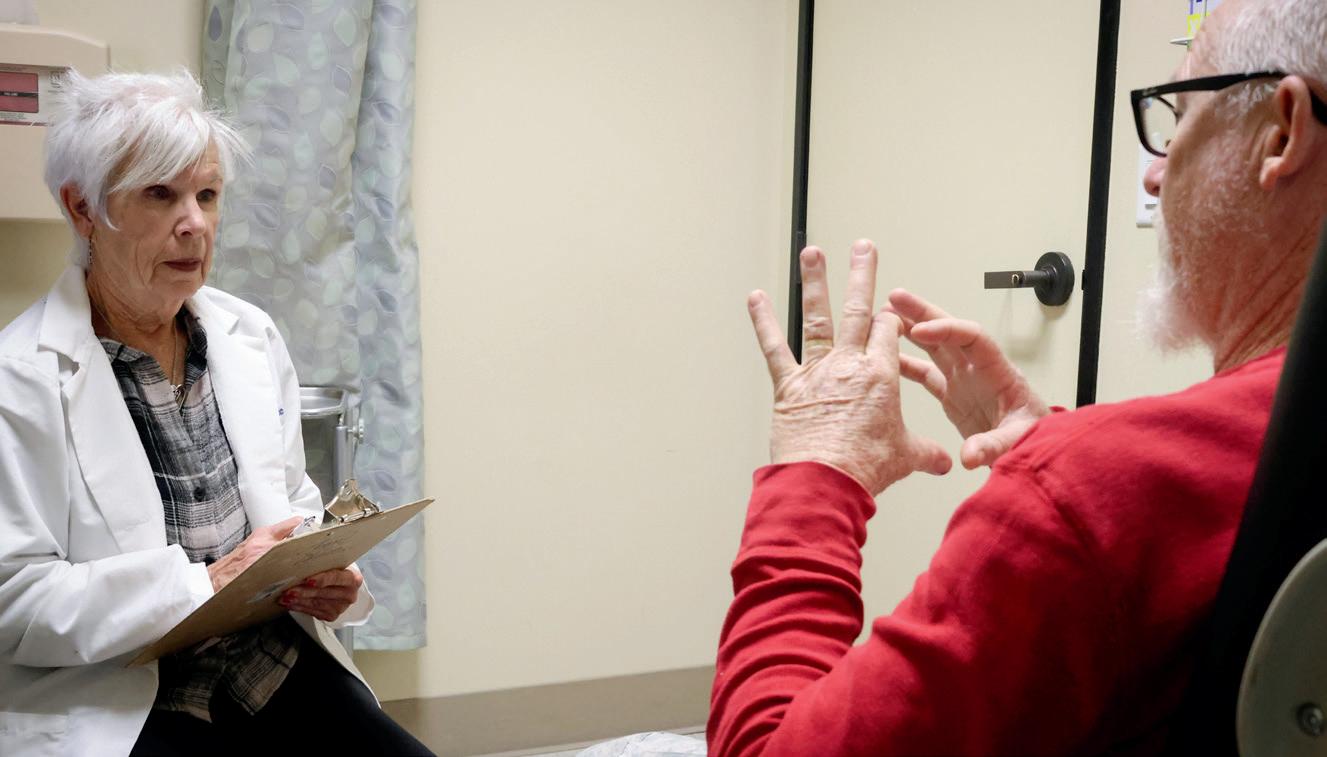
I have an amazing neighborhood and I’m surrounded by so many amazing people: I love mah-jong, I’m in a hiking group, a book club, I play pickleball—pickleball is my enigma. I’m not very good! But we’re here to have fun.”
 Pierson works a day each week at an ALS United integrated clinic, meeting with patients and liaising with colleagues across disciplines.
Pierson works a day each week at an ALS United integrated clinic, meeting with patients and liaising with colleagues across disciplines.
Living It

The Honorable Eileen Moore, JD, sits on the California Court of Appeal, to which she was appointed in 2000 following 11 years as a judge on the Superior Court. She was a combat nurse with the Army Nurse Corps in Vietnam, and continues to support nurses’ education through her role on the Dean’s Advisory Council of the Sue & Bill Gross School of Nursing. Below, she describes the arc of her career in her own words.
I“feel as if my life thus far has been somewhat of a history lesson. I became a nurse in the 1960s, a time when nursing was so much less sophisticated than it is now. I actually wanted to go to college to become a journalist, but my father explained to me that money for college had to be spent on my brothers because I would be getting married and some future husband would take care of me. Long story short, I ended up in the Army Nurse Corps as a combat nurse in Vietnam. Once home again, in the midst of the women’s liberation movement, I grabbed for that brass ring. I enrolled at UC Irvine, which had a special program for
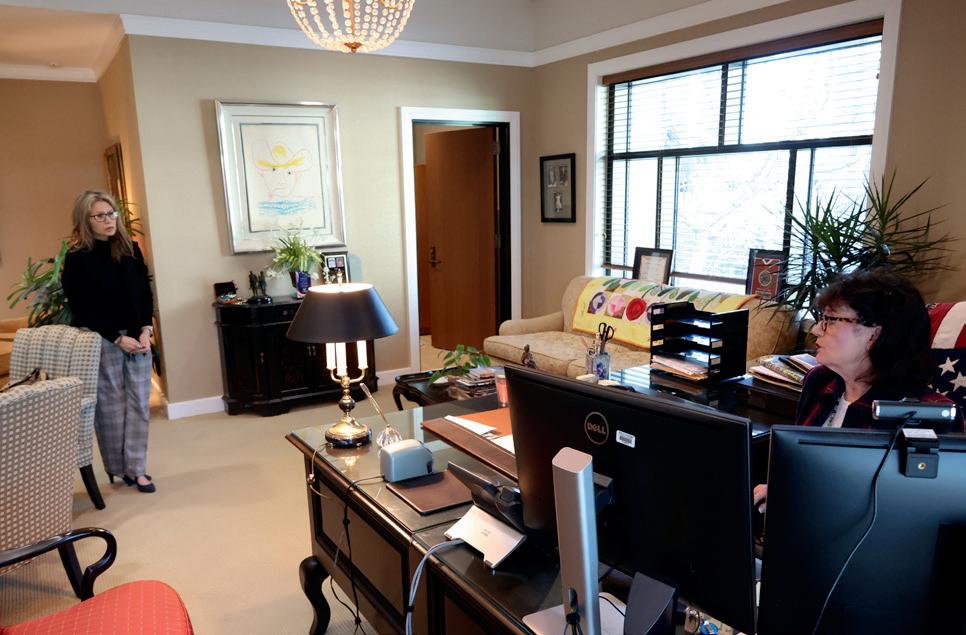
women who were ‘returning’ to college. Up until then, college was a four-year venture, from age 18 to 22. After graduating in 1975, I graduated from Pepperdine University School of Law in 1978. I practiced law, primarily civil litigation, until 1989 when the governor appointed me to the Superior Court. In 2000, another governor appointed me to the California Court of Appeal, where I still sit. In 2004, I graduated from the University of Virginia with a master's in the judicial process, having gone back for six weeks during the summers while doing my work remotely.
Justice Moore with her judicial assistant, Ernestine Alonzo.
by Carlos
Photos
Puma
14 : Humanitas
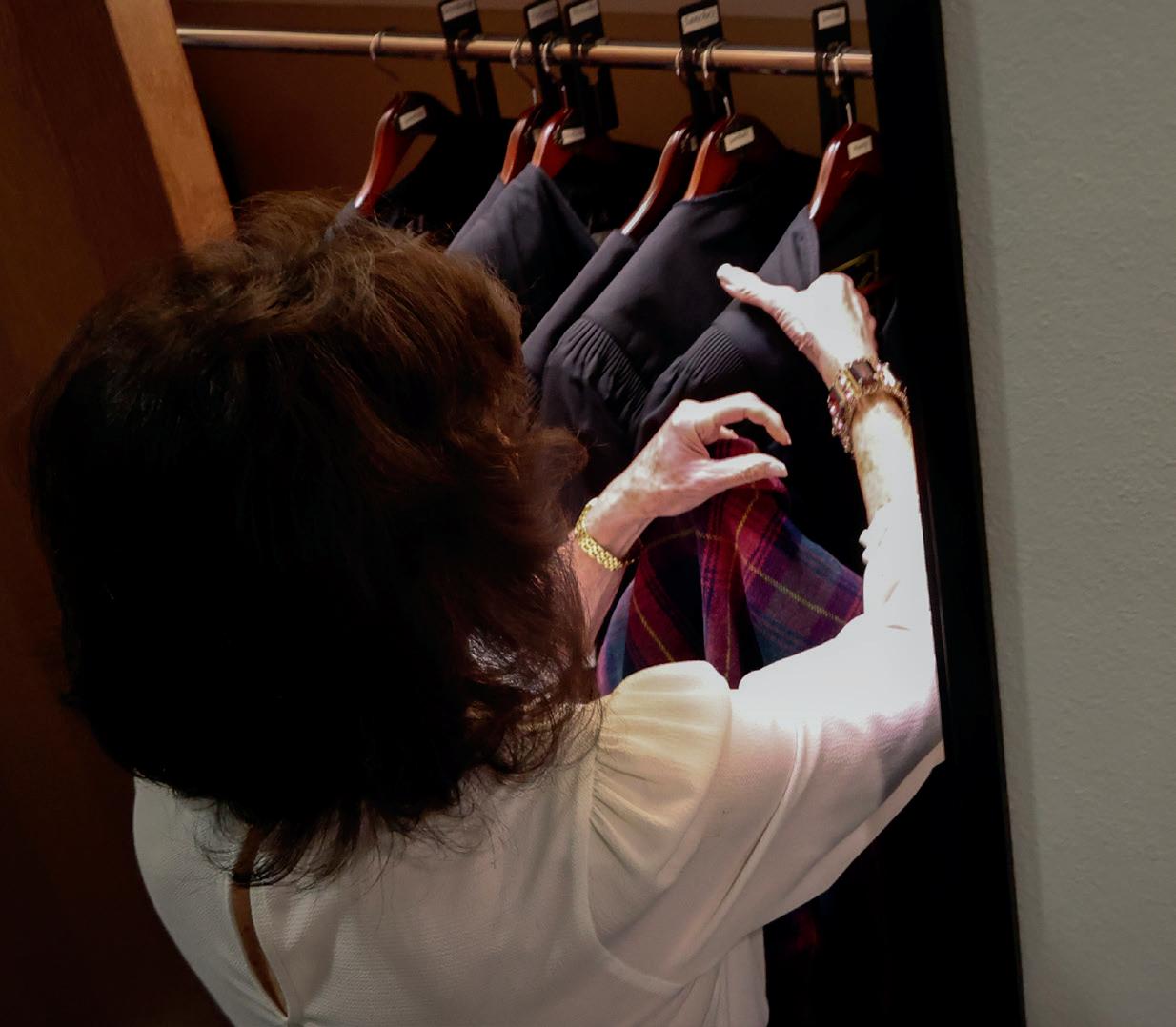
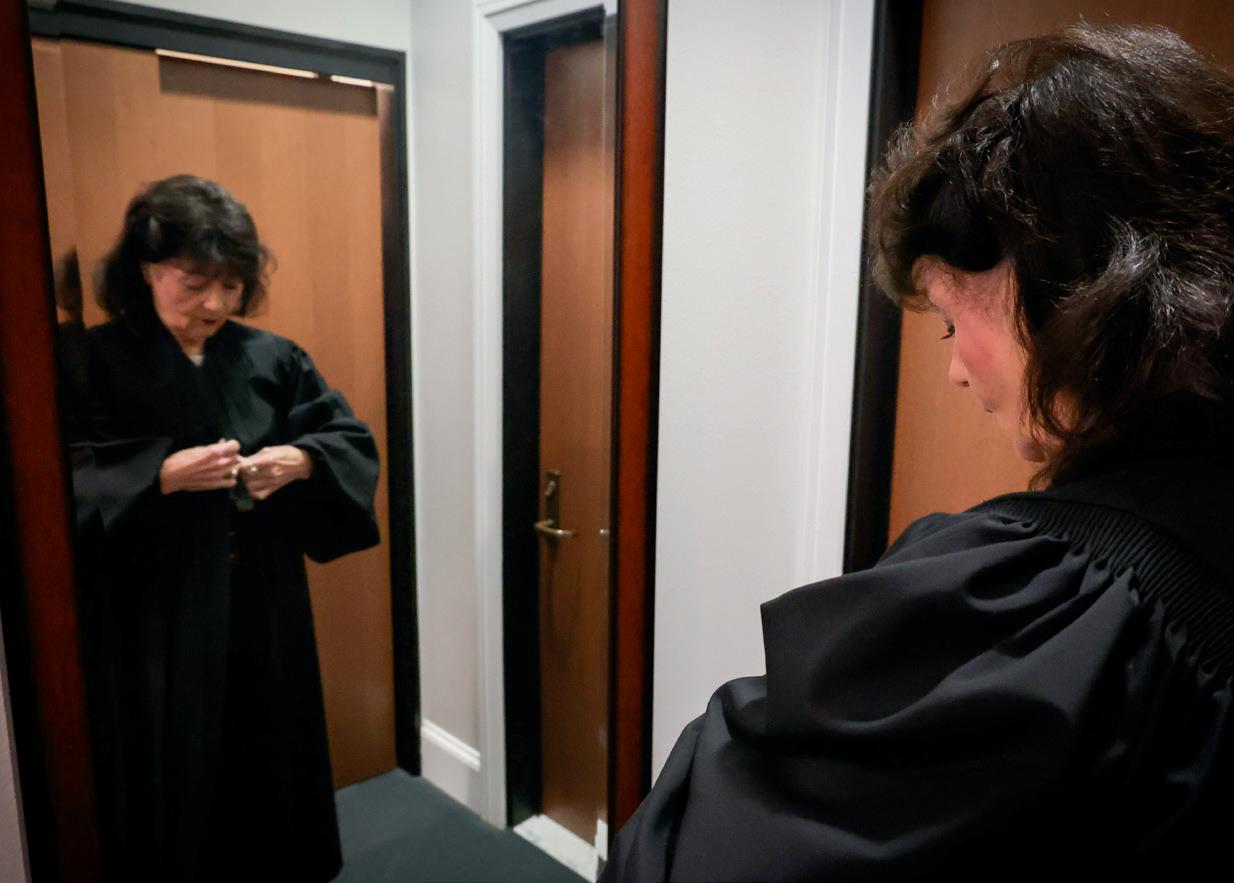
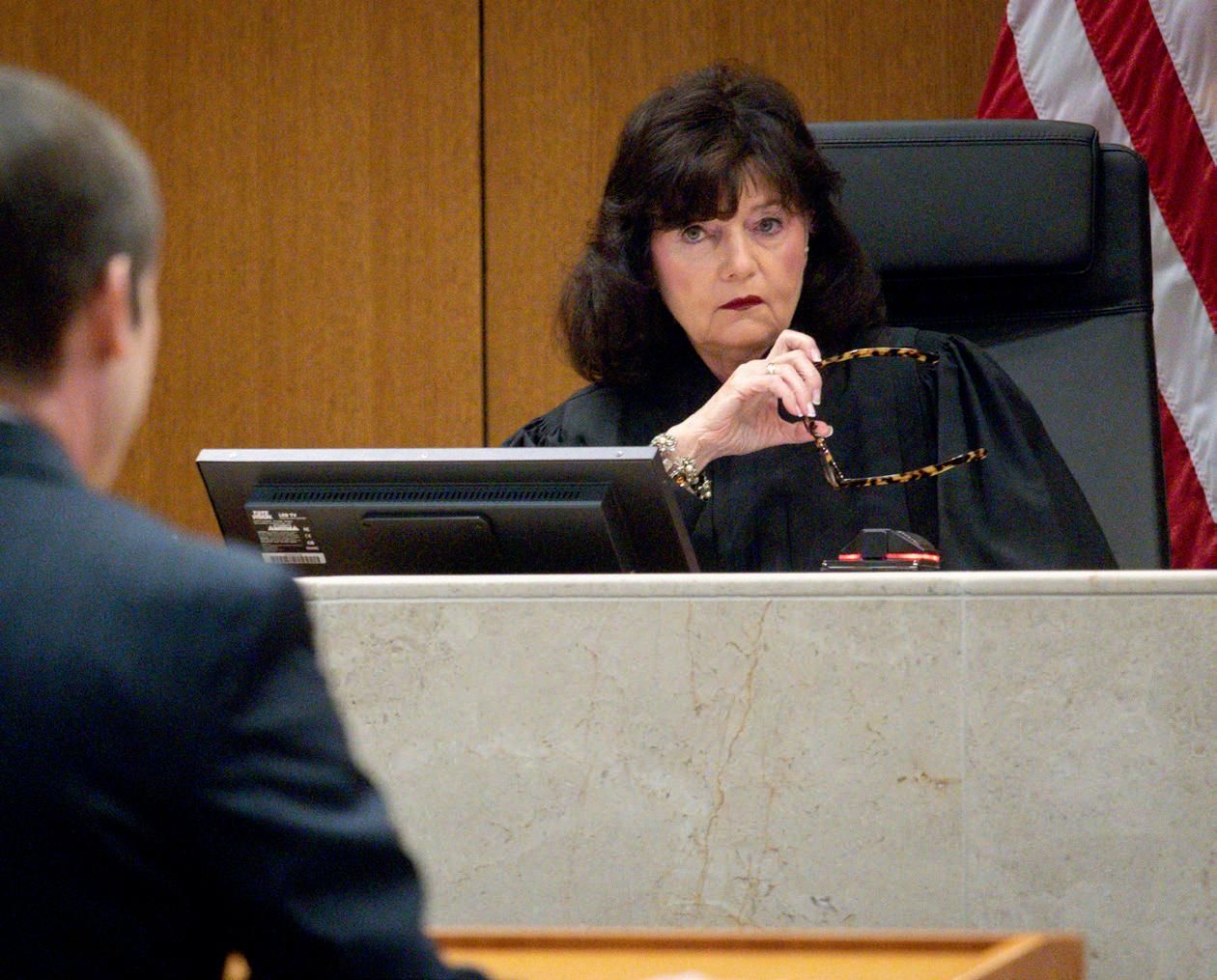
Last November 11, scores of women, mostly nurses who served in Vietnam, gathered for the 30th anniversary of the dedication of the Vietnam Women’s Statue in the National Mall in Washington, D.C. I discovered that other nurses came home and did essentially the same thing I did. One is a lawyer in Arkansas. Another a cardiologist in Arizona. There was a nurse who became a dentist in New Mexico and another who became a writer in New York City. And there was our leader, Diane Carlson Evans, who was almost solely responsible for the statue, having dedicated 11 years of her life to its creation.
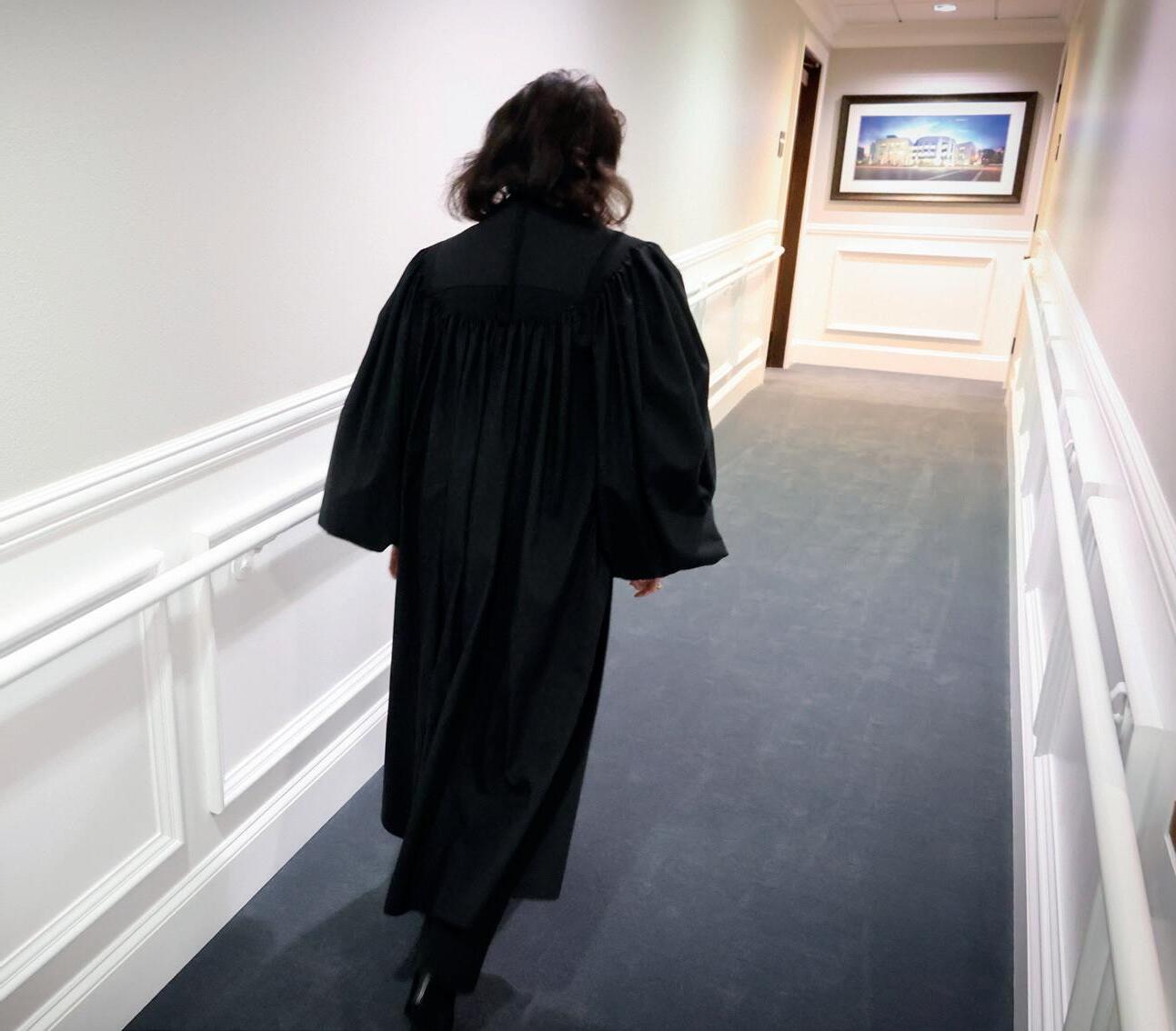
After that event, 12 of us were contacted by The Greatest Generations Foundation. TGGF is taking us back to Vietnam this year. Somehow this has become very important to me. In a way, it is going back to the beginning. As I’ve spent much of my judicial career trying to help veterans who get sideways with the law, I feel as if I need to spend time with these nurses to find out if others question whether they could have or should have done more when we were so young.”
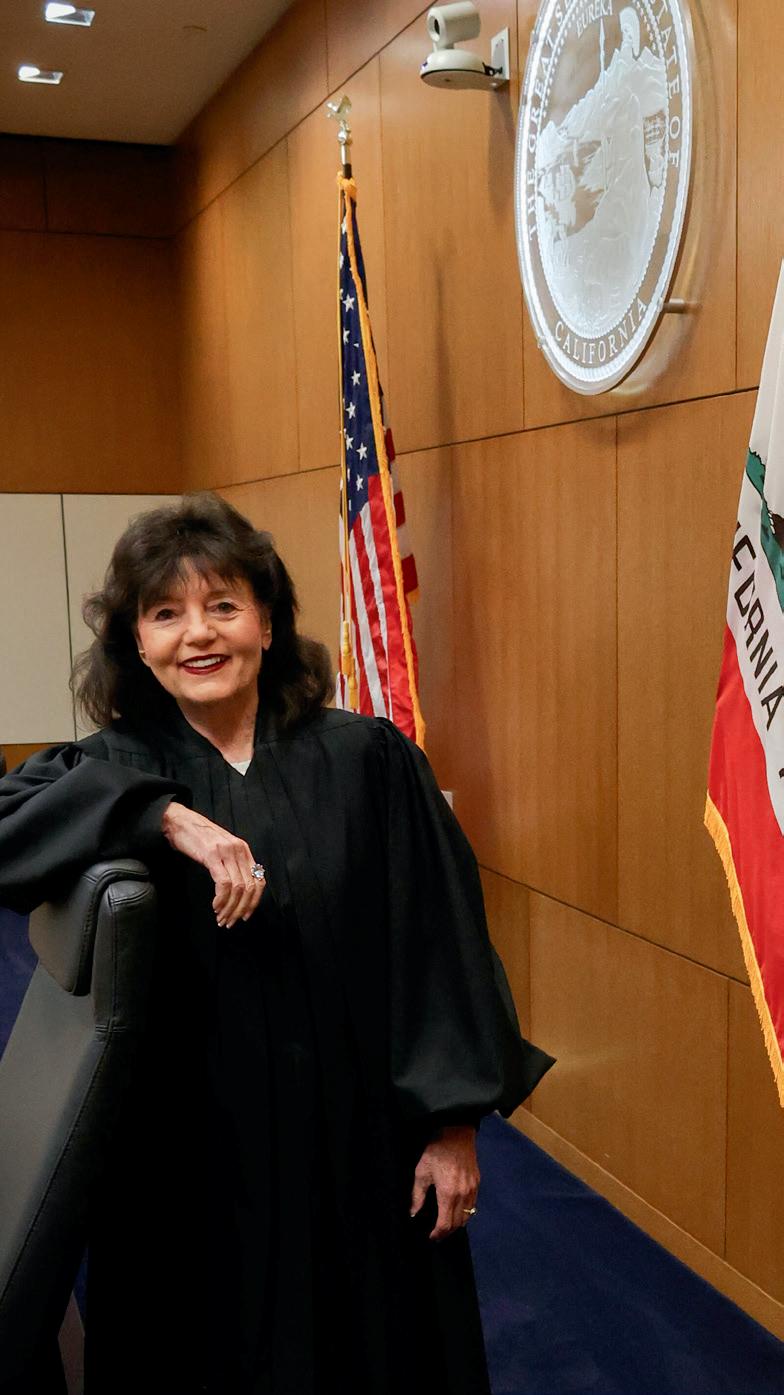
Spring/Summer 2024 : 15
Justice Moore dons her judge’s robes for a session of the California Court of Appeal, Santa Ana.
Living It

Mary Roosevelt is a lifelong educator and advocate for curriculum innovation and teachers’ professional development. She trained as a teacher in London, UK and worked at the International School of Geneva, where she instigated the first elementary years curriculum for what is now the International Baccalaureate. She was then Principal of the Junior House at the United Nations International School in New York, until marriage to James Roosevelt, son of Franklin Delano Roosevelt, took her back to Geneva and, in 1972, to California. After recertifying at UC Irvine, she was immediately offered a job in the university’s department of education, where she remained in a series of influential roles until her retirement in 2002.
by Carlos Puma
I“am truly retired! I’m writing my autobiography for my family—not for publication. I have never thrown away a letter, and I have chronological scrapbooks and copious files. I’m telling the story of my life from Day 1 and I’ve got to 1984. If I don’t finish it, somebody else could.
My first job as a primary school teacher was at probably the worst school in Brixton [London, UK]. It was between the prison and the police station. I had been very well trained at the Froebbel Institute, affiliated with the University of London. We were taught how children learn best through hands-on experiences.
I fought hard to be hired at the International School of Geneva, but I didn’t like the curriculum. We needed an international curriculum; the secondary schools were already ahead on that. The director general said,

“You’re here to make changes.” He sent me all over the world. I visited schools and universities in many
Photos
16 : Humanitas
Living It
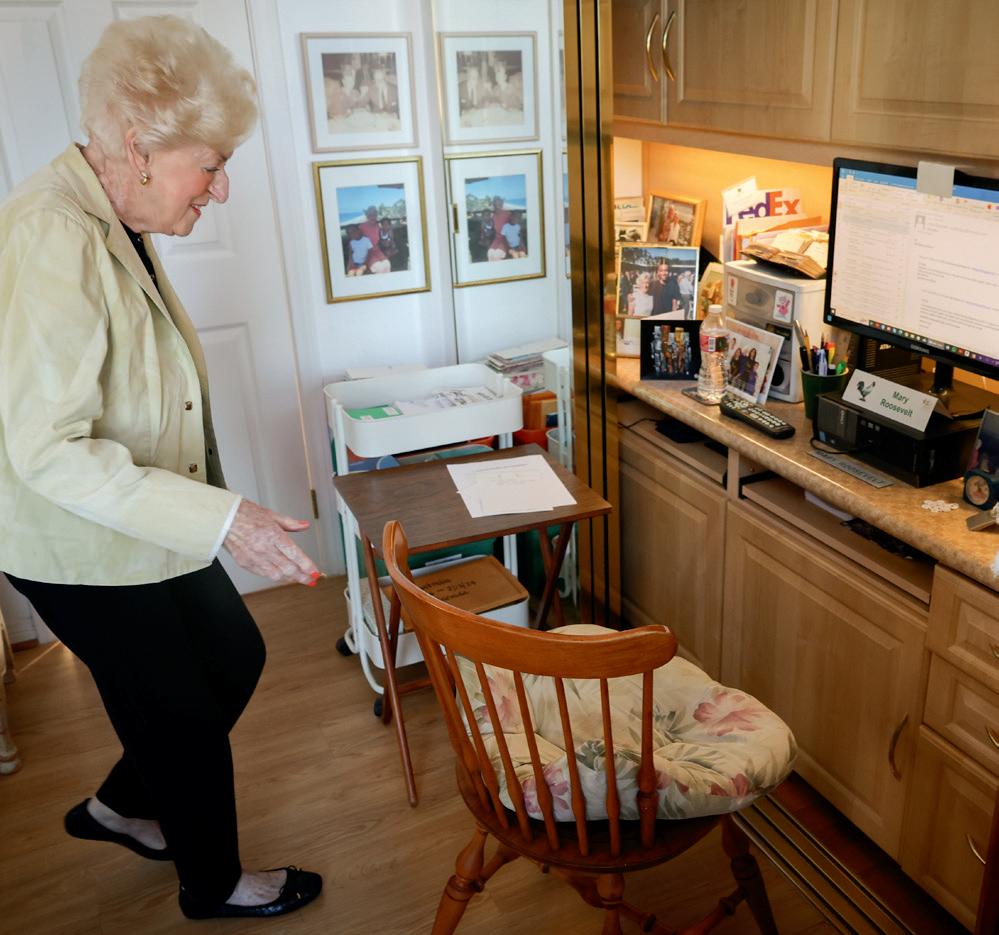
countries to get their feedback, to see what they were doing and where they needed help.
It was a different era. My team and I wrote the first draft of the International Elementary Schools curriculum in 1968. I had one American high school teacher walk me to my car and say, “If you didn’t have red hair and hazel eyes, you wouldn’t be going on all these trips.” I said, “If I don’t do the job, they’re going to fire me. You can’t do anything about that.”
In Africa, I carried the pouch for secret documents for the United Nations Development
Roosevelt at home in California, where she keeps in touch with the numerous organizations she remains associated with, while simultaneously working on an autobiographical record of her life.
ultimately the School of Education). Again I strived to change the teacher education program. I had a family and no intention of working after graduating but they made me an offer I couldn’t refuse.
I’ve survived many surgeries. I rarely feel ill and I am not a fearful person. But I’ve reluctantly given up five-inch heels for kitten heels, because I don’t want to trip.
I’m still involved in a lot of things. I have daily conversations with people from the International School of Geneva. The alumni are incredible. There are thousands all over the world, and they always stay in touch.
I don’t feel any older until I stand up. When I’m sitting down, I’m 20.”
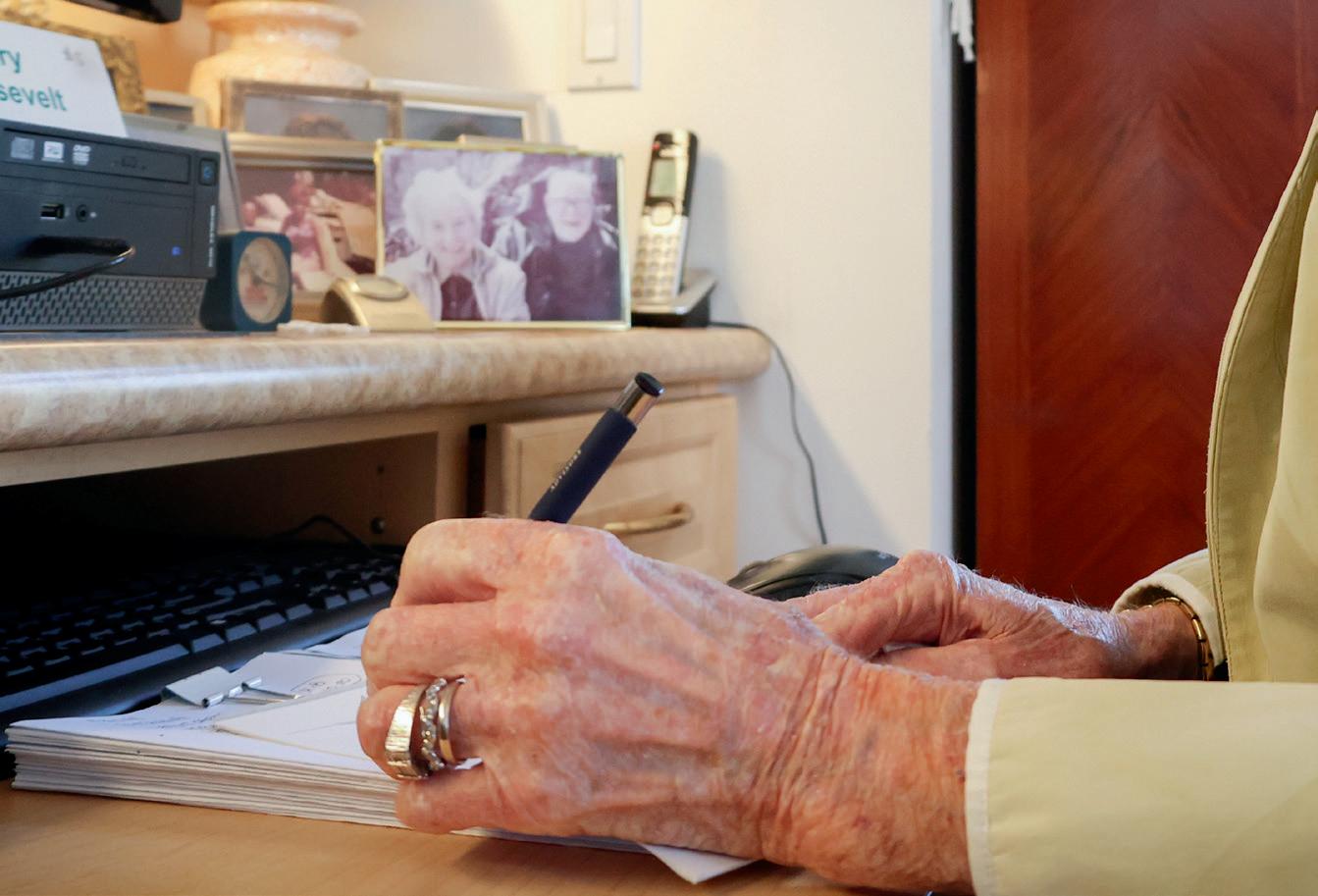
Program. I saw military coups, I saw earthquakes. I never knew what was in that pouch.
UC Irvine was a very young university in 1974 when I got my U.S. teaching certification from the UCI Office of Teacher Education (later the Department and
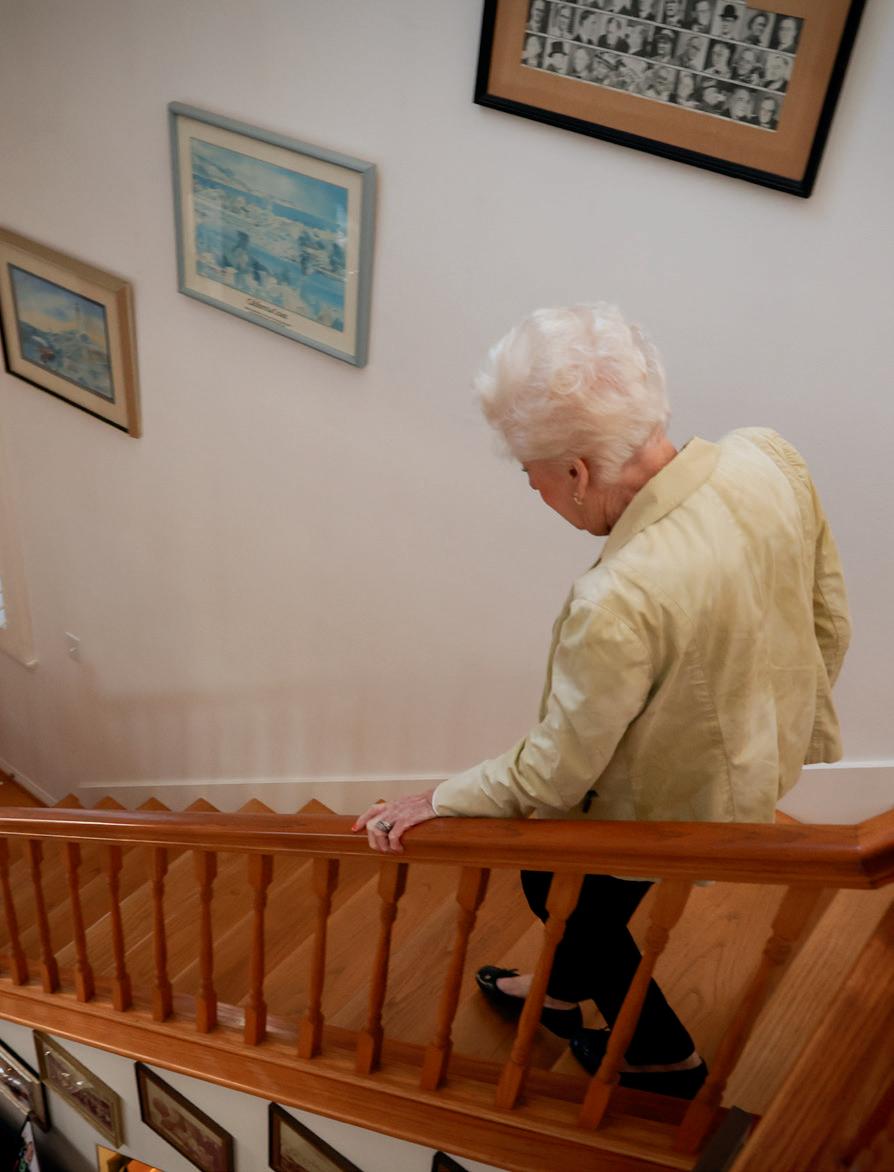 Justice Eileen Moore, Carol Pierson, and Mary Roosevelt spoke with Humanitas editor Leonie Gombrich.
Justice Eileen Moore, Carol Pierson, and Mary Roosevelt spoke with Humanitas editor Leonie Gombrich.

One student, one person, at a time.
Ageism is real and pervasive in healthcare.
And, it comes at a price. It affects older people’s wellbeing, their physical and mental health, and increases the need for and cost of care.
Twenty percent of older patients have reported experiencing ageism in healthcare encounters. A review of the impact of ageism on older people’s health concluded that in 85 percent of the examples, clinicians were less likely to offer procedures and treatments to older people, compared with younger patients, regardless of likelihood of benefit.
Ageism exacts a high financial toll. Researchers found the one-year cost of ageism on overall health for people 60 and older in the U.S. was $63 billion—one of every seven dollars for the eight most expensive health conditions—directly accounting for 17.04 million cases of these conditions. It also increases cardiovascular stress among older people, increases risk of cardiovascular events, and affects a person’s cognitive health.
“When older individuals are randomly assigned to a negativeage-stereotype condition, it impairs health outcomes, such as memory performance and balance, compared to those in a neutral or positive-age-stereotype condition. And when randomly exposed to age discrimination in the form of patronizing speech, they performed significantly worse on a cognitive task than those not exposed to patronizing speech,” notes Yale psychologist and ageism researcher Becca Levy, author of Breaking the Age Code: How Your Beliefs About Aging Determine How Long and Well You Live
institutional ageism because the rules, norms and practices of the institution are longstanding, have become ritualized and are seen as normal.”
However, ageism in healthcare and by health professionals is not inevitable. Studies of ageism among nursing students pointed to nursing’s essential role in elder care, and concluded that nursing professionals’ attitudes and behavior help define the quality of care provided. “Training programs for future care professionals have a responsibility to educate from a non-stereotypical perspective based on current societal needs.”
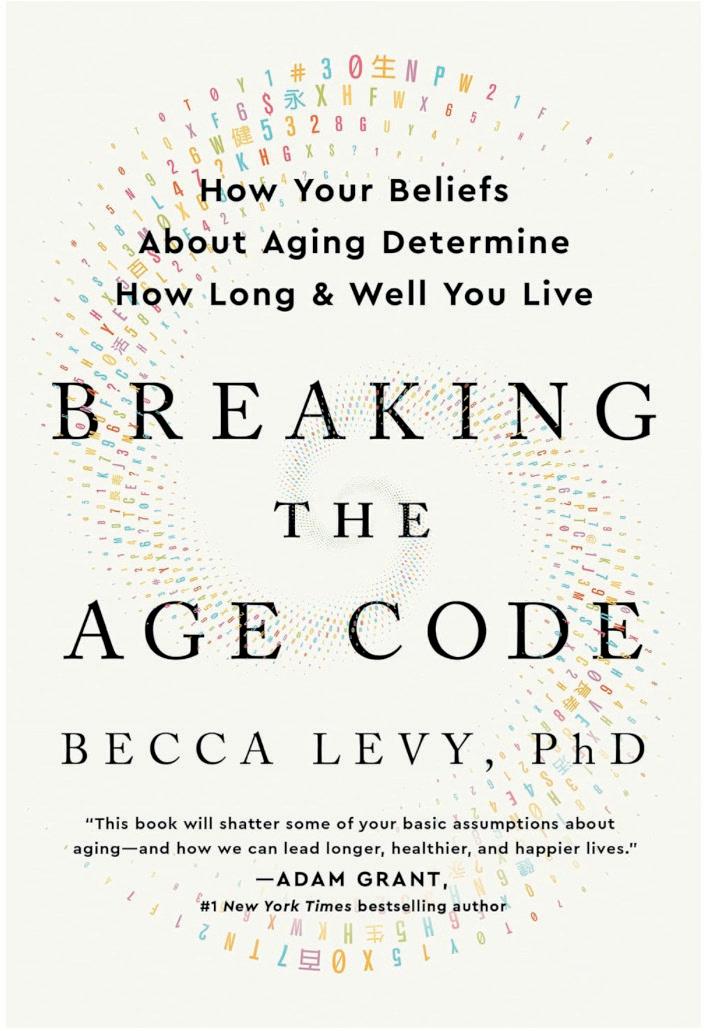
The work of Yale psychologist and ageism researcher Becca Levy has revealed a strong association between our beliefs about aging and how we experience it, including the negative impact of ageism on older people’s quality of life.
CHANGING PERCEPTIONS OF CARE
Camille Fitzpatrick is a retired clinical professor of nursing who taught adult gerontology primary care to nursing and medical students at UC Irvine from 1986 to 2021, originally at the School of Medicine and later at the Sue & Bill Gross School of Nursing. The gerontology concentration is now integral to the school’s Family Nurse Practitioner qualification. Fitzpatrick has been working to change nurses’ perceptions of older people for decades. “Unfortunately, many students don’t see gerontology as sexy,” she says.
A recent World Health Organization report on ageism concludes that, “Often people fail to recognize the existence of such
By Liz Seegert
It’s not as financially lucrative as some other specialties, so someone really needs to have a passion for it. However, gerontology is also incredibly rewarding and challenging because it often involves very complex care. “You look at the older adult as a patient, not an old person, and they have different needs, just like your cardiac patient has different needs than someone who is physically fit and active,” she explains.
Spring/Summer 2024 : 19
Reversing Ageism
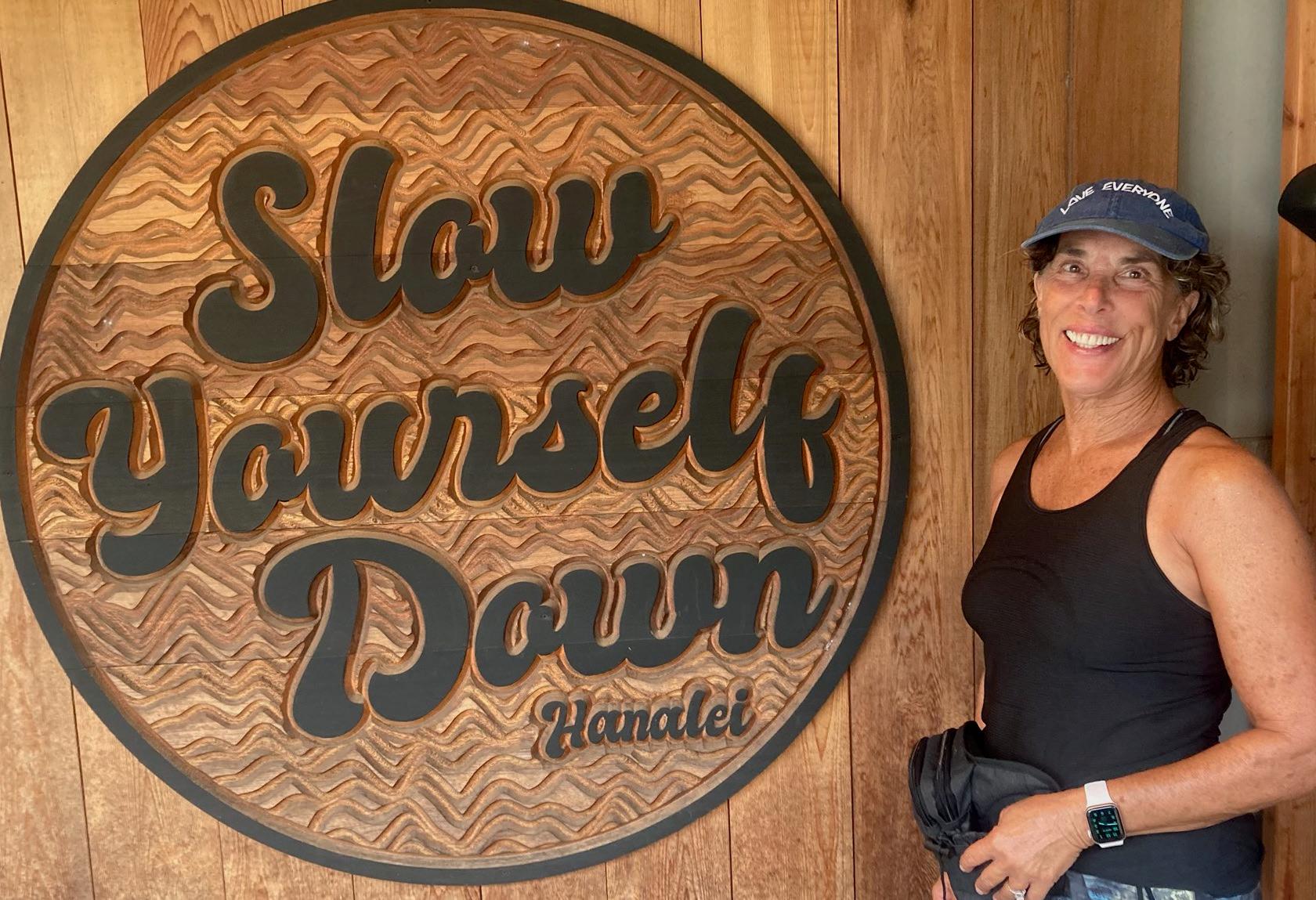
other professionals coming into the field,” she says.
Flaherty believes that nurse educators “absolutely” must be training students in geriatrics, because more training and education leads to more people thinking about what a career in this field might look like.
medical and nursing professionals to take up the mantle of geriatrics. Fitzpatrick, who now lives in San Diego and volunteers her knowledge of geriatrics in support of San Diego County’s Medical Corps Services, said she always encountered students who described the profound impact an older person, usually a grandparent, had on their lives, which prompted them to concentrate in aging.
Other nurse leaders are also doing their part to combat ageism. Ellen Flaherty, vice president of the Dartmouth Health Geriatric Center of Excellence, and a past president of the American Geriatrics Society, has spent much of her career helping early-career nurses reframe their perceptions about caring for aging patients. Flaherty’s research and practice focuses on an interprofessional approach to primary care through the Geriatric
Dartmouth is working to get more students interested in the field of gerontological nursing through modules around end-of-life care, and having conversations about serious illness, all the while trying to stay person-centered at every step. “There’s tremendous opportunity to really get to understand what does matter most to older adults,” Flaherty explains.
FINDING A CONNECTION WITH OLDER PEOPLE
“One of the best aspects of geriatric care is how interdisciplinary it is.”
Interprofessional Team Transformation in Primary Care (GITT-PC) model using the Age-Friendly Health Systems framework.
“I tell them one of the reasons we love geriatrics is that it’s peeling the onion. It’s always complicated, and complicated from a social perspective as well. But I don’t think that’s the general perception of nurses or
When she started out as a nurse practitioner in internal medicine at Harvard Community Health in 1976, Fitzpatrick didn’t know much about caring for older people. Geriatrics was part of internal medicine, but not a distinct specialty. She remembers older people coming in to see the residents. “They were just craving human contact, and I just loved it.” She’s always been drawn to vulnerable populations, and caring for older people “just fit.”
It wasn’t long before caring for older adults became a driving force in her life and career, as did efforts to educate and encourage other
“I have been fortunate to have had several students who have gone into geriatrics and, and it’s wonderful. It feels like mission accomplished. My attitude was, even if they don’t change their mind to specialize in geriatrics, they at least were exposed to my passion.”
One of the best aspects of geriatric care is how highly interdisciplinary the field is, according to Fitzpatrick, because it involves social workers, physical therapists, medical assistants, and other specialties, in addition to physicians and nurses. “We look at how the person lives, functions, how to read older people’s behavior by looking at the bigger picture,” she says.
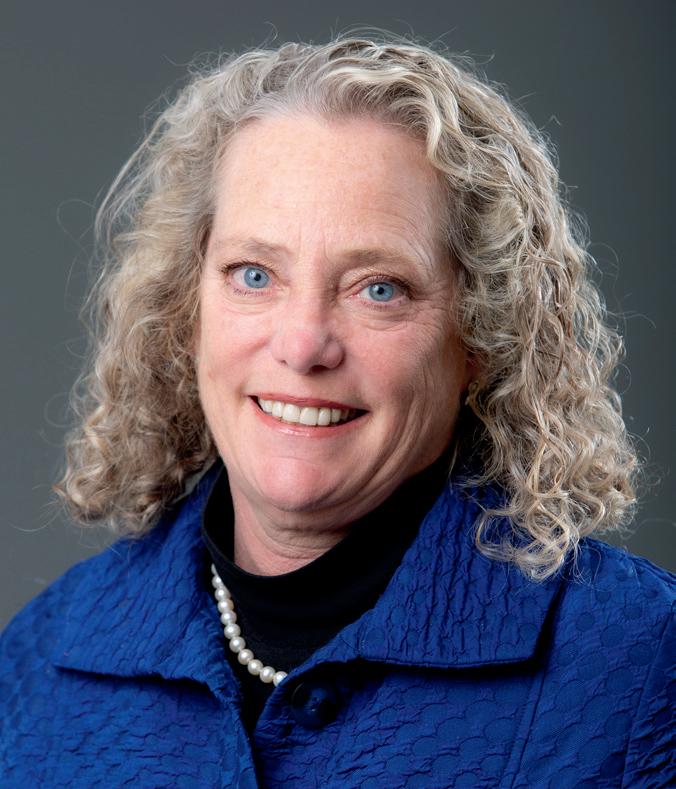
Ellen Flaherty, Vice President of the Dartmouth Health Geriatric Center of Excellence.
For example, did they forget to bring their hearing aids to an
Top:
Photo courtesy of Camille Fitzpatrick, Bottom photo of Ellen Flaherty by Dartmouth Health senior photographer Mark Washburn
Clinical Professor Emeritus Camille Fitzpatrick has now retired from UC Irvine and the Sue & Bill Gross School of Nursing, but is still championing the right of older people to specialized gerontological care.
20 : Humanitas
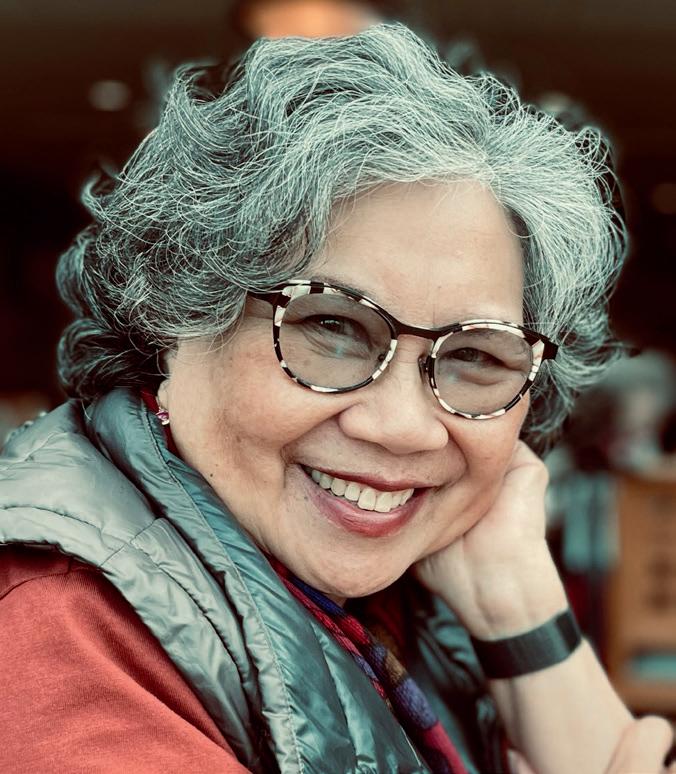
appointment? It’s not a cognition problem, it’s a hearing problem. “I have always taught nurses to focus on the geriatric ‘F’ word—function. We want to make sure that people are functioning to their highest level.”
MORE GERONTOLOGY NURSES NEEDED
The need for nurses with advanced knowledge about caring for older adults is only growing. People 65 and older make up about 17.3 percent of the U.S. population, but by 2050, they will comprise over 22 percent. In just about a decade, older people will outnumber those under 18 for the first time, the Census Bureau projects. And, the Population Reference Bureau estimates that by 2060, the number of Americans 65 and older will nearly double from 52 million (2018 data) to 95 million.
It’s not just that there are more older adults, thanks to the aging of the baby boomers. Lifespan has also increased. Despite the Covid pandemic, more people are living into their eighties and nineties, with multiple chronic conditions, thanks to the many advances in care and treatment.
This trend is not just happening in the United States—worldwide, the 65+ population is increasing steadily, thanks to improved access to healthcare, better sanitation and nutrition, lower fertility rates and reduced infant and child mortality.
However, despite the older adult population growth, there is still a serious shortage of geriatric specialists, even while demand increases. Currently, there are about 7,100 certified geriatricians in the U.S. who care for those needing more specialized care—about 30 percent of the 53 million people 65 and older. That works out to about 36.4 providers per 100,000 older adults. The ratio is even lower in rural areas. Issues like differences in compensation and age bias make it difficult to recruit primary providers to this specialty.
“There’s just this overlay of ageism, and this permeates throughout healthcare,” she says.
That societal barrier has also affected the nursing curriculum and the medical curriculum. By the time people focus on caring for older people, they seem so different and so complex with comorbidities and functional issues and the matrix of cognitive issues. “It’s overwhelming for some people,” Hansen explains.
One way to help address the shortage of geriatric care professionals is to train all healthcare providers to care for older patients, in the way that geriatric nursing is part of the Family Nurse Practitioner program at the Sue & Bill Gross School of Nursing. This should include diverse older populations with a range of health
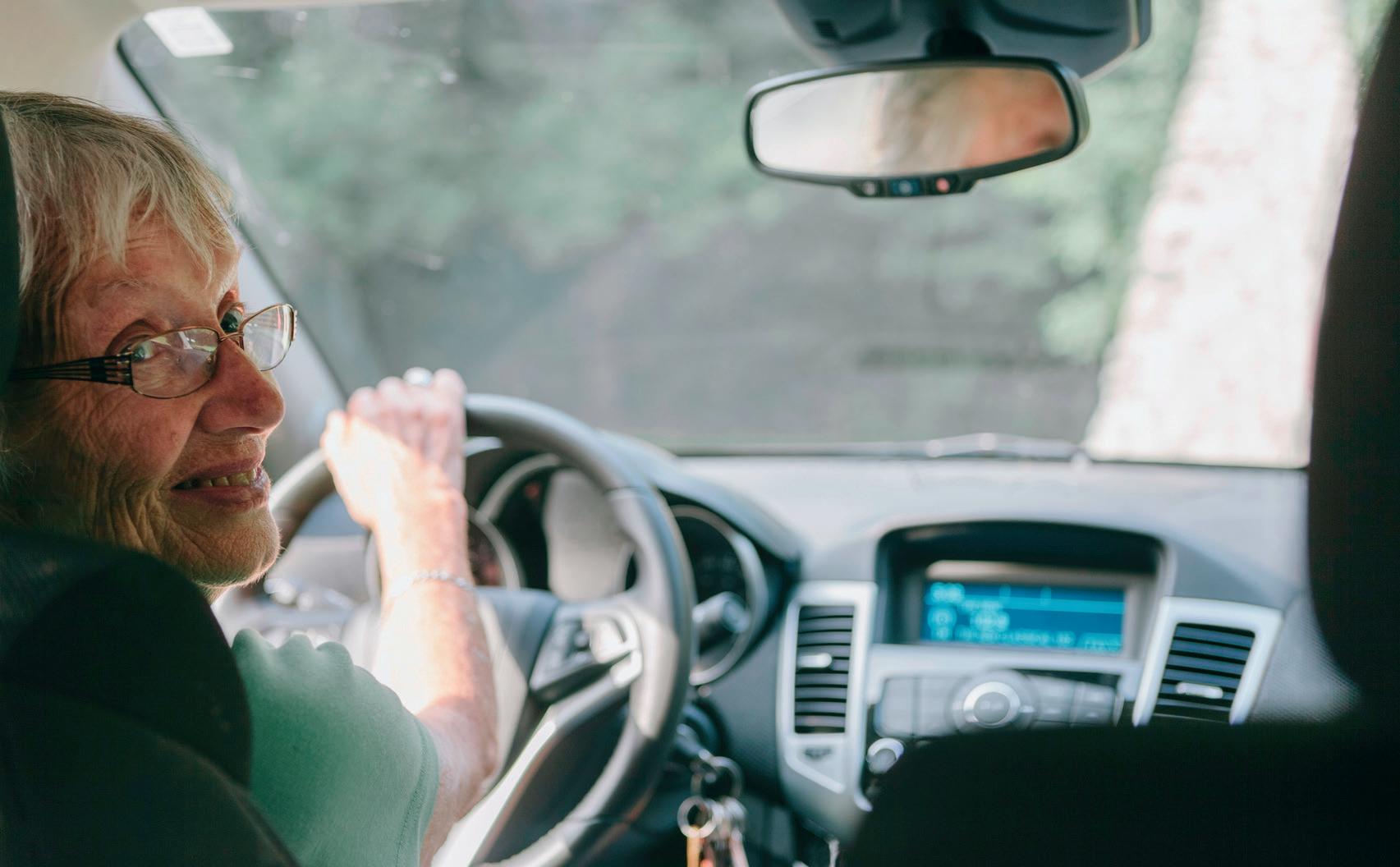
It’s an opportunity for nurses, especially nurse practitioners, to step up, according to healthcare consultant and former nurse Jennie Chin Hansen, past CEO of the American Geriatrics Society, and former president of AARP. But first, it means eliminating age bias among these care professionals.
conditions, writes Becca Levy in Breaking the Age Code. She notes that while all medical schools in the U.S. require pediatric training, less than 10 percent require geriatric training. And, “Less than 1 percent of nurses are formally trained to work with older adults.”
Top photo of Jennie Chin Hansen by Ella Simone Hansen, bottom photo by Joselito Briones / Stocksy
Jennie Chin Hansen, nurse and past CEO of the American Geriatrics Society, and former president of AARP.
Spring/Summer 2024 : 21
As Camille Fitzpatrick explains on page 22, “It’s not the nurse practitioner or the physician’s responsibility to take away a driver’s license. It’s their responsibility to evaluate.”
Reversing Ageism
CARING FOR THE MOST VULNERABLE
Between 2000 and 2007, Fitzpatrick teamed up with gerontologist Laura Mosqueda, MD (now at University of Southern California, (USC)) to provide clinical care to older adults in Orange County. They became expert in caring for older people with large numbers of serious chronic illnesses, like Alzheimer’s and heart disease. Family members were often involved, so their patients became not just the person, but everybody who loved them. That required a little bit of listening and a lot of looking at body language, observation, how people are responding, how people are jumping in, Mosqueda explains.
“Camille just has a natural ability to do that. It’s a real combination

of the art and science of medicine,” says Mosqueda. “She does her homework, she knows her stuff. And she has a big heart, and all of those things combined into being a good clinician and a good teacher.”
The trust and respect they had for each other allowed them to serve their patients and students to the best of their ability. The kind of work that she and Fitzpatrick did
and still do is often not the most expensive thing. It was often not the sort of sexiest, coolest thing. But it was the thing that was going to make the biggest impact on that person’s life for the better, Mosqueda explains.
a person who understands that the pieces are always moving, and that a condition isn’t just a
“The big thing is, I always got back more than I gave out.”
—Camille Fitzpatrick
“The world would be a better place in all kinds of ways if we had more Camilles in the world,” says Mosqueda. “She’s just a delightful person. People really want to work with her. And students want to do well because of her. She inspires all of us to do better.”
AGE BIAS ON THE ROAD
Fitzpatrick has also helped to tamp down age bias through her research and education on older adults and driving. “There are age-related changes that don’t make us necessarily unsafe, but may make us more cautious, for example, driving at night.” She developed a clinical guide to assessing driving in older adults in conjunction with the state of California, and even made a YouTube video about driver safety for Leisureworld in Florida.
“It’s not the nurse practitioner or the physician’s responsibility to take away a driver’s license. It’s their responsibility to evaluate,” Fitzpatrick explains. Her goal is to help clinicians figure out how to help their older patients maintain their independence for as long as possible. Not everyone over 65 or 70 has driving issues, but serious concerns like dementia should be reported to the DMV, she says.
Caring for older people takes specialized knowledge, the ability to tackle multiple problems at once, and someone who is unfazed by complexity. It takes
“Costco recipe,” says Hansen. “You have to tweak and adjust. It’s a partnership like no other, and the reward that you have for giving the best care based on who that person is and what you know, and bring to the table so that their life is better,” she adds.
There’s no doubt that taking care of geriatric patients is complicated and less financially rewarding than many other specialties, Fitzpatrick says. “But the big thing is, I always got back more than I gave out. It is just such a blessing and honor to be able to take care of these folks who have done so much and I just want to give back and get back.” It seems like Fitzpatrick and successive gerontology nurseeducators still have their work cut out for them, as research by Levy and others document. Higher, avoidable healthcare costs, missed treatment opportunities, poorer outcomes, and worse mental health could all be avoided, or at least minimized, if providers could remove ageism from the mix. It’s hard to break some of the myths, Fitzpatrick admits. “All we can do is role model and just be the best we can.”
Liz Seegert is an award-winning freelance health journalist based in New York’s Hudson Valley. She writes about aging, women’s health, nursing and health policy for national print and digital consumer and professional media.
Top: Photo of Laura Mosqueda courtesy of USC
22 : Humanitas
Gerontologist Laura Mosqueda, MD.
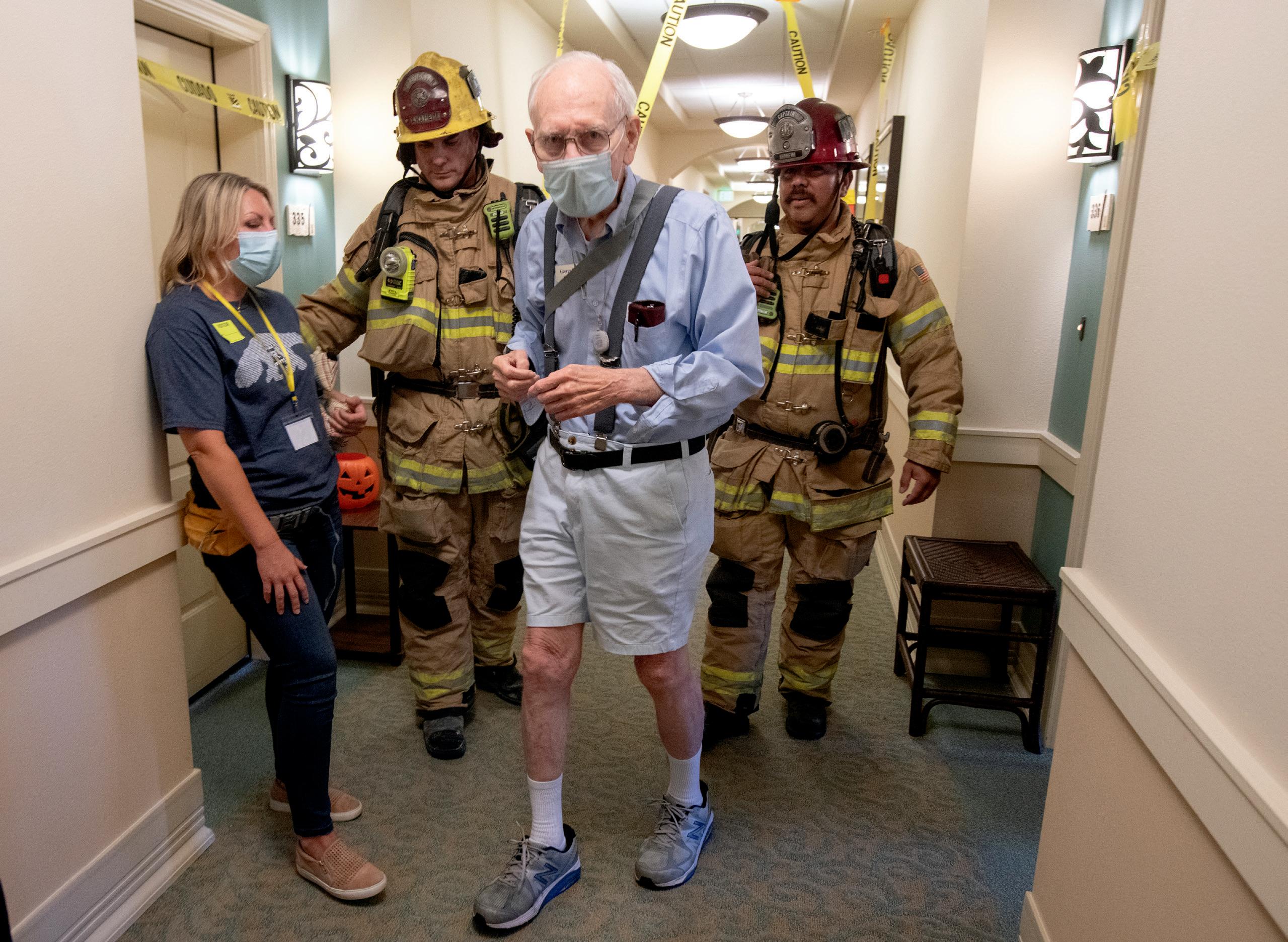 By Nicholas Schou
By Nicholas Schou
VISIBLE IN AN EMERGENCY
by Steve Zylius
As the sobering reality of climate change looms larger, older people find themselves more vulnerable than ever to the ravages of extreme weather events and rising temperatures. Amid the increasing frequency of heatwaves and other climate change-related natural disasters, a realization has begun to emerge among health professionals that the nursing profession is ideally positioned to play a leading role in creating new strategies for climate resilience among older adults.
Few people are as familiar with the crisis facing older people in the face of climate change as Danielle Arigoni. The author of the 2023 book Climate Resilience for an Aging Nation provides startling statistics to underscore
the urgency of the intersection of climate change and aging. “In 2019, only 1.2 million out of 55 million older adults aged 65 and older lived in nursing homes” in the United States, Arigoni says. Meanwhile, she adds, 30 percent of the other 55 million older adults live alone.
This growing demographic of older adults without immediate familial support, Arigoni argues, has significant implications for disaster preparedness and response. “Eleven percent of people over 75 do not have kids,” she explains. “But 20 percent of those aged 55 to 64 do not have kids.”
Given these numbers, a community resilience plan needs to acknowledge that climate change
Photo
Spring/Summer 2024 : 23
On left, Tiffany Nielson, assistant clinical professor at the Sue & Bill Gross School of Nursing, and emergency nursing specialist, takes part in an emergency preparedness scenario with first responders and senior actors.

“Nurses are in a perfect place to help people survive in an emergency.”

impacts older adults differently, Arigoni asserts. “If it assumes that everyone can respond equally,” she says, “it is really doomed to fail.”
One recent success story, says Arigoni, can be found in the experience of Portland, Oregon, where 1,000 people, with an average age of 67, succumbed to heatwaves in 2021 and 2022. Realizing the city’s older population tended to live alone and in homes that had no air conditioning, the city updated its emergency plan for future heatwaves to include the distribution of portable air conditioning units to older adults.
they otherwise wouldn’t have.”
With coordinated efforts and investments in resilience, Arigoni believes that communities can mitigate the impacts of extreme weather events and ensure that older adults are not left behind in the face of environmental challenges. Yet she also underscores the critical role of nurses, especially home care workers, in advocating for climate resilience and ensuring the safety of older adults in their care.

Elsewhere, in New York state, officials want to create two million climate-ready homes, Arigoni notes, while in New Orleans, a city repeatedly ravaged by disasters, innovative initiatives are underway to protect older adults. “Now New Orleans is creating Resilience Hubs,” she says. “They are designed to allow ready access by older adults who don’t drive, providing safety and security that
Director for Policy and Solutions at National Housing Trust, and author of Climate Resilience for
“Nurses can not only bring climate change awareness to their patients,” she asserts, “but they are in a perfect place to assess whether there are things in place to help people survive in an emergency.”
Of course, for nurses to have a measurable impact on climate resiliency for older Americans, the nation’s healthcare system—complete with its deepening shortage of nurses—needs to be fixed. “Although the elderly population is highly vulnerable to climate-related
Danielle Arigoni courtesy of Danielle Arigoni, Top photo AP Photo / Gillian Flaccus
Above: Designs for a planned Resilience Hub in New Orleans, accessible to older and more vulnerable citizens.
Right: Neighbors recall the effects of the July 2021 heatwave in Portland, Oregon, when temperatures reached 107 degrees in their homes.
24 : Humanitas
Danielle Arigoni, Managing
an Aging Nation.
Visible in an Emergency
changes (such as heat waves), the healthcare system has allocated few nursing resources to protect their health in our ever-changing climate,” says E. Alison Holman, associate dean of academic personnel at the Sue & Bill Gross School of Nursing, and an expert on collective trauma whose work often centers on climate-related catastrophe.
“The nursing profession is uniquely positioned to promote climate resiliency among the elderly as more people are choosing to stay at home rather than go to nursing homes. Nurses often provide home care for elderly patients; if we had more resources focused on addressing the climate-related health challenges home-bound elderly patients face we could prevent unnecessary deaths.”
The Covid pandemic served as a wake-up call to the vulnerabilities of older adults during emergencies, highlighting the importance of proactive measures to address their unique needs, says Nathan Tabita, UCI Health’s hospital safety officer and manager of environment of care and emergency management. During the pandemic, Tabita witnessed firsthand the challenges faced by older adults during emergencies.
“The elderly had difficulty accessing a lot of the resources we had available,” Tabita recalls. “In order to get a vaccine appointment, you had to do it online, manage it electronically. We saw some disparity there with the elderly, and they were significantly impacted by that.”
Tabita emphasizes the necessity of communication and preparedness, particularly in ensuring access to healthcare and essential resources for those living alone or with limited mobility. “Elderly people are going to be significantly impacted if they can’t get out of their place of living, or live alone, or can’t communicate,”
he explains. “Our communication is based on sending alerts to cell phones, so how do we reach out and communicate with them?”
Recognizing that dilemma, California’s Office of Emergency Services has recently added to its emergency response criteria new standards for reaching out to older adults that UCI Health is now using for training purposes.
Jocelyn Ludlow, director of simulation at the Sue & Bill Gross School of Nursing, echoes Tabita’s belief that emergency
response experts shouldn’t overlook the needs of older adults. The nursing school currently employs simulations involving manikins constructed to look realistically like older patients. Mark Lazenby, the nursing school’s dean, also believes that preparing nurses for handling the needs of older patients during emergencies is critical to the school’s mission. “Reducing vulnerability is a key priority for the Sue & Bill Gross School of Nursing, and planning the care of older adults in emergencies is an excellent

We produce leaders in research, education, and clinical practice. Leaders who champion collaborative, compassionate, and interdisciplinary evidence-based practice. Leaders who make an impact in their fields, in their communities, and in the world.
Leaders Wanted.
• Program includes online and hybrid courses • Periodic on-campus sessions • Clinical practicum placements Are you ready to make a difference? Find out more.
• 2-Year DNP Post-Master’s • 3-Year DNP FNP
Assistant Professor
Dawn Bounds, RN, PhD, FAAN
Spring/Summer 2024 : 25



Visible in an Emergency
example of where funds targeted specifically at nursing would have a significant positive impact,” he says.
UC Irvine is also spearheading an initiative to radically improve disaster preparedness for senior living facilities.
Led by a collaborative team of experts from various fields, the Enabling Disaster Resilience in Aging Communities via a secure Data Exchange (CareDEX) program began two years ago with the aim to enhance emergency response, disaster resilience, and community wellbeing, with a specific focus on older adults and the utilization of technology. Julie Rousseau, a nurse and a project scientist in UC Irvine’s geriatric medicine and gerontology department, is a key figure in the initiative. “When we first went into this years ago, we were very concerned that if you went on governmental websites with regard to disasters, there was a lot of info for pediatrics, but scant info for older adults,” she says.
One of the key components of the CareDEX initiative is the integration of technology to improve disaster response capabilities. Utilizing advanced data analytics and remote sensing technologies, the program aims to provide real-time information and support to senior living facilities during crises. “We developed a regional view so that in the event of a disaster, facilities can access vital information about nearby hospitals, mutual aid facilities, and potential evacuation routes,” explains Zenhui Hu,
CareDEX platform testing in emergency response scenarios:
Top: Dr. Sharad Mehrotra (on right), Distinguished Professor in the School of Information and Computer Science at UCI and Director of the Center for Emergency Response Technologies (CERT), oversees student deployment and platform testing.
Middle: Anaheim City Fire Department and Emergency Manager respond to Tiffany Nielson’s simulated scenario to evacuate an older adult resident with a serious burn injury.
Bottom: Evacuees gather outside the building.
by
Photos
Steve Zylius
26 : Humanitas
Photos by Steve Zylius
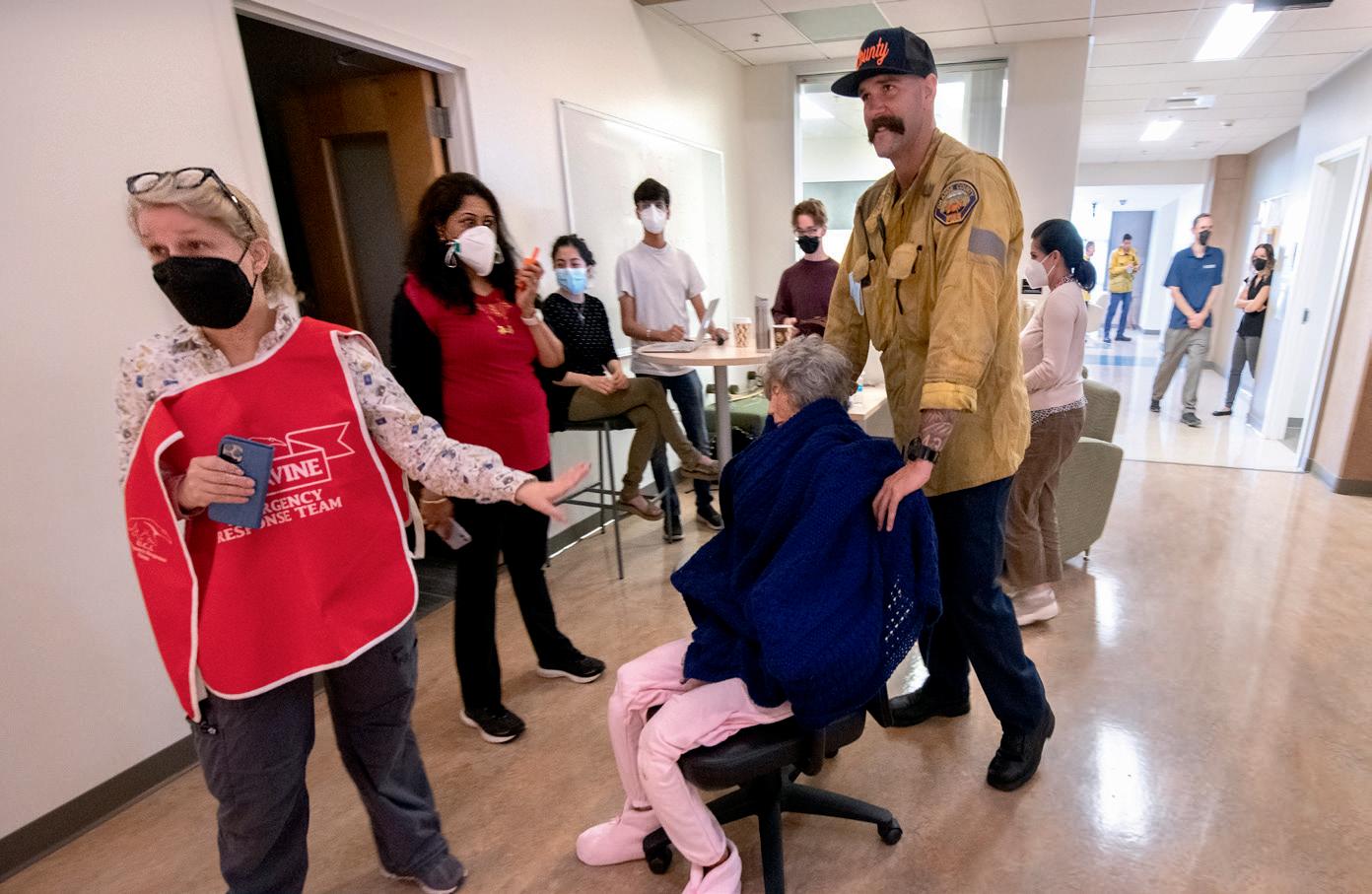

a member of the team specializing in risk management.
CareDEX is also developing community outreach to ensure the project’s effectiveness and inclusivity, says Chris Davison, who works on scenario development and evaluation. “We’re working to take
“The only time [disaster preparedness] gets a spotlight is when a lot of older adults are impacted, and that’s too late.”
CareDEX to rural areas where they may not have the capacity to build resilience for older adults,” he says.
Nalini Venkatasubramanian, a professor of computer science at UC Irvine and the CareDEX principal investigator, says that the CareDEX team is reaching out to other parts of
the country and beyond in an effort to build their simulation data. “We are working with folks in Japan who have a very large aging population and very similar disasters to California with earthquakes,” she says. “We’re also talking with the city of San Antonio with regard to heat waves and hope to be looking at hurricanes in Louisiana at some point soon.”
The CareDEX initiative has already garnered attention and support from various stakeholders, including government agencies and advocacy groups such as the National Fire Protection Association and the National Hazards Center. Looking ahead, the project aims to further expand its reach and impact by continuing to develop innovative solutions and forging partnerships with stakeholders across different
sectors, says Rousseau, adding that it’s critical to the project’s efforts to address the challenges of disaster preparedness for older adults. “We all really do feel that this is overlooked,” she says. “The only time it gets a spotlight is when a lot of older adults are impacted, and that’s too late.”
The sooner America’s nurses and other health professionals begin to recognize the challenge and create a solution, the better, agrees UCI Health’s Tabita. “The next big disaster is inevitable,” he says. “But if we work together, we can ensure that our elderly population is not left behind.”
Nicholas Schou is an award-winning journalist with 25 years of experience in print media. He is also the author of several books on national security, the media, and the war on drugs.
Top: Julie Rousseau and Nalini Venkatasubramanian (CareDEX Principal Investigator), in partnership with the Orange County Fire Authority, oversee the UCI Bren Center emergency drill.
Spring/Summer 2024 : 27
Right: Dr. Lisa Gibbs, Chief, UCI Division of Geriatric Medicine, works with the Orange County Fire Authority and a volunteer student actor in simulating the evacuation of a Memory Care Unit.

“I no longer feel alone.”
Community

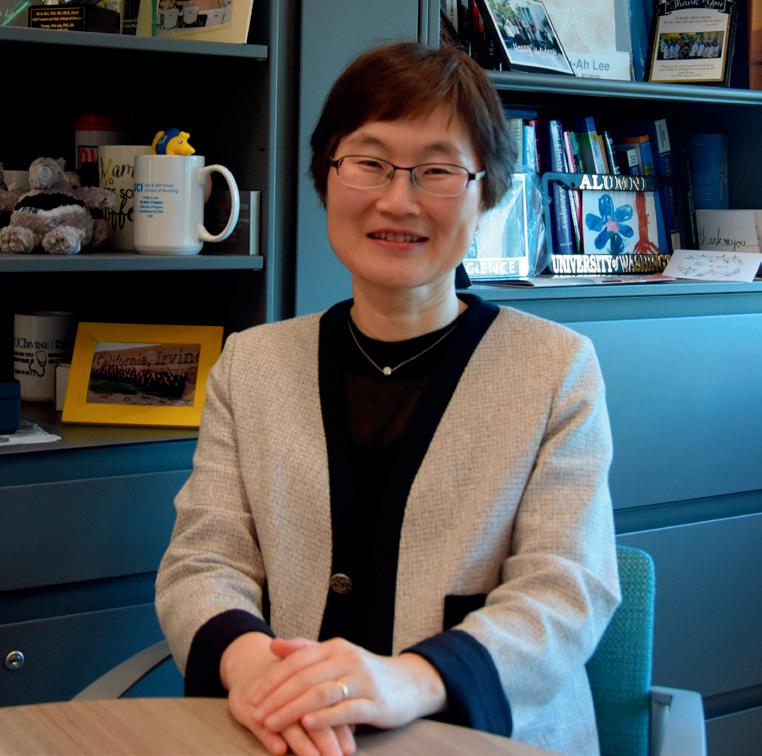
Professor Jung-Ah Lee of the Sue & Bill Gross School of Nursing is developing effective, culturally sensitive support for the family caregivers of people with dementia.
In the United States, the Alzheimer’s Association estimates that 11 million family members and friends are involved in the unpaid care of people with dementia. Many of them are of a similar age to or even older than the person they are caring for. Some are caring across generations that do not speak the same first language. Many have no idea that there is any outside support available.
Dementia isolates. As the condition progresses, increasing difficulties with communication and connection can create a social void in which stigma also plays a part. Although in 2024 almost half of Americans have a family member or friend living with dementia, the condition remains feared and misunderstood.
“We still need to educate the public,” says Jung-Ah Lee, professor and associate dean for diversity, equity, inclusion and belonging at the Sue & Bill Gross School of Nursing. “From the elementary school to the senior center, everyone needs to understand: that could be my future. How can I be part of an age-friendly society?”
The primary carers of people with dementia—usually spouses or children—also risk isolation, more acutely so when language or cultural differences render them invisible to services and systems that could support them.
Photo courtesy of Theo Rigby / Ination Media,
Photo of Jung-Ah Lee by Elin Slavick
Spring/Summer 2024 : 29
Community

How are these caregivers coping? How could their lives, and their ability to care, be made better? And—as always in healthcare systems—how can effort and expenditure be prioritized to provide the greatest impact possible?
These are questions Lee set out to investigate in 2019 with a pilot intervention to help the family caregivers of Korean-, Vietnamese-, Spanish- and English-speaking people with dementia.
“Many lay people ask, ‘Why are you supporting the family, not the patient?’” says Lee. “But this is where the person with dementia lives—a Korean home, a Latino home. The family is where that person’s support is going to come from. These families are in silos. There is little culturally appropriate social support unless they have been paying out of pocket
for in-home service or long-term care facilities. They are a very, very underserved population. There is no cure for dementia, so if people with dementia are to have quality of life, family is everything.”
Cultural understanding is crucial to recognizing the difficulties specific caregivers face, Lee explains. In Vietnamese- and Korean-speaking families, for example, awareness of Alzheimer’s and other causes of dementia may be particularly low because the family doctor can be reluctant even to name the condition. To avoid voicing the diagnosis outright, primary care providers might refer to medication as “brain vitamins” or “brain supplements to make your parents or spouse smarter.” Lee found caregivers who did not know what they were dealing with.
Lee’s project involved training bilingual research staff as community support workers who met with caregivers regularly, one-on-one, over a three-month period. They investigated caregivers’ concerns and the challenges they faced, also imparting information about the symptoms and progress of dementia. The community workers trained caregivers in self-soothing and self-calming techniques and facilitated their knowledge and connections with available sources of external support. Critically, self-care was enhanced using wearable technology—a smartring and a smartphone app—to measure markers of wellbeing and inform both the caregiver and the study when selfcare measures needed to be taken.
“Asians and Latino family caregivers who are struggling still want to express their emotions positively,” says Lee. “They don’t want to seem like they are complaining. For example, when asked they would say, ‘I slept okay,’ but the data told a different story.”
The reported impact of the intervention on caregivers was emphatic. Participants were found to benefit in all three areas under scrutiny: individual empowerment (including capacity for self-care), relationships with the people they cared for, and creating community connections. Importantly, the information provided by wearable tech enabled the researchers to personalize care at far lower cost
Photo courtesy of Fernando Salazar
30 : Humanitas
This Mexican-American woman in her sixties cares for her 88-year-old mother with dementia at home. “The family is where the person [with dementia]’s support is going to come from,” says Lee.
than would be possible through any other existing method, holding the promise of a scaled-up support
“Nursing combined a paying job straight out of college with Lee’s dream of making healthcare systems better for all.”
service that could be both effective and affordable.
In pursuit of that goal, Lee is now involved in a five-year NIH/NIAfunded intervention developed from the combined lessons of her threemonth pilot study and a subsequent telephone support intervention that she ran during the Covid pandemic. She continues to work on refining the usability of wearable tech, with Amir Rahmani, Professor of Nursing and Computer Science at UC Irvine, as a collaborator. Additionally, Lee has worked with UCI Health Geriatrics on other state-funded projects aimed at improving early detection of cognitive decline among low-income older adults, and is developing a virtual interactive education program for informal caregivers of persons with dementia.
All this, Lee explains, is the organic development of a nursing career that has zeroed in inexorably on questions of health equity and access.
“My heart is for health equity,” she says. “That’s my center.”
Lee traces that center to her
origins in South Korea. When she was a newborn baby and her sister not much older, their father died right after open-heart surgery, at the age of just 28.
“There was very little skill in open-heart surgery in Korea in 1971,” she says.
“The family home and income disappeared with my father. We went
to live with my grandmother and my sister was my ‘little mother,’ a second mother to me. My mom worked so hard. She came home only to sleep.”
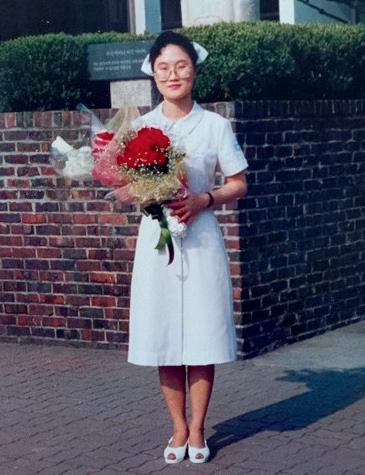
Lee identified nursing as a good choice of career because it combined her requirement for a paying job straight out of college with her dream of making healthcare systems better for all. She worked as a registered nurse in an academic medical center in Seoul, Korea, developing an interest in care quality improvement, before attending graduate school at the University of Washington, Seattle, and subsequently obtaining her PhD there. In 2008, she joined the University of California, Irvine, as a founding faculty member of the Program in Nursing Science that became, in 2017, the Sue & Bill Gross School of Nursing. By now, Lee’s work had
Photo courtesy of Jung-Ah Lee
Spring/Summer 2024 : 31
Lee in Korea in 1992, dressed for her Nightingale pledge and cap ceremony at the end of her sophomore year as nursing student.
Community
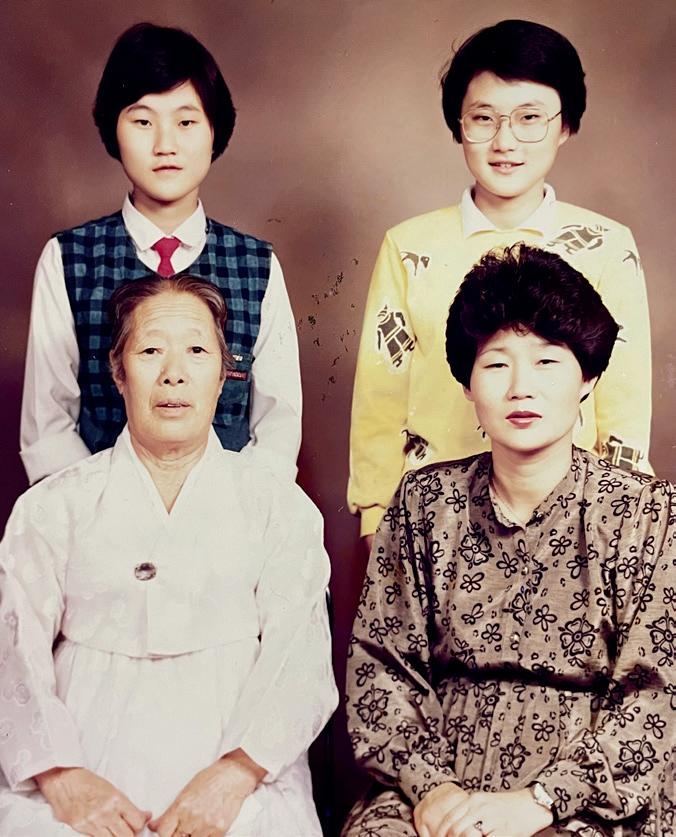
familiarized her with the difficult gap between identifying improvements to large systems and implementing them.
“I was—and am—a faculty member working outside the healthcare system,” she points out. “It’s hard to change organizations, particularly from the outside.” It occurred to her that care-related systems outside the hospital might prove more flexible.
A chance encounter on an airport shuttle bus inspired Lee’s first insight into a new way to bring care to the community. Returning from a flight, she was intrigued to see two fellow travelers, apparently in their eighties, happily using an iPad—a recent invention at the time. It struck her that she was witnessing a revolution: the intuitive touchscreen with its visible array of app icons overcame many of the previously existing barriers between older users and tech.
Her first instinct was to develop an app, which she did: a successful medication education app for seniors, encouraging at-home adherence to oral anti-coagulation therapy for people at risk for thrombosis. “But,” says Lee, “tech overtakes your progress when you’re developing an app.” She felt there had to be an even smarter use for smart tech in community nursing care.
Lee was at the time helping a medical colleague as a Korean-language interviewer for a geriatric study. Her role involved asking 10 senior Korean participants a series of questions developed by healthcare providers.
“I was raised by my grandmother so talking to seniors is easy for me,” says Lee. “I talked to them about their perceptions of healthy aging and community support, about elderly depression, end of life, cancer, whether they had experienced racial discrimination in the healthcare system. They were very, very frightened of dementia, of memory loss.
“It opened my eyes,” she continues. “What is it to be an immigrant? I had lived in the U.S. for 15 years, but as a Korean, a foreigner. I got my green card, I got tenured in 2015. Talking to these seniors I realized, oh, I am a Korean-American now. How come I don’t know the life of immigrant seniors?”
This realization of the limits of her knowledge gave Lee what she calls, “my ‘aha’ moment about working with seniors in the community.” Clearly, there were populations all around her in the U.S. whose fears and difficulties about aging were unknown and unnoticed. At the same time, Rahmani’s work on wearable tech was revolutionizing the potential of nursing research at UC Irvine, and Lee was quick to join forces. “I have always been comfortable with technology,” she says.
It was from this confluence of influences that Lee’s initial intervention was designed, and from which her work has grown. Her current five-year study ends in
“There are populations all around the U.S. whose fears and difficulties about aging are unknown and unnoticed.”
2025 and she is still actively recruiting participants from four different ethnic communities. “I’m very busy!” she says.
Nonetheless, she continues to expand her interest to encompass related lines of research.
“There’s another part to this,” she says. “How can we help prevent cognitive decline? Nurses can help people manage chronic diseases very well. We can help
Photo courtesy of Jung-Ah Lee
Clockwise from top: Lee (with red tie), her older sister, her mother (the breadwinner) and her grandmother.
32 : Humanitas
them exercise, eat healthy—I may skip a meal but I never skip exercise. We need to manage social isolation, stress, loneliness and senior depression—all associated with decreasing cognitive functions. The concept is a little bit different to
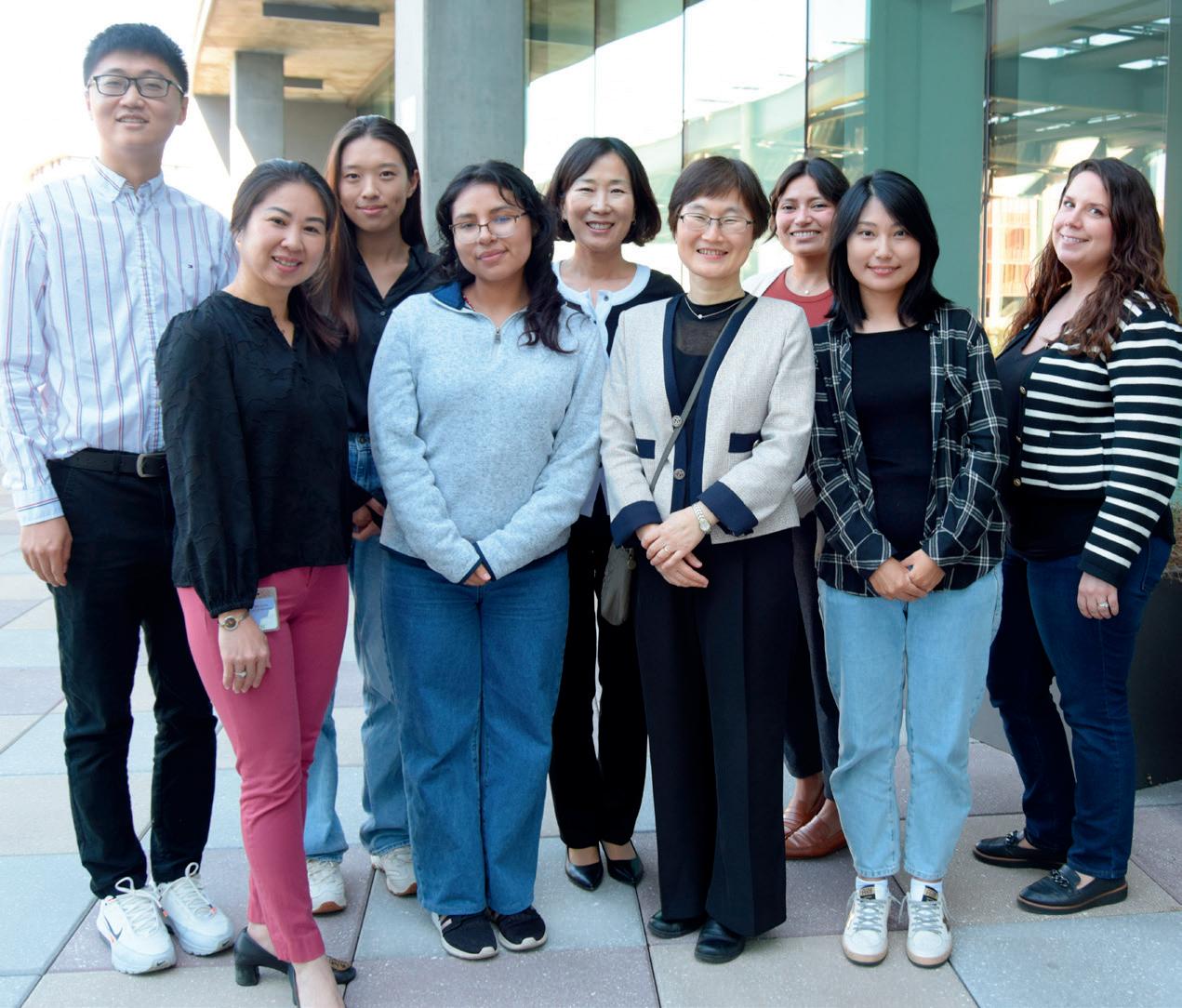
healthy aging. It’s a holistic perspective. And social connection is a big part of it.”

BUILD
YOUR
CAREER IN NURSING AT THE BEST PLACE TO GIVE AND GET CARE
Actively hiring for all nursing levels and specialties at hospital and ambulatory locations.
Ranked as one of America’s best hospitals by U. S. News & World Report for 23 consecutive years.
JOBS.UCI.EDU

Scan to search nursing jobs
group
students by Elin Slavick
Photo
of
of
Lee and her team of bilingual researchers and students, who trained as community support workers for her current five-year project.
Spring/Summer 2024 : 33
Jung-Ah Lee spoke with Humanitas editor Leonie Gombrich.
Happenings
Recognition
Nancy Pike received the Western Institute of Nursing's 2024 Anna M. Shannon Mentorship Award.
Professor Jung-Ah Lee is to be inducted to the Sigma International Nurse Researcher Hall of Fame in July 2024.
Professor Lee also received the 2024 Senior Geriatric Researcher award from the Western Institute of Nursing (WIN).
Associate Professor Michelle Fortier’s pilot project, “Translating Goal-Focused Emotion Regulation Therapy to Young Adults Across Cancer Diagnoses,” was one of 28 groundbreaking cancer research projects awarded funding by the UCI Anti-Cancer Challenge.
Advocating nursing
Assistant Professor Jung In Park was inducted as a Fellow of the American Medical Informatics Association (FAMIA), recognizing her achievements in Applied Clinical Informatics.
Professor Susanne Phillips was honored as a Distinguished Educator by the Greater Irvine Chamber of Commerce and the National Organization of Nurse Practitioner Faculties 2024 Outstanding Policy Award.
Assistant Professor Dawn Bounds provided expertise to an advisory panel of the American Psychological Association that is releasing evidence-based recommendations on use of social media by adolescents.
Laura Assayag, a third-year DNP-FNP student, received the Western Institute of Nursing (WIN) peer-reviewed best student poster award for “Multimodal Educational Strategy to Increase Palliative Care Communication.”
Jamie Rae Garcia, DNP student, received a 2023 UCI Lantinx Excellence and Achievement Award for student success and research excellence.
Elected officials recognize the importance of nursing to their constituents, and our school is often visited by local and national representatives.
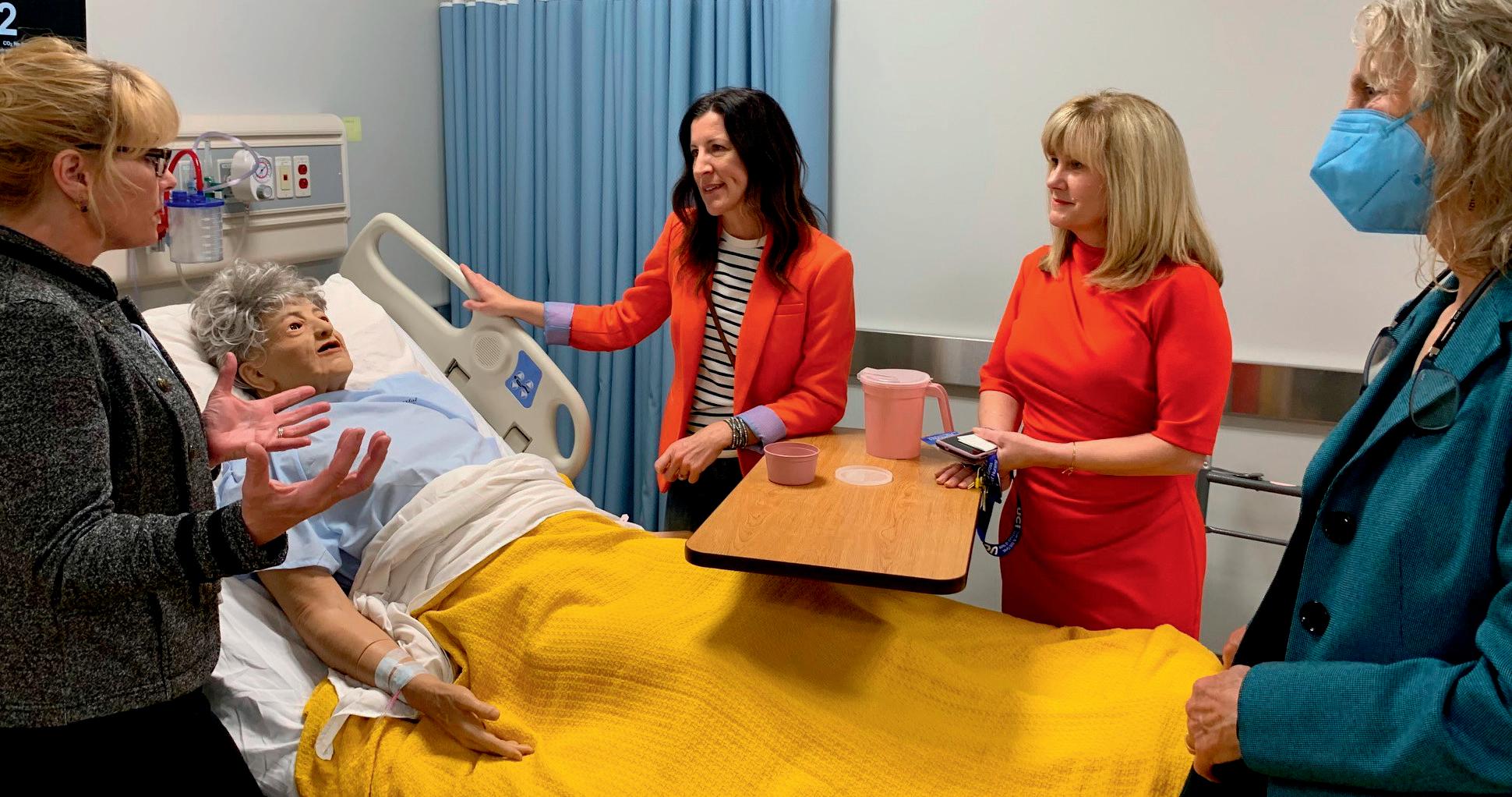
In orange blazer: Assemblymember Cottie Petrie-Norris (California 73rd Assembly District), visiting the Sue & Bill Gross School of Nursing simulation center, with school of nursing faculty.
by Debra
Photo
Curran
34 : Humanitas
Happenings
Advocating nursing
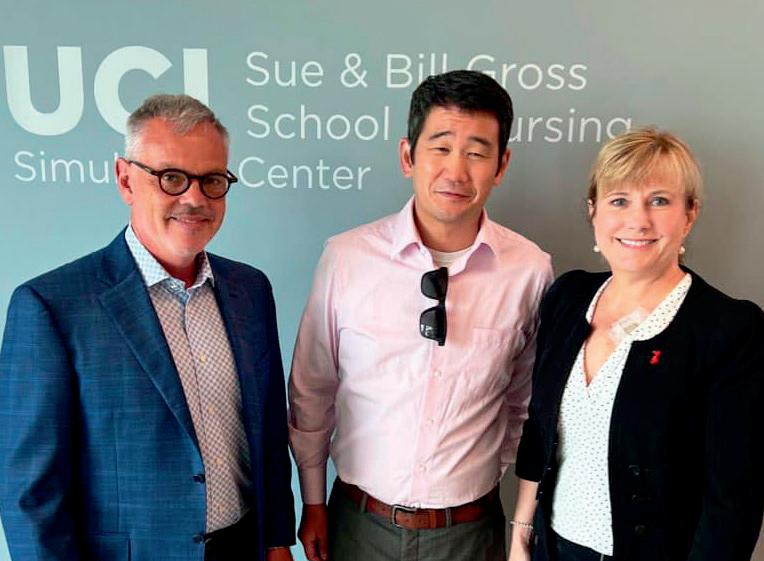
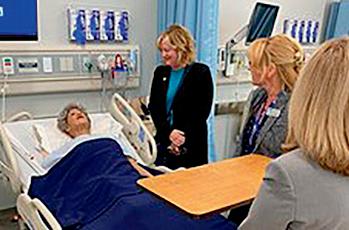
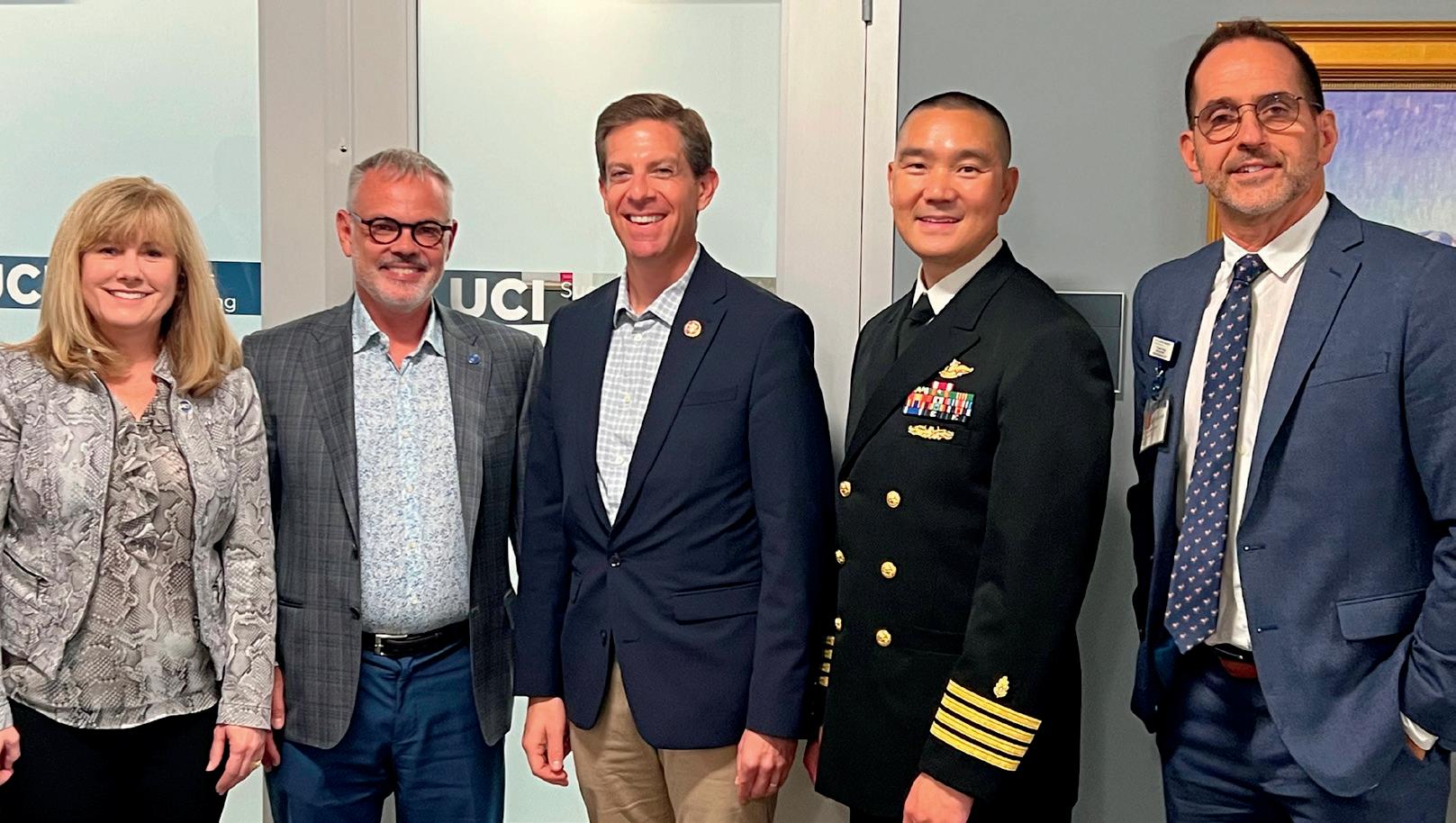

As advocates we also reach out to policymakers at their places of work.
From left: Dean Mark Lazenby, Professor Susanne Phillips, Congressman Mark Takano (California 39th Congressional District), and Debra Curran, Director of Communications & Marketing, Sue & Bill Gross School of Nursing.
From left: Senior Associate Dean Susanne Phillips, Dean Mark Lazenby, Congressman Mike Levin (California 49th Congressional District), Commander Jeffrey Chao, MD, U.S. Navy, and Michael Lekawa, MD Trauma & Critical Care Surgery, UCI Health.
Left center: Senator Dave Min (California 37th Senate District).
Spring/Summer 2024 : 35
County Supervisor Katrina Foley (Orange County 5th District) visiting the simulation center.
Happenings
The HBCU eight-week summer research program is part of our participation in the University of California President’s Office UC-HBCU initiative to encourage increased representation of Black students at post-masters level.

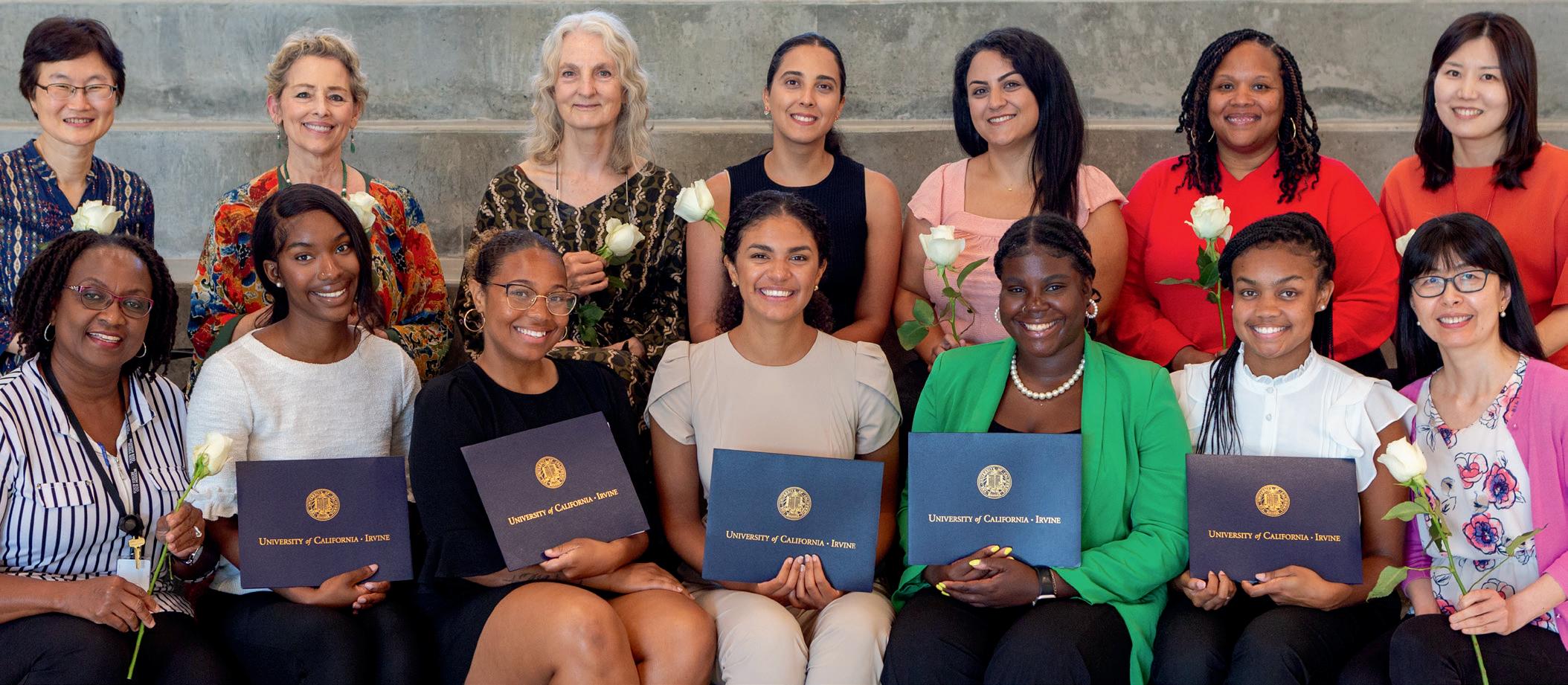
In the media
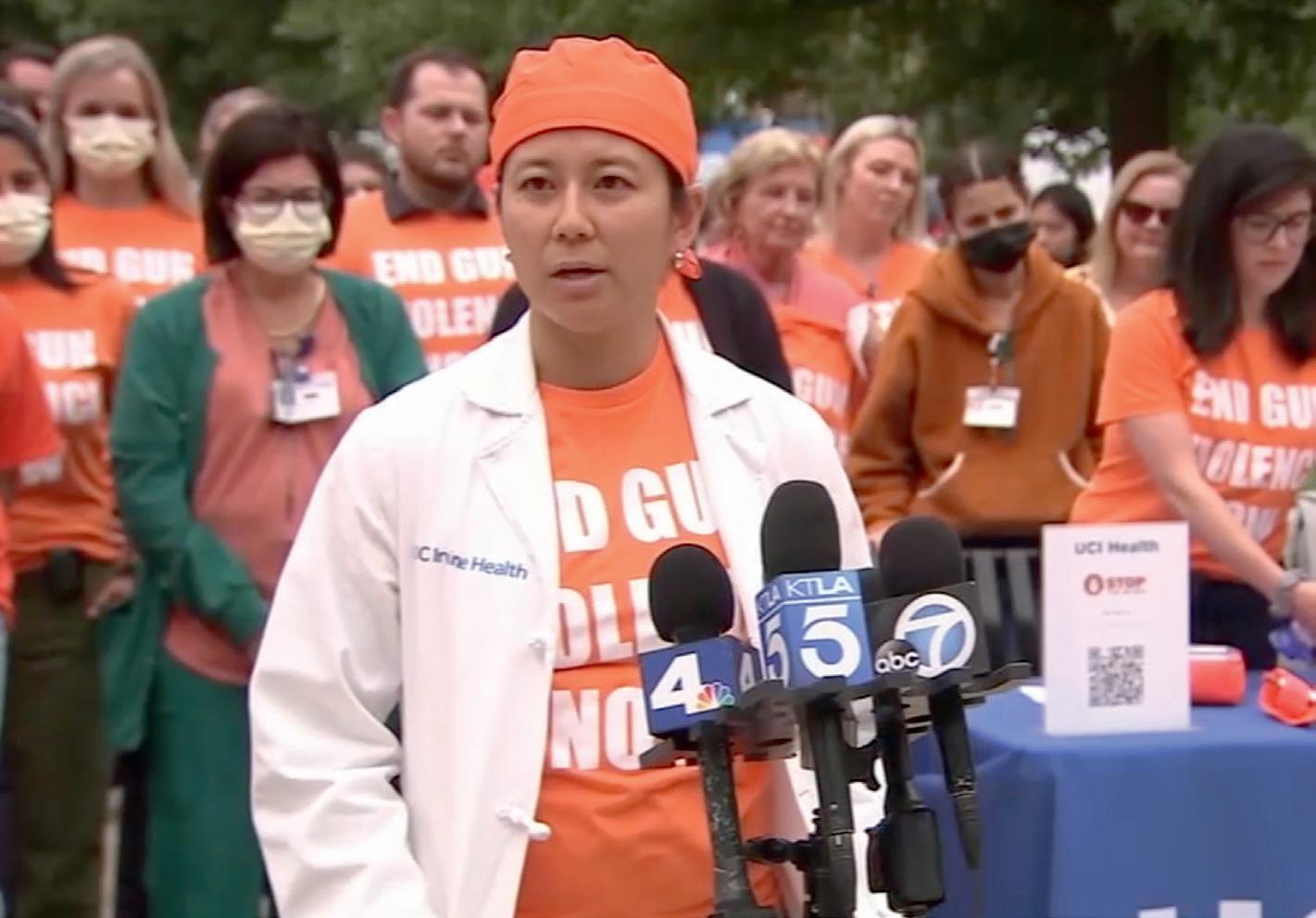
Professor E. Alison Holman quoted in The Washington Post, “Depression rises after a stroke”; and Science News, “Trauma distorts our sense of time and self.”
Assistant Professor Dawn Bounds interviewed in The New York Times, “To mute or unfollow? Experts’ tips for a mindful approach to social media”; in today.com, “What does ‘lala bop’ mean? What parents need to know to protect, inform their kids”; and parents.com, “What Does ‘Lala Bop’ Mean and Why Is It All Over TikTok?”
Assistant Professor Michael V. Bueno interviewed in The Washington Post; “Caring for Alzheimer’s patients brings new challenges for some men.”
Assistant Professor Candice Whealon article for Fox News Digital, “Expert shares 4 strategies to combat disengagement and burnout in the nursing workforce.”
Professor Jung-Ah Lee quoted in Forbes Health, “Best Home Care Services of 2024.”
Shannon Cotton, PhD student, quoted in Healio.com on her research into risks associated with incomplete Covid vaccination, previously presented to the American Thoracic Society International Conference.
Faculty and PhD students, Back row from left: Jung-Ah Lee, Adey Nyamathi, E. Alison Holman, Mahkameh Rasouli, Afsaneh Saghafi, Nakia Best, and Jung In Park.
Faculty and participants, Front row from left: Shelley Burke (faculty), Ketsia Kasongo, Nastacia Taylor, Alexis Ross, Breanna Hutchison, Meghan Anthony, and Yuqing Guo (faculty).
In pale blue blazer: Assembly member Diane Dixon (California 72nd Assembly District) at the simulation center.
ABC7 news streaming channel features nursing school students and UCI Health workers supporting National Gun Violence Awareness Day.
36 : Humanitas
Photo (bottom) courtesy of ABC7eyewitness, top by Carlos Puma
THANK A NURSE! MAY 6-12, 2024
Compassionate powerful


Professional Resourceful Authoritative BRAVEgenerous Independent Calm diligent TENACIOUS
IDEAS
Empathy Integrity
Assistant Clinical Professor
Vanessa Rodriguez, APRN
Happenings
The Sue & Bill Gross School of Nursing hosted a ribbon-cutting event on September 19, 2023, to celebrate the transformative gift from the Sue & Bill Gross Family Foundation that made possible the founding of the school and its purpose-built premises. The Sue J. Gross Foundation has continued to support the school with a gift that enabled the addition of a state-of-the-art simulation center and 200-seat auditorium, named for its benefactor.
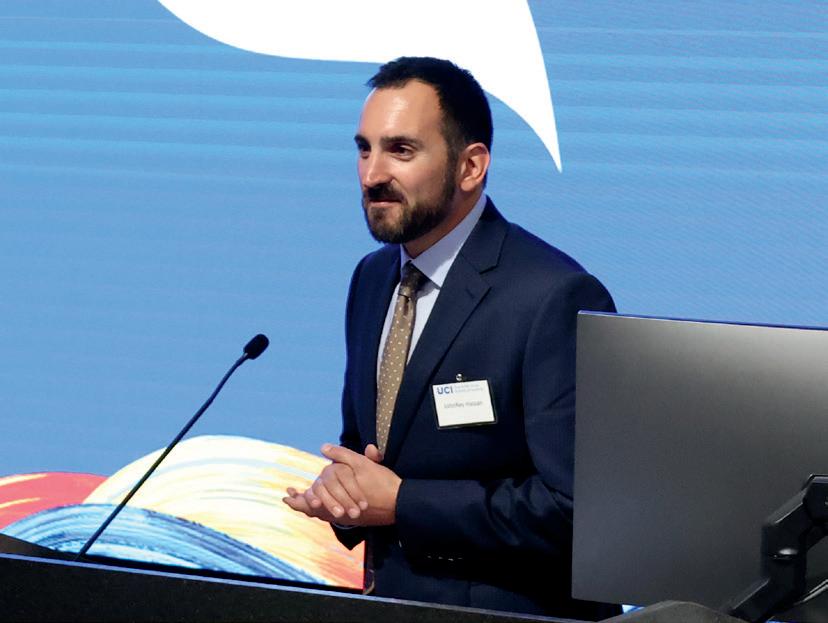


Sue Gross cuts the ribbon in celebration of the opening of the school.
From left: Brian Hervey, Vice Chancellor of University Advancement & Alumni Relations; Hal S. Stern, Provost & Executive Vice Chancellor; Nick Gross and Landon Gross; Sue Gross; Dean Mark Lazenby; Adey Nyamathi; Ellen Lewis; Ellen Olshansky; Susanne Phillips; E. Alison Holman; and Steve Goldstein, Vice Chancellor of Health Affairs.
 Alumnus JohnRey Hassan, from the program’s first cohort of Bachelor of Science graduates, now runs a major healthcare service company in northern California.
Founders and leading advocates of nursing education at the University of California, Irvine. From left: Adey Nyamathi (founding dean), Susanne Phillips, Ellen Lewis, Ellen Olshansky, E. Alison Holman, and Mark Lazenby.
Alumnus JohnRey Hassan, from the program’s first cohort of Bachelor of Science graduates, now runs a major healthcare service company in northern California.
Founders and leading advocates of nursing education at the University of California, Irvine. From left: Adey Nyamathi (founding dean), Susanne Phillips, Ellen Lewis, Ellen Olshansky, E. Alison Holman, and Mark Lazenby.

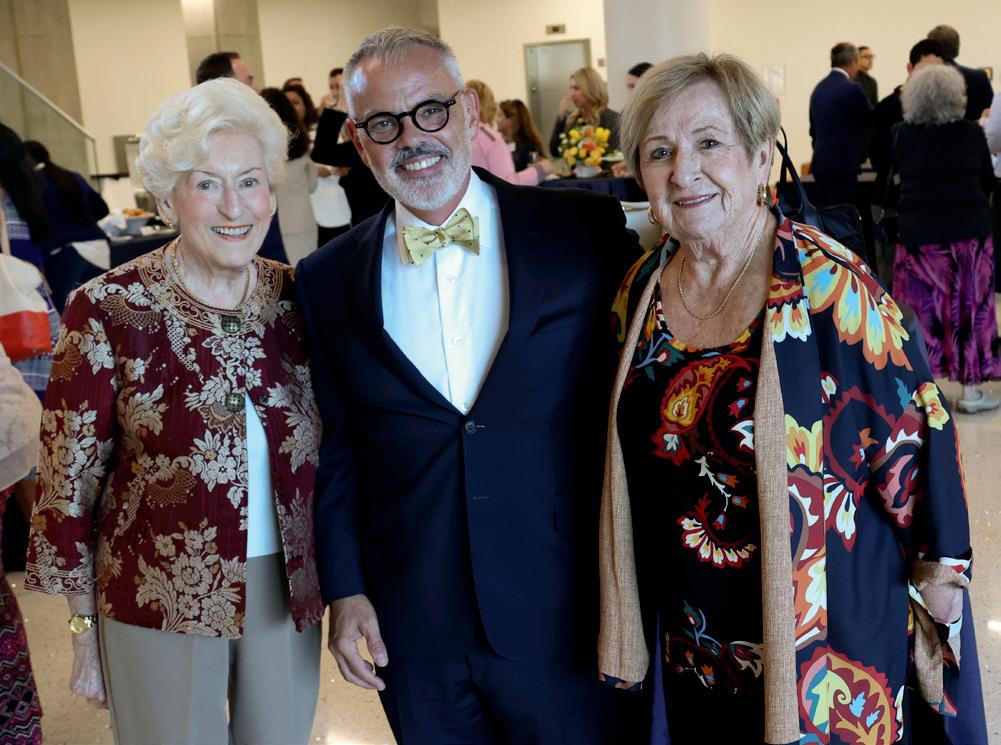
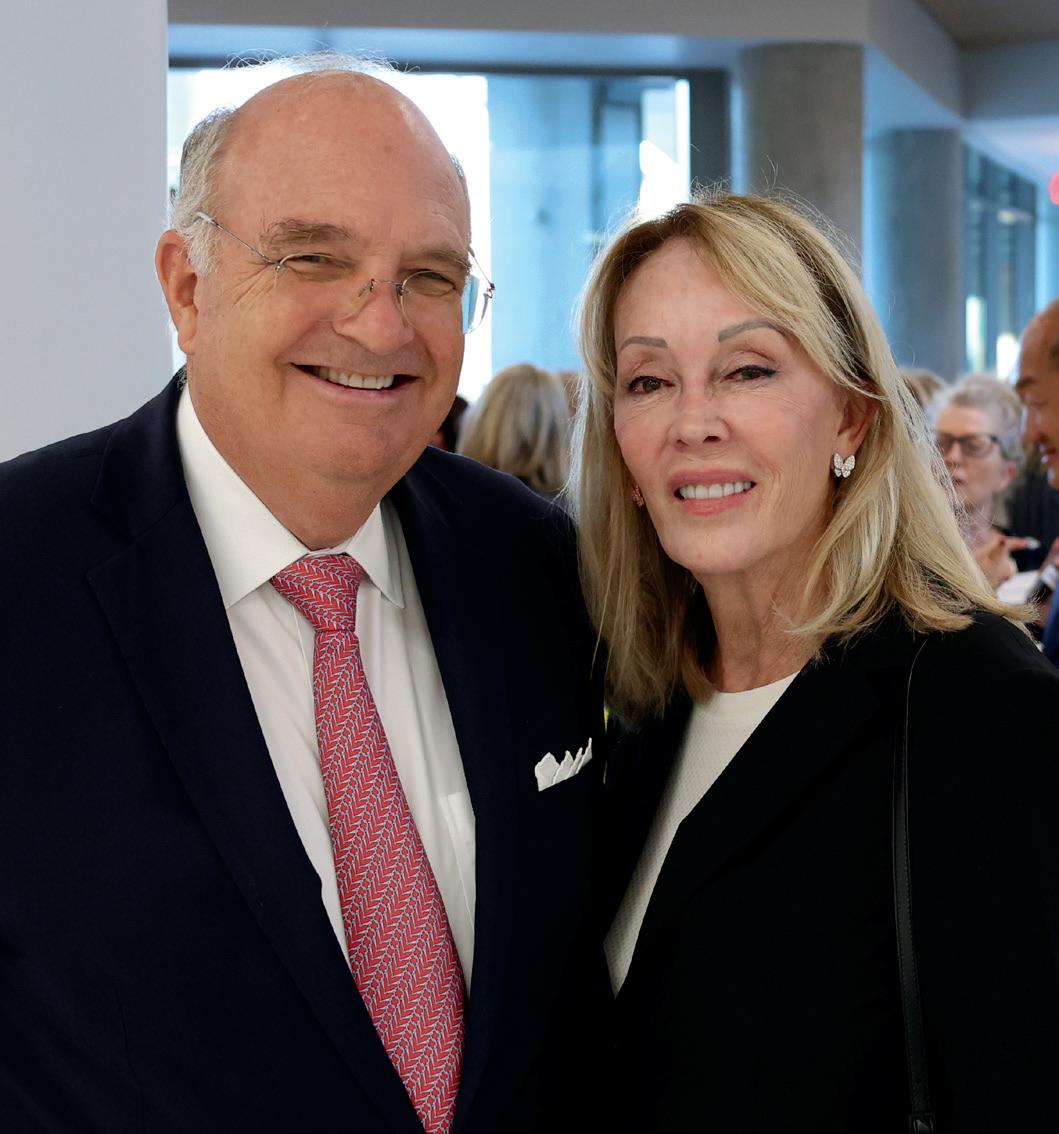
All photos both pages by Carlos Puma
Dean Mark Lazenby with (on left) Mary Roosevelt and (on right) Ellen Lewis.
The event was attended by friends and supporters of the school, including the Dean’s Advisory Council, pictured here with Sue Gross. From left: John Irvine Swinden, Chris O’Dea, John Conners, Feizal Waffarn, Jennifer Johnson, Diane Drake, Jeffrey Vu, Dean Mark Lazenby, Sue Gross, Judy Murphy, Debra Mathias, and Eileen Moore.
Spring/Summer 2024 : 39
Sue Gross with James Irvine Swinden, whose family has been integral to the founding and development of the University of California, Irvine.
Happenings
Ribbon cutting in the Sue Gross Auditorium was followed by a reception in the lobby of the Sue & Bill Gross School of Nursing building and a tour of the simulation lab for guests.

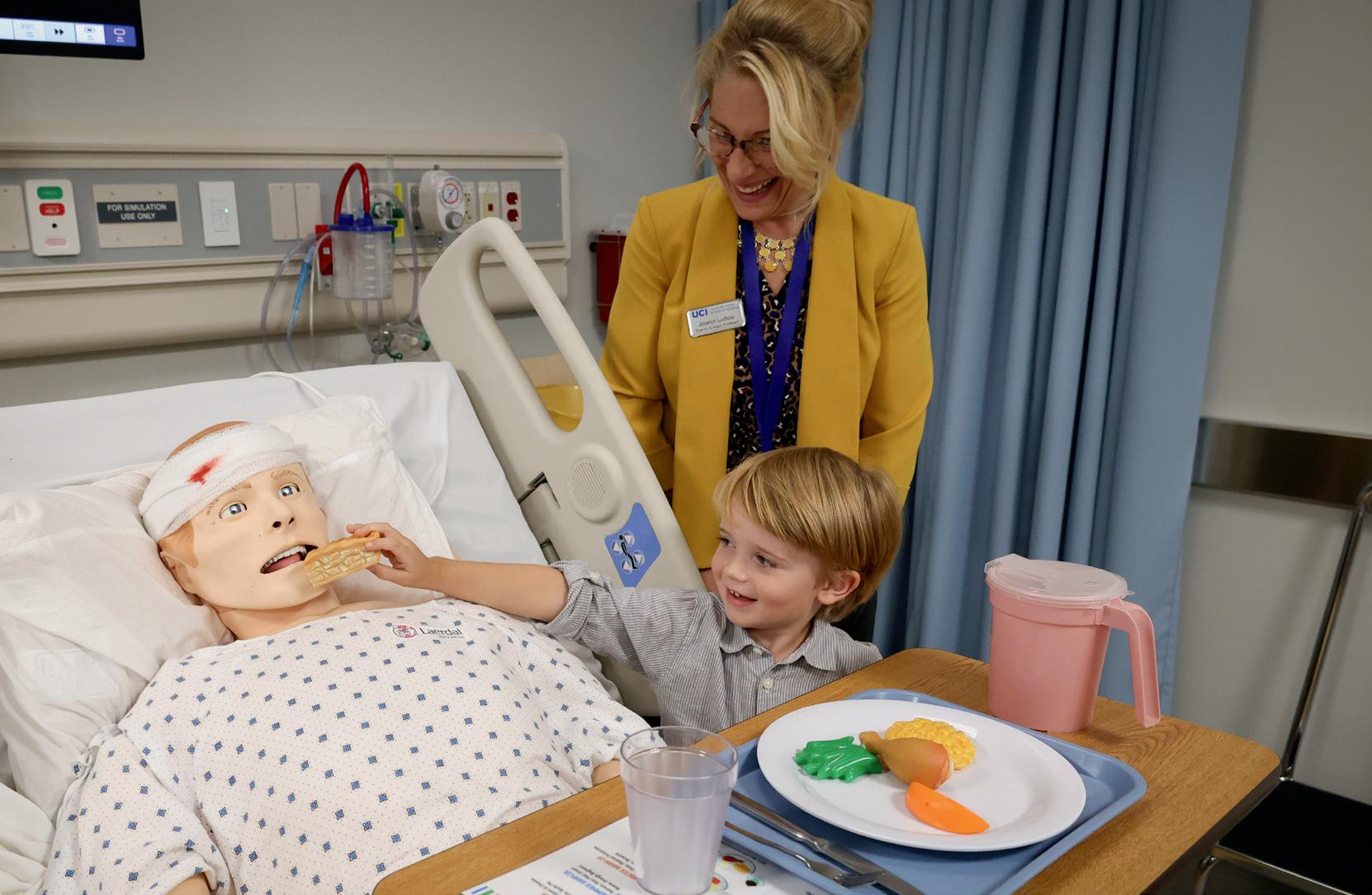
In the simulation center, Sue Gross’s grandson takes care of a manikin patient’s nutritional needs while Director of Simulation Jocelyn Ludlow supervises.
 Faculty and staff of the Sue & Bill Gross School of Nursing. From left: Assistant Professor Dawn Bounds; Associate Clinical Professor Jocelyn Ludlow, Director of Simulation; Assistant Clinical Professor Shelley Burke; Professor Michelle Fortier; Megan Enciso, Director of Student Affairs and DEIB Initiatives.
Faculty and staff of the Sue & Bill Gross School of Nursing. From left: Assistant Professor Dawn Bounds; Associate Clinical Professor Jocelyn Ludlow, Director of Simulation; Assistant Clinical Professor Shelley Burke; Professor Michelle Fortier; Megan Enciso, Director of Student Affairs and DEIB Initiatives.
40 : Humanitas
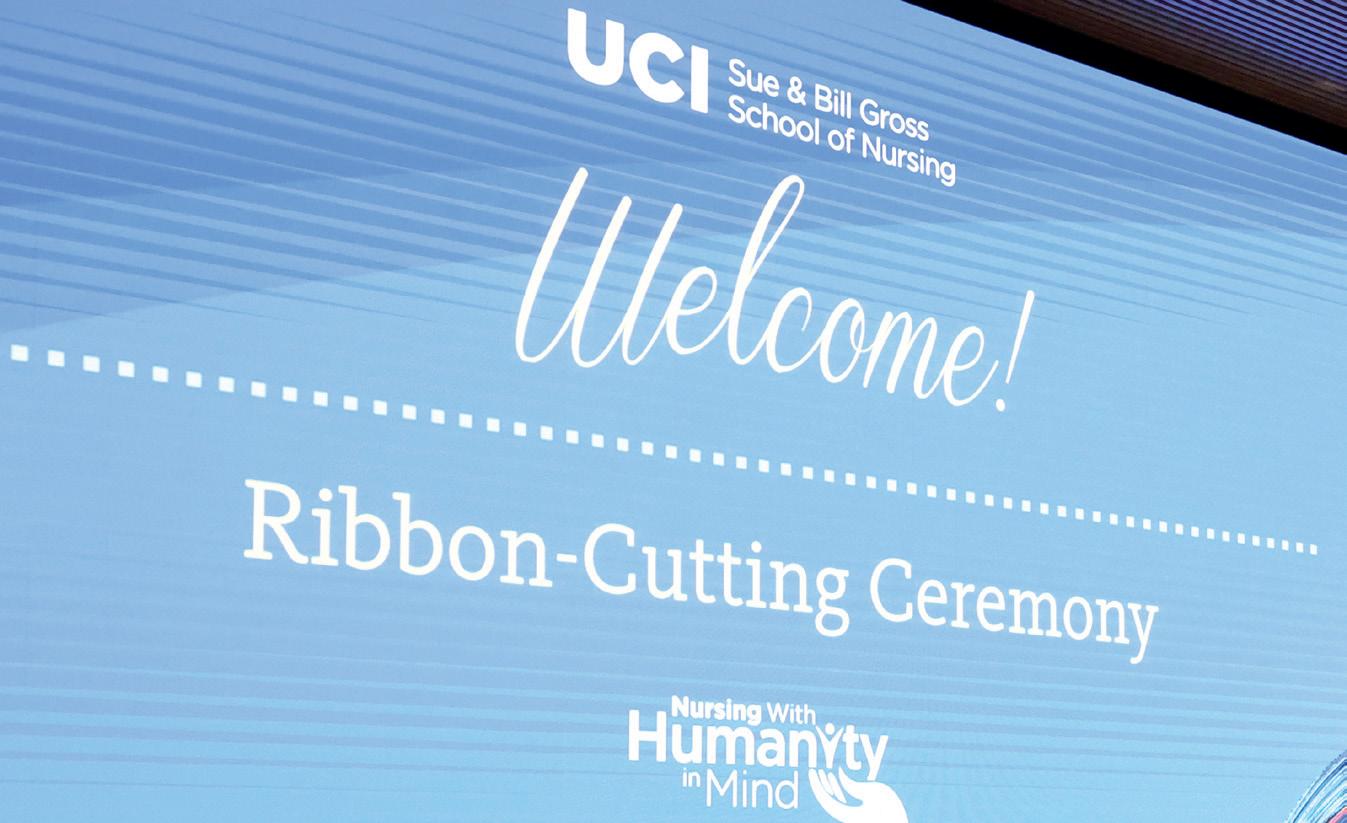
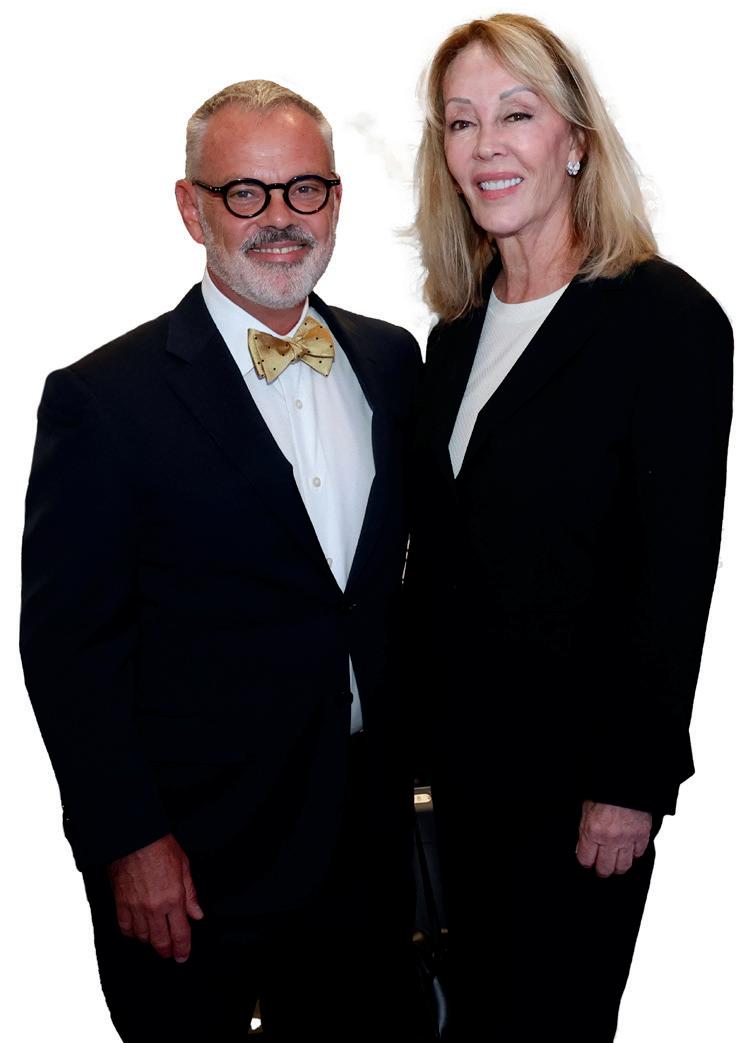
A warm welcome was extended to guests in the Sue Gross Auditorium. On the first floor of the nursing school, the history of nursing at University of California, Irvine, is summarized as a timeline.
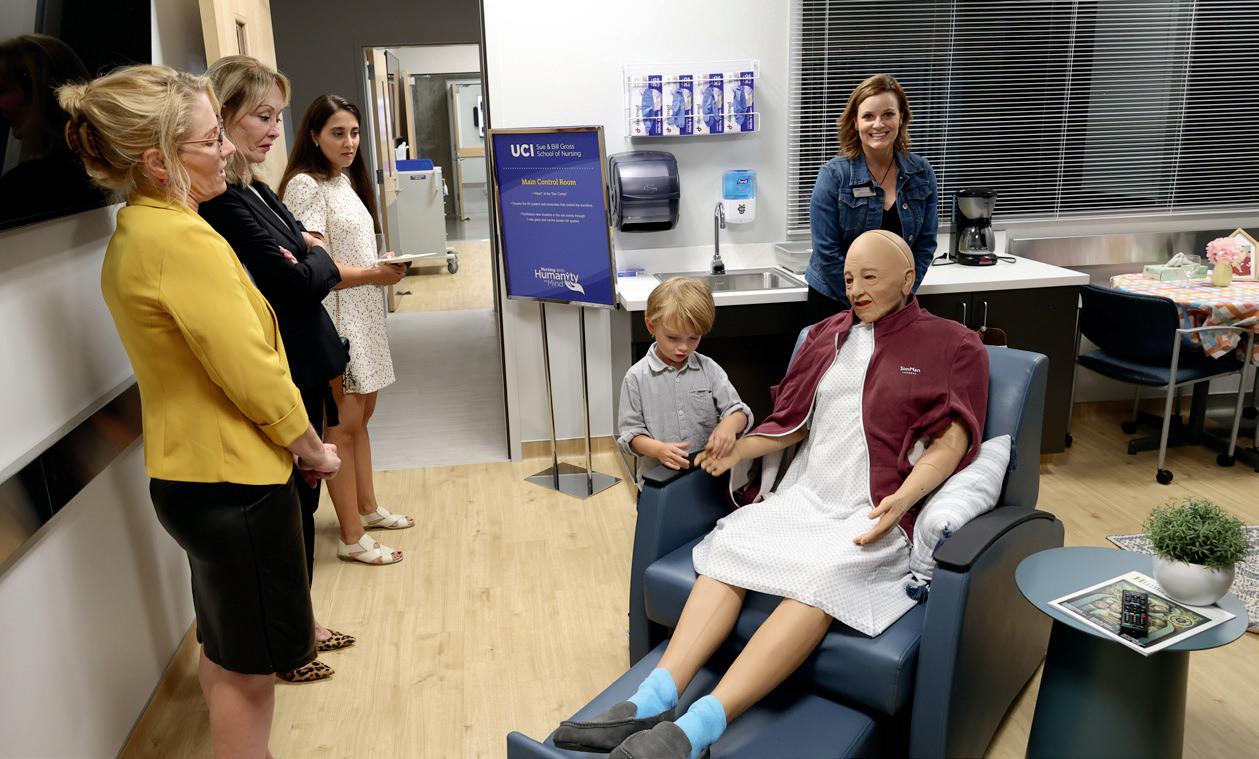
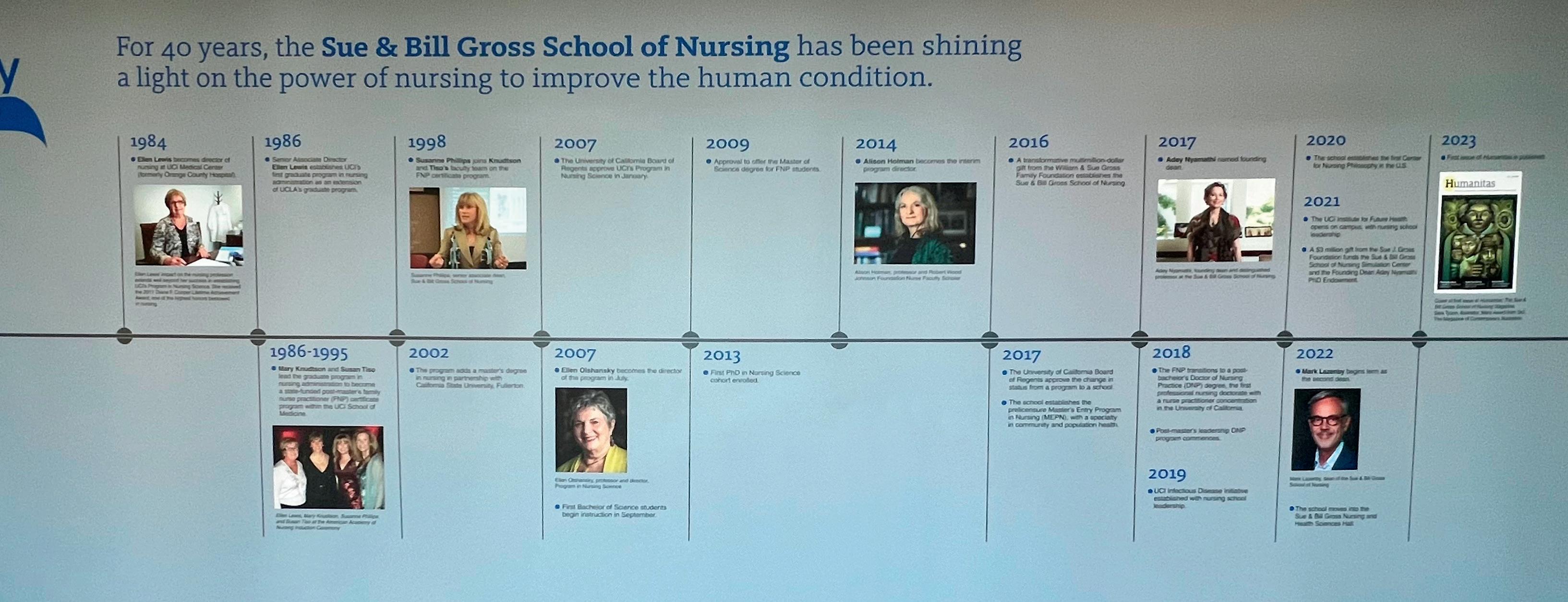 Sue Gross with Dean Mark Lazenby.
The tour of the simulation center continues. Is that an issue of Humanitas lying on the manikin’s table?
Sue Gross with Dean Mark Lazenby.
The tour of the simulation center continues. Is that an issue of Humanitas lying on the manikin’s table?
All photos both pages by Carlos Puma
The history of the school is now a full-height wall infographic displayed on the first floor of the building.
Happenings
First two rows, left to right:
Assistant Professor Dawn Bounds greets a friend. Shaista Malik MD, Professor of Cardiology, with Steve Goldstein, Vice Chancellor of Health Affairs.
Assistant Clinical Professors Vanessa Rodriguez (left) and Nisa Patel.
Paola German, Clinical Instructor, Health Sciences (left), Richard Yang and Robert Phillips.



Bottom two rows, left to right:
Debra Curran, Director of Marketing & Communications, Tatiana Arizaga, Executive Director of Communications and External Relations, and P. Alberto Sandoval, Assistant Vice Chancellor Community & Government Relations.
Senior Associate Dean Susanne Phillips and Judy Corless, Sue & Bill Gross School of Nursing Leadership Council. Chuck Villenueva, Assistant Dean for Finance & Administration, with original nursing program founder and longterm advocate for nursing at UC Irvine, Ellen Lewis.

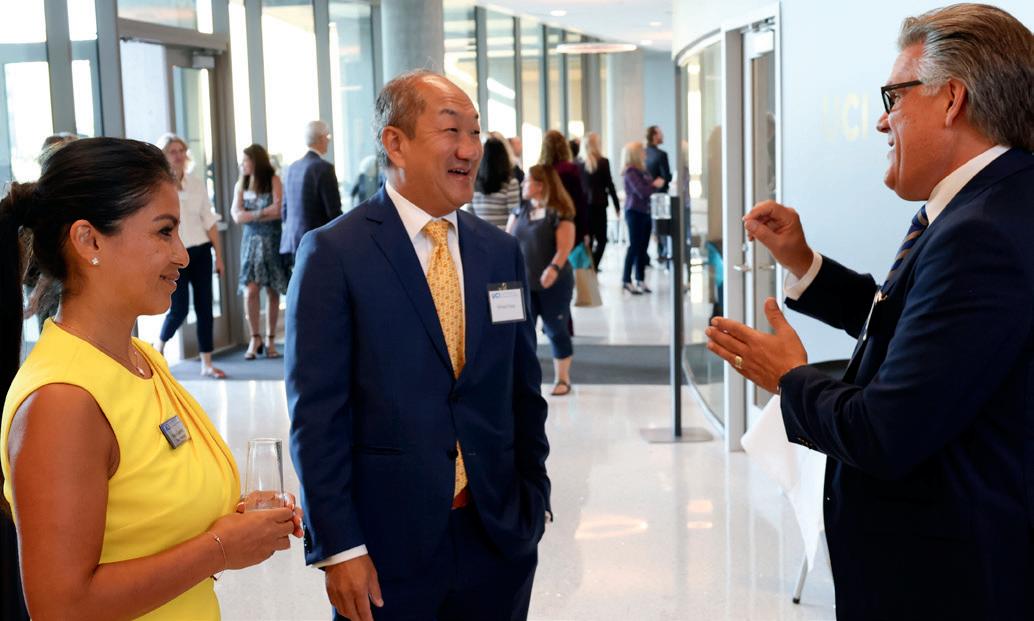
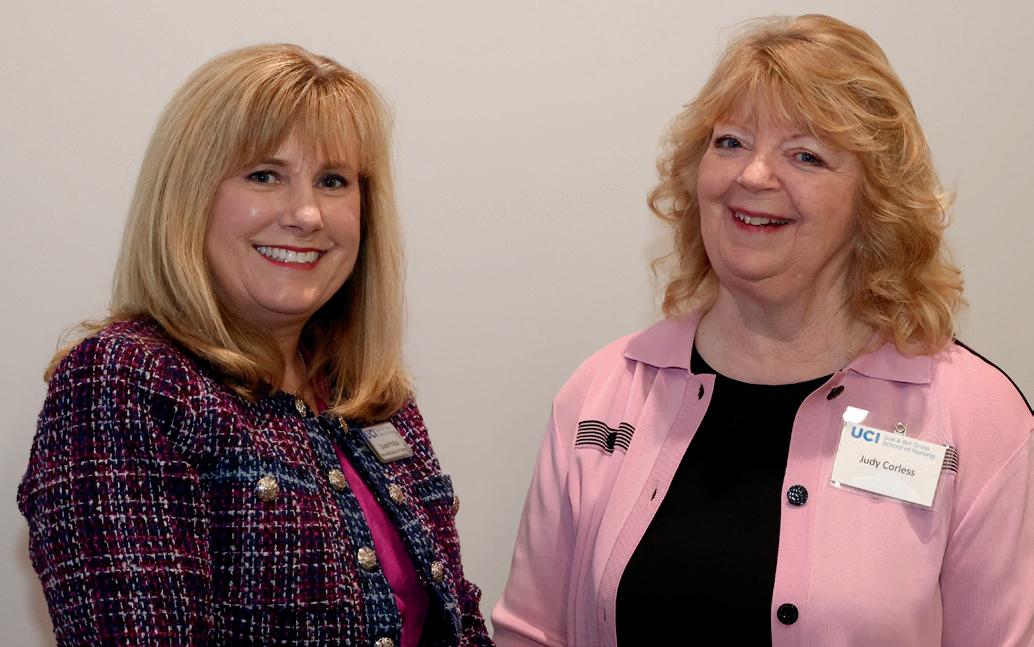
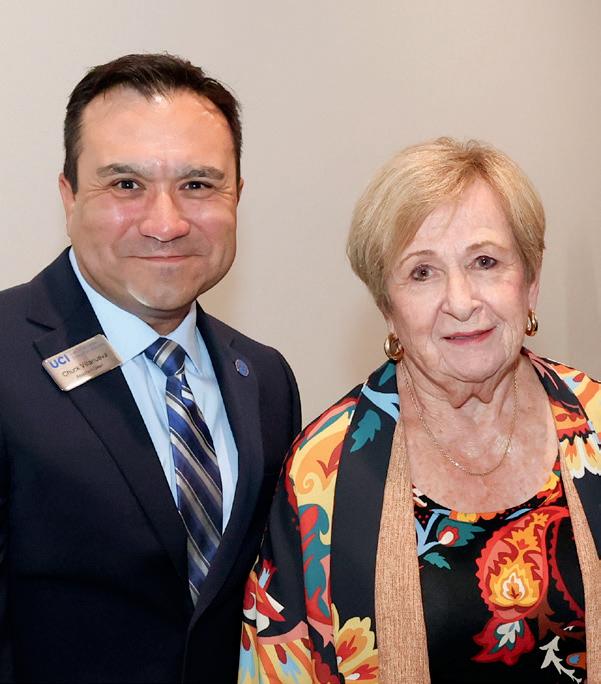
by Carlos Puma
Photos
42 : Humanitas
Alumni Impact
Erin O’Hair
Year Graduated: 2011
Degree: MS
For Erin O’Hair, the most important thing about gerontology, the study of aging and caring for older people, is a holistic approach.
“You really need to take a step back and look at the whole picture and the person as a whole,” she says, reflecting on the older patients she’s served for over a decade of her nursing career. “You can’t treat just the disease.”
Gerontology, like the holistic approach O’Hair favors, is a multidisciplinary branch of care. Different from geriatrics, a more physically focused medical specialty, gerontology is also concerned with the social aspects of aging.
For a successful holistic approach, O’Hair believes in the importance of having conversations with patients and their families, ensuring that the care aligns with the patient’s own goals.
“As people age, and they get closer to the end of life, their goals may shift. So you need to have those continuing, ongoing discussions about ‘Okay, this is where we were when you decided

these goals. This is where we are now. Are those goals still the same?’” she says.
Determined to ensure that healthcare enhances the quality of her patients’ life rather than diminishes it, O’Hair cares for her patients from the comfort of their own homes. After six years as a nurse in the Intensive Care Unit, including time in UCI Medical Center’s traumasurgical ICU, O’Hair no longer sees patients on the hospital floor. Now, she tries her best to keep her patients from unnecessary hospitalizations, focusing on preventative home-based care.
important to them. I get to look at family photos. I get to assess their environment and their living situation, and I have the time to do that, which is really nice.”
She wishes that more people knew how rewarding gerontology can be,
“As people age, their goals may shift. You need continuing discussions about where they are now.”
O’Hair saw many frail, older patients on ventilators while working in the UCI trauma-surgical ICU. Desiring to prevent such hospitalizations, she wanted to go into palliative care.
Pivoting from the fast-paced life of an ICU nurse, O’Hair turned her focus to caring for older people. In 2011, she graduated as part of the inaugural class of nurse practitioners from the then-Program in Nursing Science, the precursor to the Sue & Bill Gross School of Nursing. She earned her degree as a Doctor of Nursing Practice 10 years later from California State University, Fresno.
“What I really, really like about my role and this type of work is I get to slow down,” she says, “So I’m going to someone’s home, I get to look around. I get to see, you know, who’s
that though gerontology patients are complex, and the work includes tough conversations about care until the end of life, gerontology care done well is a true service to the patient and their family.
O’Hair’s first experience caring for an older person came in 2003, when, as an undergraduate with an undeclared major at Chico State University, she didn’t yet know what she wanted to do. She got a position as a caregiver with an older man who had Parkinson’s disease, her first patient.
“He told me I had a knack for it, that I should go to nursing school,” O’Hair says. “I hadn’t really considered it before, but I did it, and I’m glad I did.”
Photo courtesy of Erin O'Hair Spring/Summer 2024 : 43
Alumni Impact
Danielle Alfego
Year Graduated: 2016
Degree: MS
Danielle Alfego (née Godino), has known she wanted to be a nurse since the sixth grade.
“I’ve always had a calling to help people,” she says. “Ever since I was little, even when I was in school, I was always trying to make sure everyone felt included and valued. Anyone who was on the outskirts, I never wanted people to feel bullied or left out or anything like that.”
Now, Alfego continues to be a champion for inclusion as a family nurse practitioner who primarily sees older adult patients. In her primary care practice at the University of California, San Diego, she wants to make sure that her patients, who usually range from 60 to 100 years old, feel involved in their care through shared decision making.
says, is giving them a say in their own care. She believes it’s important to talk to older patients about how to integrate beneficial changes in a manner that fits their individual lifestyles, rather than treating them all the same.
“I feel as though giving them a voice in their own care is imperative because a lot of times, the easy
CALLING ALUMNI
Could you be profiled in Humanitas? Please get in touch: we feature alumni in every issue and we’d love to hear from you about what you’re doing now. Write to: DeansOfficeSON@hs.uci.edu
Alfego enjoys the constant education that comes with nursing.
Since graduating from UC Irvine, she has continued to be involved in the family nurse practitioner program as a preceptor.
“Medicine is constantly changing, so you always have to be up to date with evolving guidelines,” she says.
“I’ve always had a calling to help people.”
“I want to ensure that the students are using best practices, that they feel comfortable in an environment to learn before they actually go out into the field, because it is hard.”
“It’s challenging for aging folks to feel like they don’t have control anymore,” Alfego says. “Especially when it comes to memory, or even musculoskeletal issues, to give up that sense of independence or realize that they might not be able to do things as they did before. I feel helping them through that life change is important.”
Alfego finds creative ways to help her patients feel more in control, such as digital health monitoring for blood pressure management, at-home programs for physical or occupational therapy and post-ER follow-ups, and support resources for disease management, all to help preserve independence and prioritize good quality of life.
A key way to help older adults feel empowered, Alfego
thing to do is to say, ‘These are the recommendations, and this is what we’re doing to meet standard guidelines,’ instead of sitting down with the patients and saying, ‘You know, I want you to be involved in your care, this is your life and what you need matters,’” Alfego says.
When caring for older adults, it is not unusual to also work with their family members, especially when it comes to joint decision making. Alfego compares working with the patients and their families to mediating —the most important part is coming to an agreement about what’s best for the patient.
Alfego appreciates that throughout the FNP program she was taught to think outside the box. She’s still in touch with her mentors, Susan Tiso and Susanne Phillips.
“It was a pleasure to mentor a student with her level of compassion for patient care, her sense of humor and humility, and indeed her passion for learning, growing, and continuing her pursuit to be the amazing nurse practitioner she has become,” says Phillips, senior associate dean and professor at the Sue & Bill Gross School of Nursing.
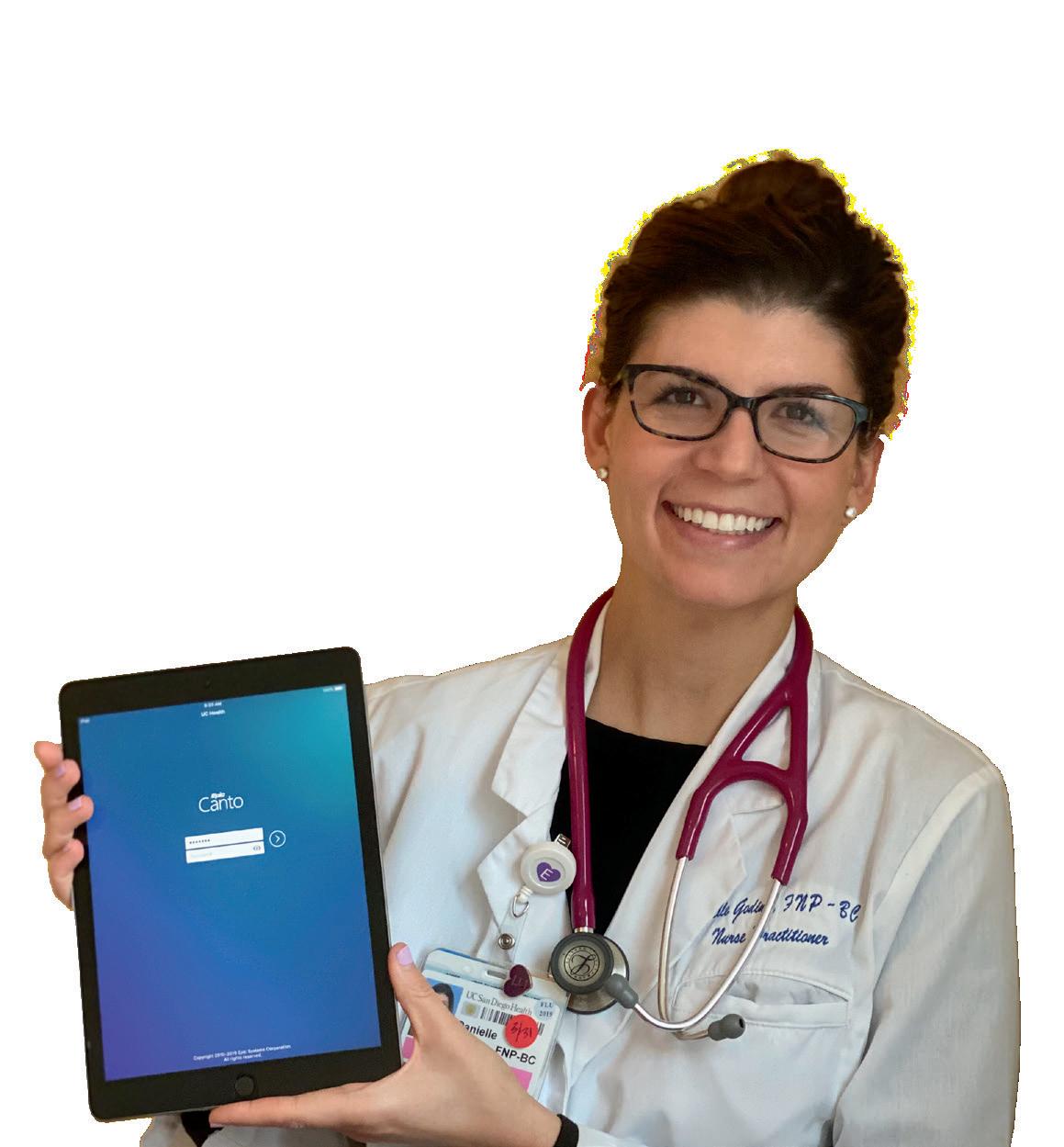
Alfego’s passion for nursing and caring for others could not be made more clear than by her own philosophy.
“I treat every patient as if they were one of my own family members,” she says. “I give them all the time they deserve.”
Alumni Profiles by Dhanika Pineda, a journalist based in Washington, DC. Pineda graduated from UC Irvine's Literary Journalism program and now covers healthcare, race, culture and politics for national print, digital and broadcast media.
Photo courtesy of Danielle Alfego
44 : Humanitas
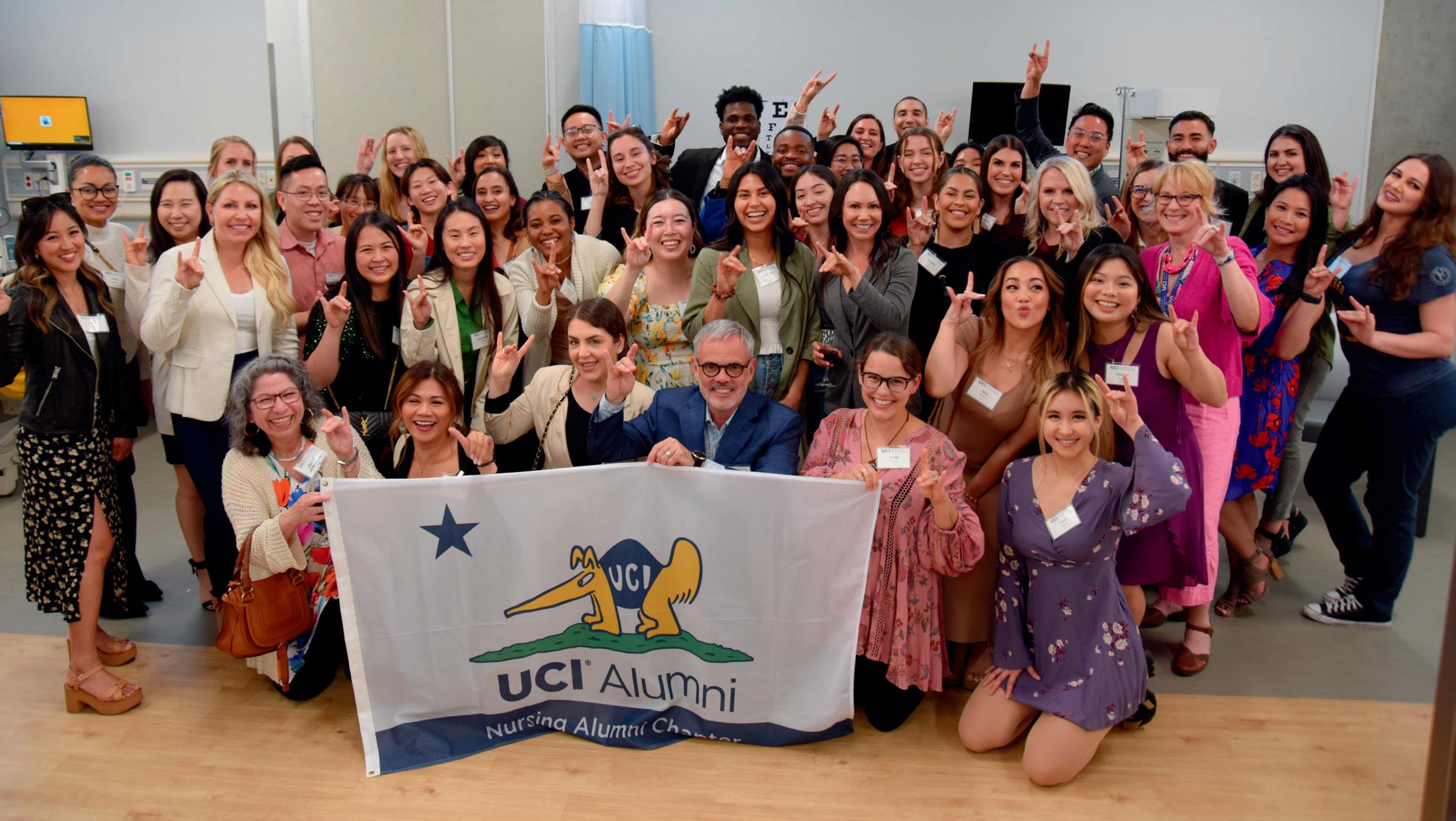
“An
Anteater for Life”
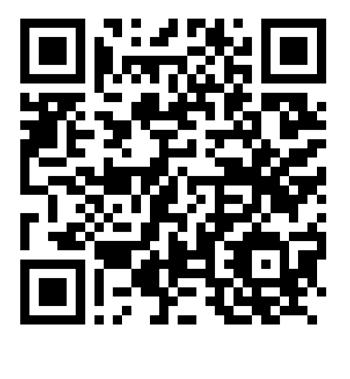

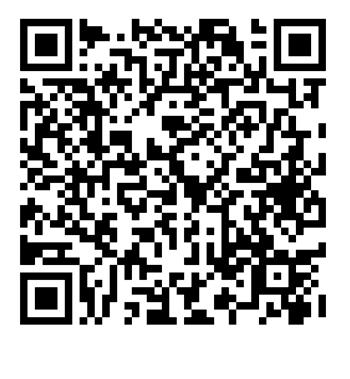
Join the Nursing
Community through connection, service
and leadership. Attend a networking event Mentor a student Make a Gift Join the Nursing Alumni Chapter Board Follow us on Instagram: Apply for our Alumni Board:
Alumni
,
University of California, Irvine
Sue & Bill Gross Nursing and Health Sciences Hall
854 Health Sciences Road Irvine, CA 92697-3959
nursing.uci.edu







 Lazenby, PhD, RN, FAAN Dean and Professor
Lazenby, PhD, RN, FAAN Dean and Professor


 Illustration by Jonathan Rice
Illustration by Jonathan Rice














 Pierson works a day each week at an ALS United integrated clinic, meeting with patients and liaising with colleagues across disciplines.
Pierson works a day each week at an ALS United integrated clinic, meeting with patients and liaising with colleagues across disciplines.











 Justice Eileen Moore, Carol Pierson, and Mary Roosevelt spoke with Humanitas editor Leonie Gombrich.
Justice Eileen Moore, Carol Pierson, and Mary Roosevelt spoke with Humanitas editor Leonie Gombrich.







 By Nicholas Schou
By Nicholas Schou































 Alumnus JohnRey Hassan, from the program’s first cohort of Bachelor of Science graduates, now runs a major healthcare service company in northern California.
Founders and leading advocates of nursing education at the University of California, Irvine. From left: Adey Nyamathi (founding dean), Susanne Phillips, Ellen Lewis, Ellen Olshansky, E. Alison Holman, and Mark Lazenby.
Alumnus JohnRey Hassan, from the program’s first cohort of Bachelor of Science graduates, now runs a major healthcare service company in northern California.
Founders and leading advocates of nursing education at the University of California, Irvine. From left: Adey Nyamathi (founding dean), Susanne Phillips, Ellen Lewis, Ellen Olshansky, E. Alison Holman, and Mark Lazenby.





 Faculty and staff of the Sue & Bill Gross School of Nursing. From left: Assistant Professor Dawn Bounds; Associate Clinical Professor Jocelyn Ludlow, Director of Simulation; Assistant Clinical Professor Shelley Burke; Professor Michelle Fortier; Megan Enciso, Director of Student Affairs and DEIB Initiatives.
Faculty and staff of the Sue & Bill Gross School of Nursing. From left: Assistant Professor Dawn Bounds; Associate Clinical Professor Jocelyn Ludlow, Director of Simulation; Assistant Clinical Professor Shelley Burke; Professor Michelle Fortier; Megan Enciso, Director of Student Affairs and DEIB Initiatives.



 Sue Gross with Dean Mark Lazenby.
The tour of the simulation center continues. Is that an issue of Humanitas lying on the manikin’s table?
Sue Gross with Dean Mark Lazenby.
The tour of the simulation center continues. Is that an issue of Humanitas lying on the manikin’s table?














